Early Views of the San Fernando Valley
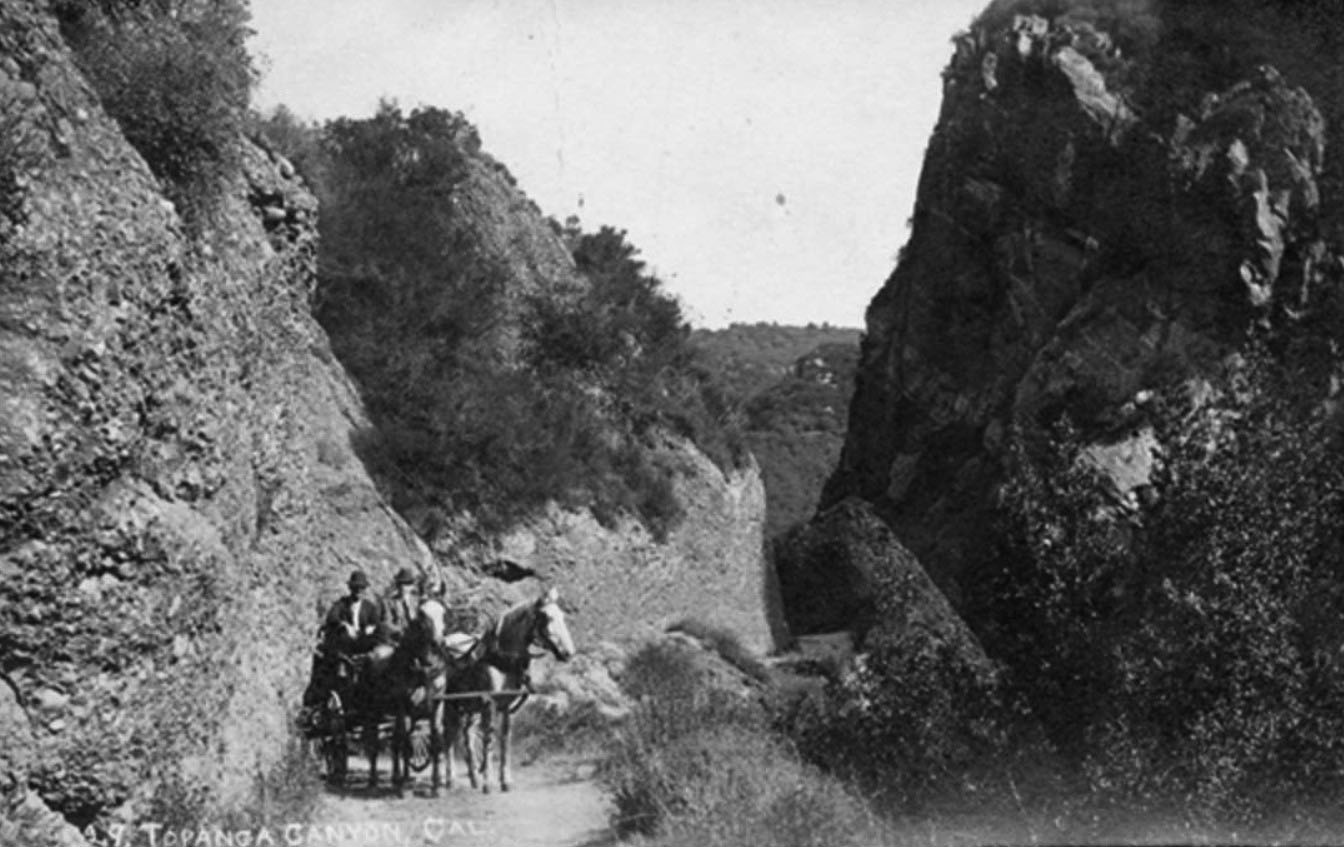 |
|
| (1909)^ - A photographic postcard of Topanga Canyon showing the grade above the spring in 1909. Jack Woods and stage with Joe Robinson driving. |
Historical Notes Jack Woods, a pioneer stage and mail driver, built what is thought to be the oldest inhabited structure in Topanga Canyon. The stone cabin on Old Canyon property was later the Frederick Mezet ranch and winery. Since then, the property was bought and sold about ten times. Its owners and tenants included John Bonnell, a real estate developer who subdivided a portion of the property, which he named Topanga Park and was later known as Bonnell Park or Bonnell Flats. Rock star Neil Young was a 1960s tenant. His famous three-day party there resulted in the arrest of Young, as well as Eric Clapton, and led to the breakup of Young’s group, Buffalo Springfield.** |
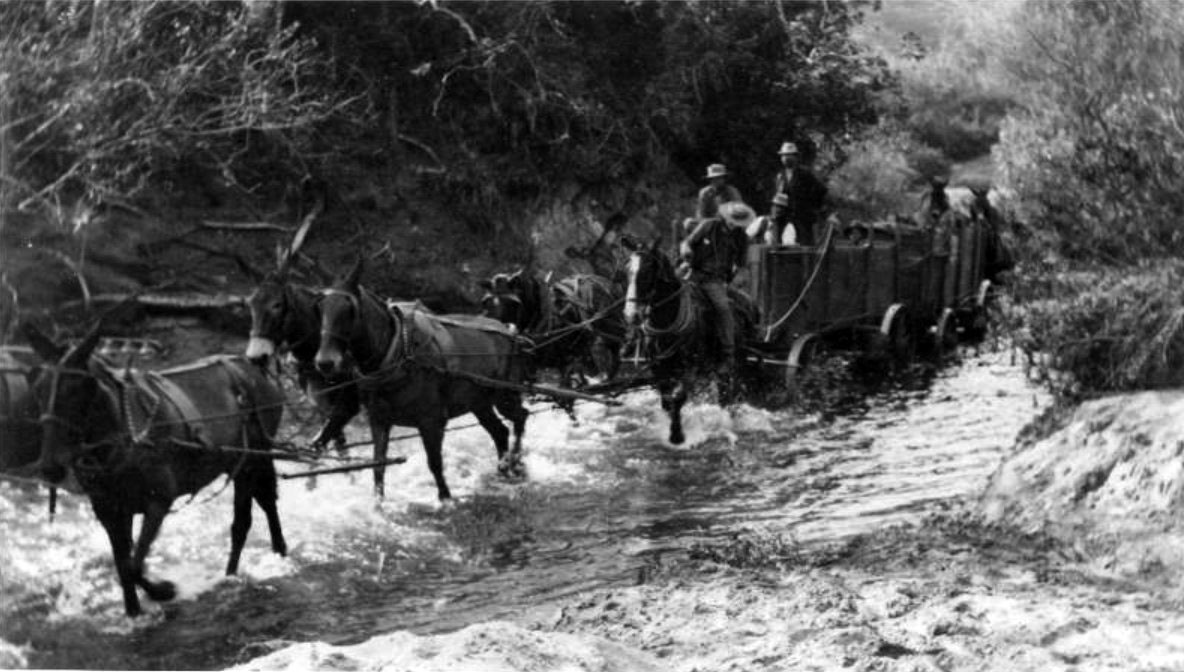 |
|
| (ca. 1913)*#^* - After a day of building roads in Topanga, contracted mule and wagon teams followed the creek bed to the beach. |
Historical Notes Topanga is the name given to the area by the Native American indigenous Tongva tribe, and may mean "a place above". It was the western border of their territory, abutting the Chumash tribe that occupied the coast from Malibu northwards. Bedrock mortars can be found carved into rock outcroppings in many locations.*^ |
Topanga Canyon Road
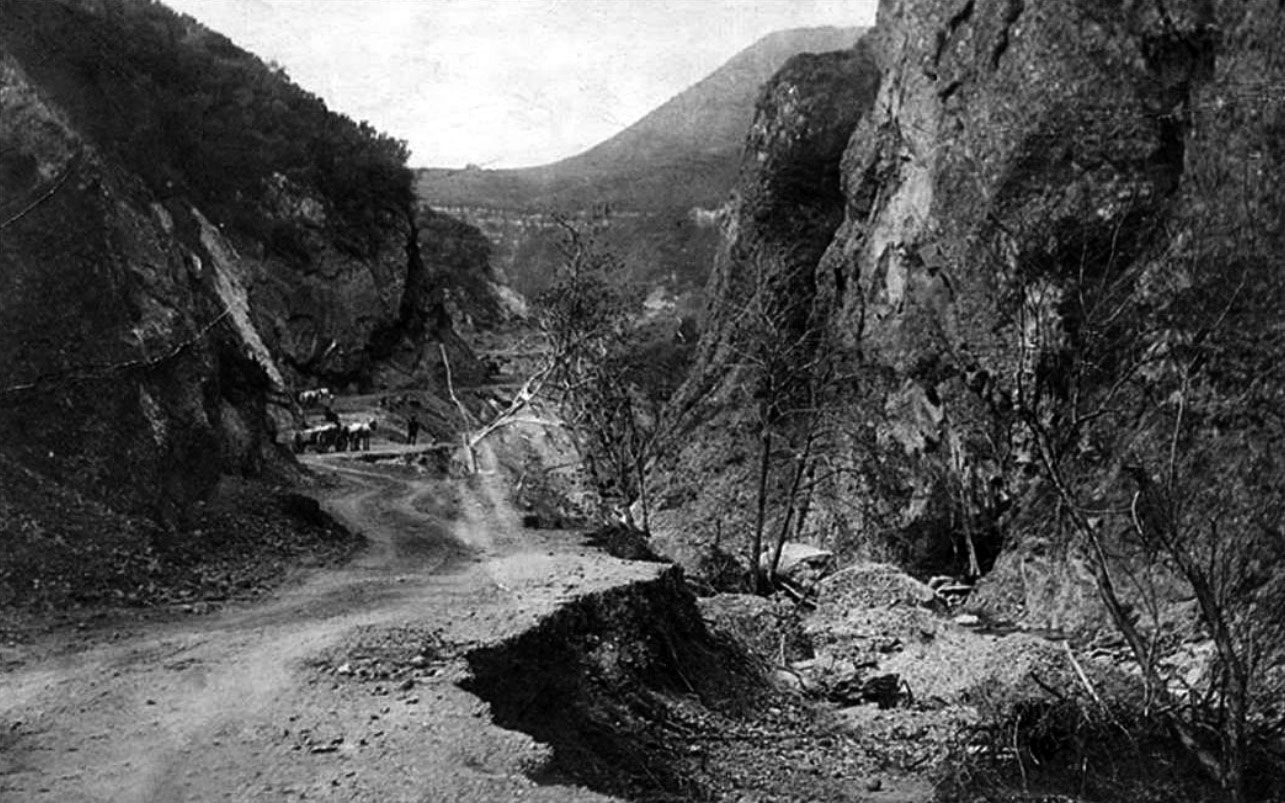 |
|
| (Early 1900s)#^*^ – View of Topanga Canyon Road under construction. Photo credit: Laura B. Gaye, from her book "Land of the West Valley." |
Historical Notes Topanga was first settled in 1839 by the Trujillo and Cheney families. Much later, during the 1920s, it gained popularity with the denizens of Hollywood. As an ideal getaway not far from urban conveniences, it was the perfect site for weekend cottages, which actors and other industry people built there at the time.^^*# |
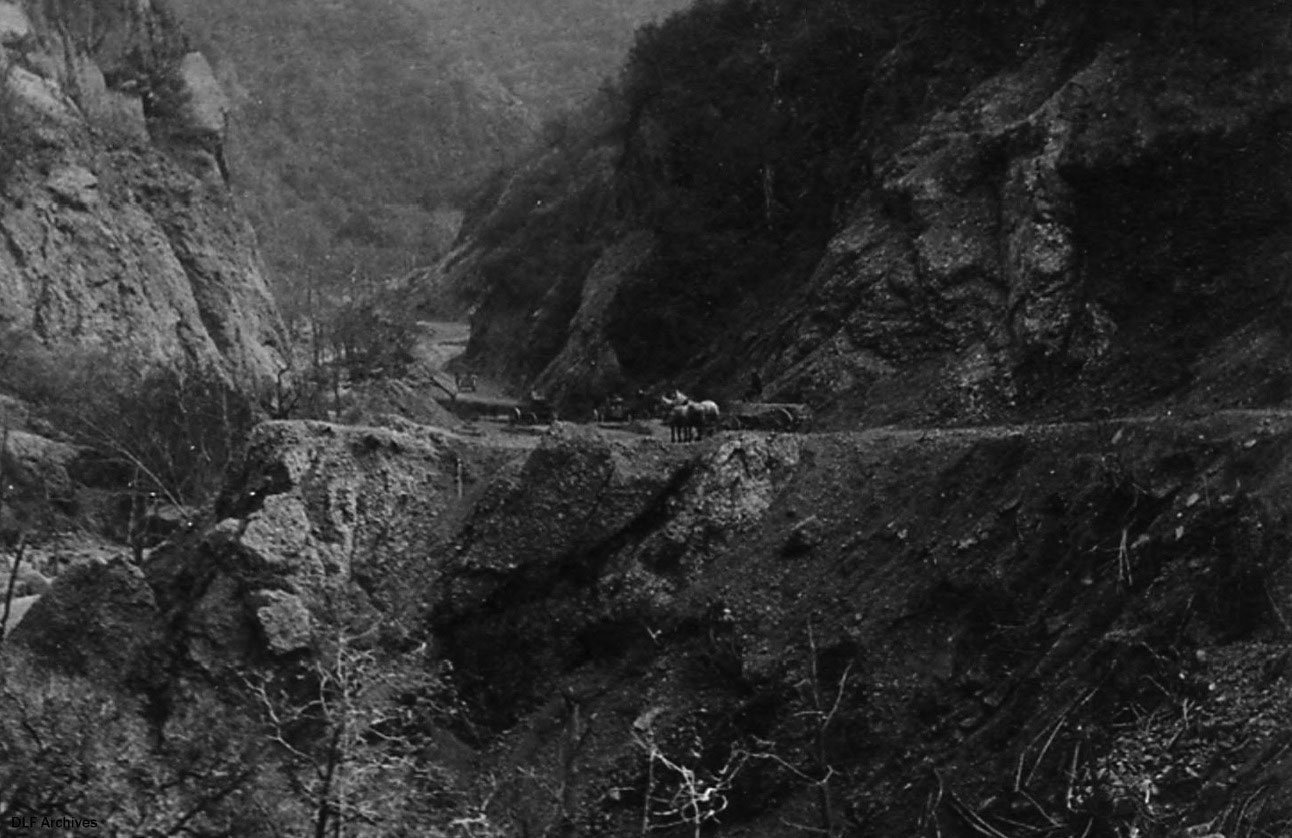 |
|
| (1910s)* – View showing the rugged Topanga Canyon Road before any railing. Note the horse-drawn wagon sharing the road with early model cars. |
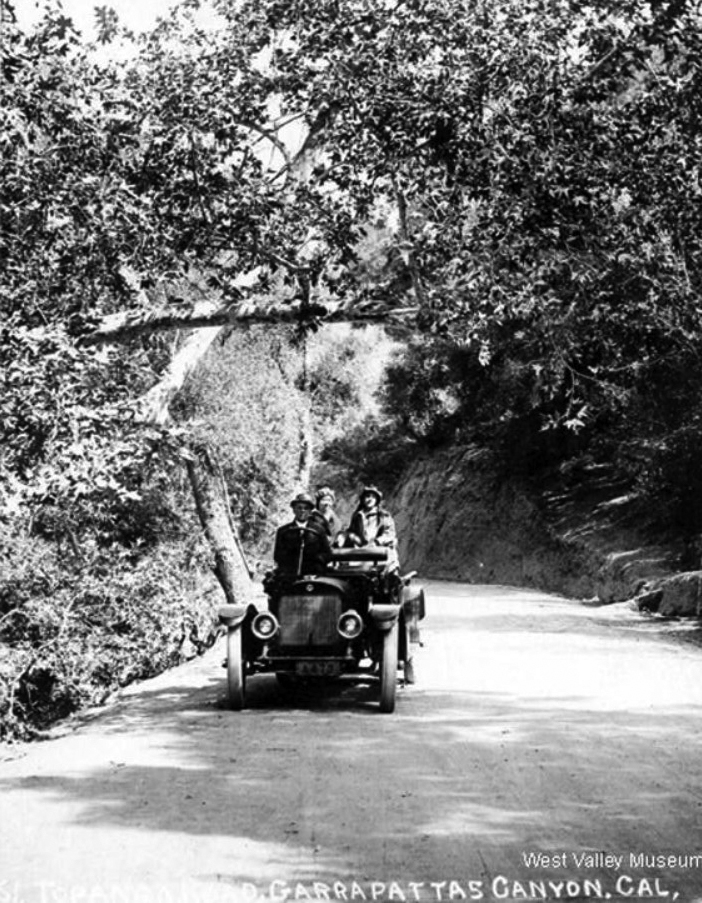 |
|
| (ca. 1914)#^ - Travelers on Topanga Canyon Road near Garrapattas Canyon. Photo Courtesy: West Valley Museum |
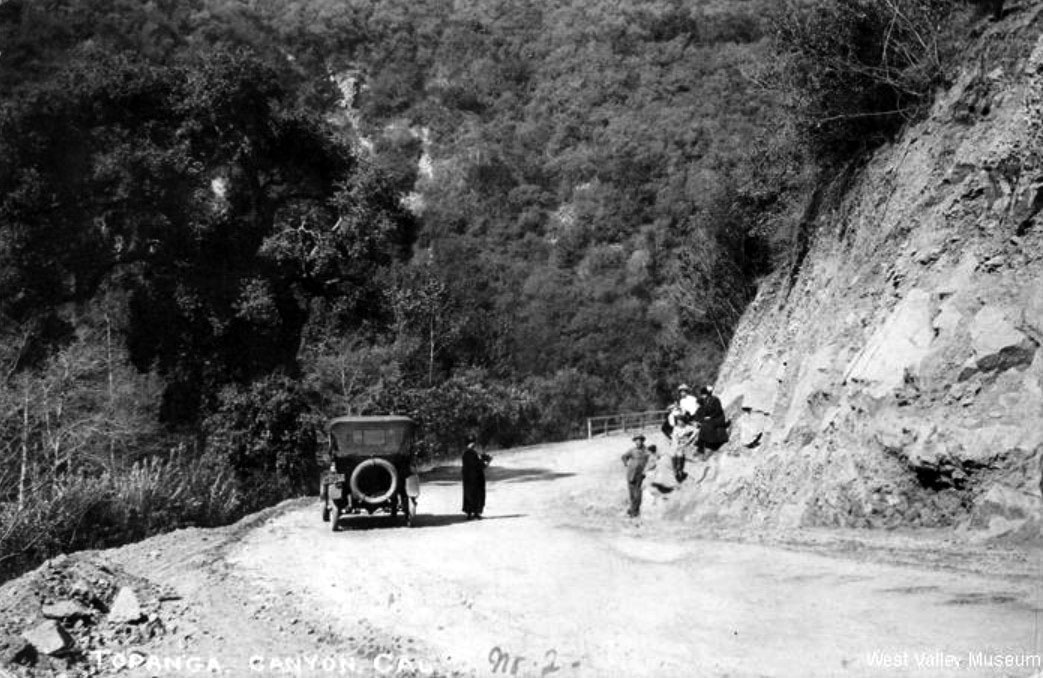 |
|
| (ca. 1915)^ - Family outing in Topanga Canyon. Photographer: H. F. Rile. Photo courtesy of West Valley Museum. |
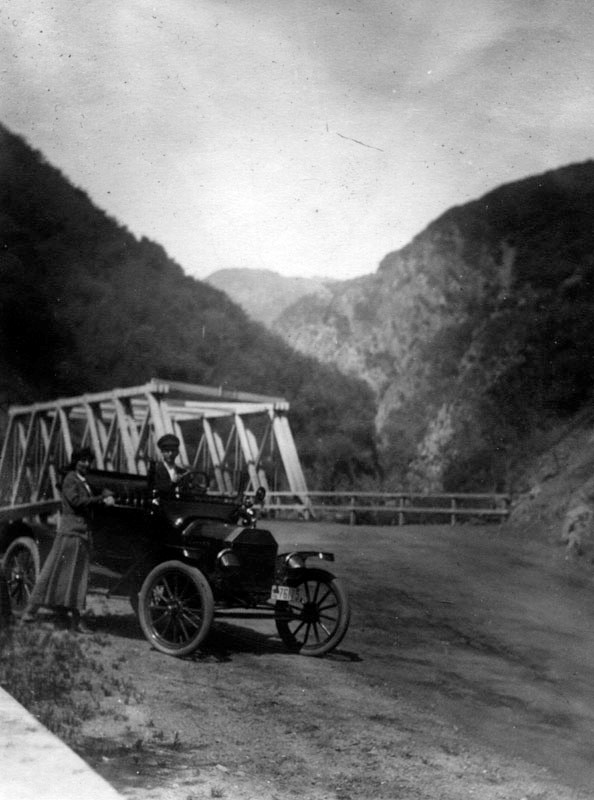 |
|
| (ca. 1915)* – View showing a couple posing for the camera with their Ford Model T on Topanga Canyon with newly constructed bridge seen behind them. |
Historical Notes The location of this photo is about two miles up the canyon from Topanga State Beach. The bridge in the photo, along with a handful of others, was built across Garrapata Creek when the road opened up for automobile traffic in 1915. Click HERE to see this same bridge in 1938 on the cover of a December 1938 California Highways publication. |
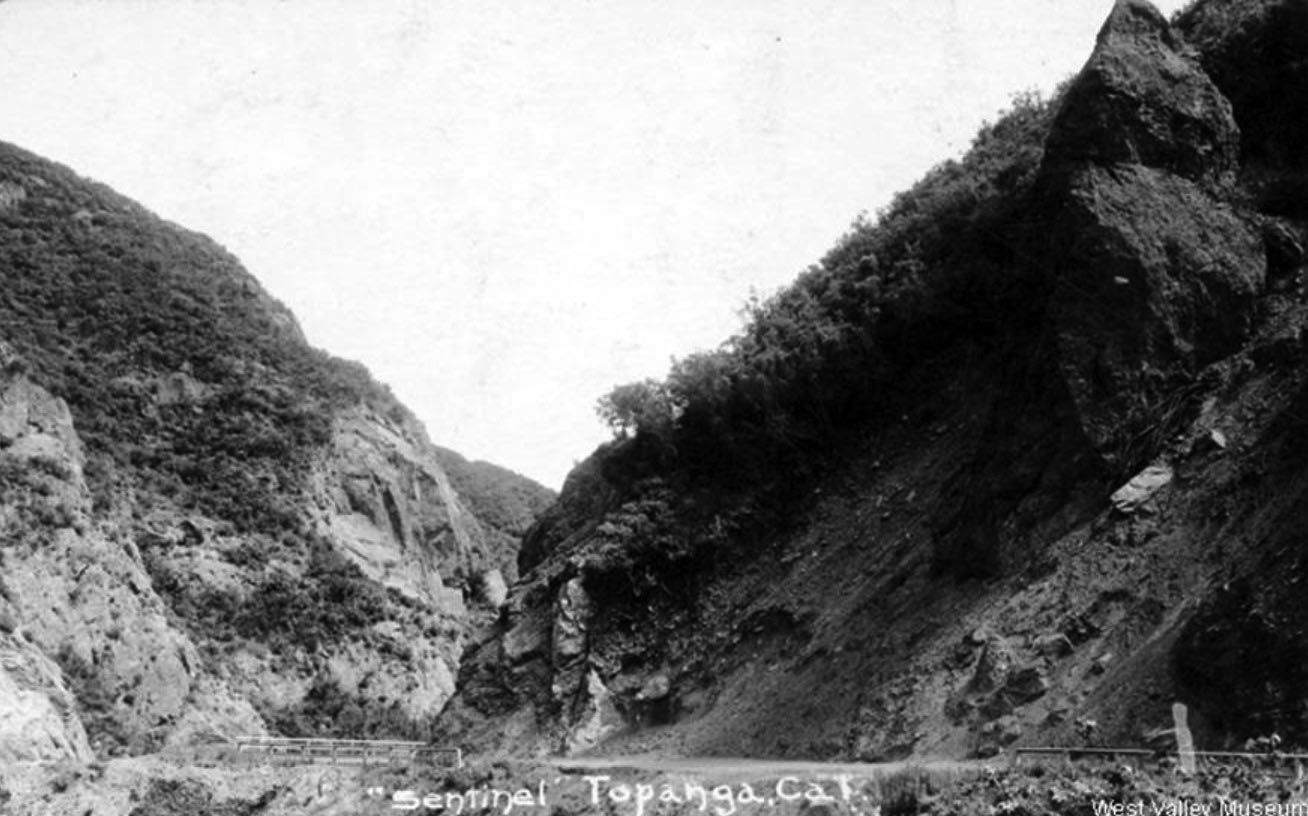 |
|
| (ca. 1920)^ – Postcard view showing Sentinel Rock (visible at upper right corner), also known as Pyramid Rock, overhanging Topanga Highway. Concern for the safety of passing motorists on the highway led to the removal of this landmark by demolition in the late 1920s. This postcard is postmarked February 20, 1920. |
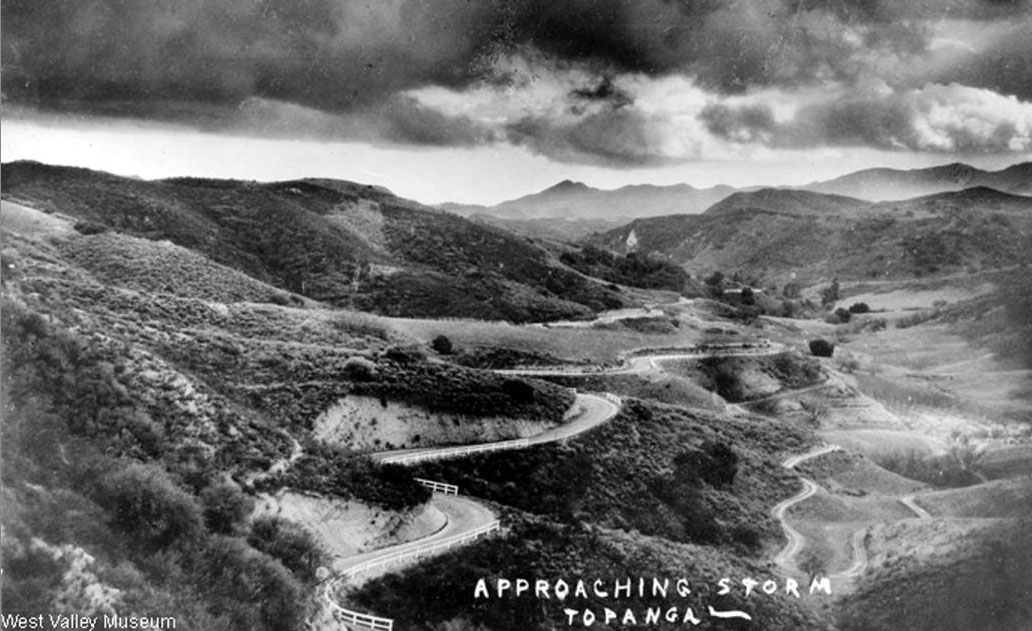 |
|
| (1921)^ – Panoramic view showing Topanga Canyon Road winding its way through the Santa Monica Mountains. Clouds gather above as a storm approaches. |
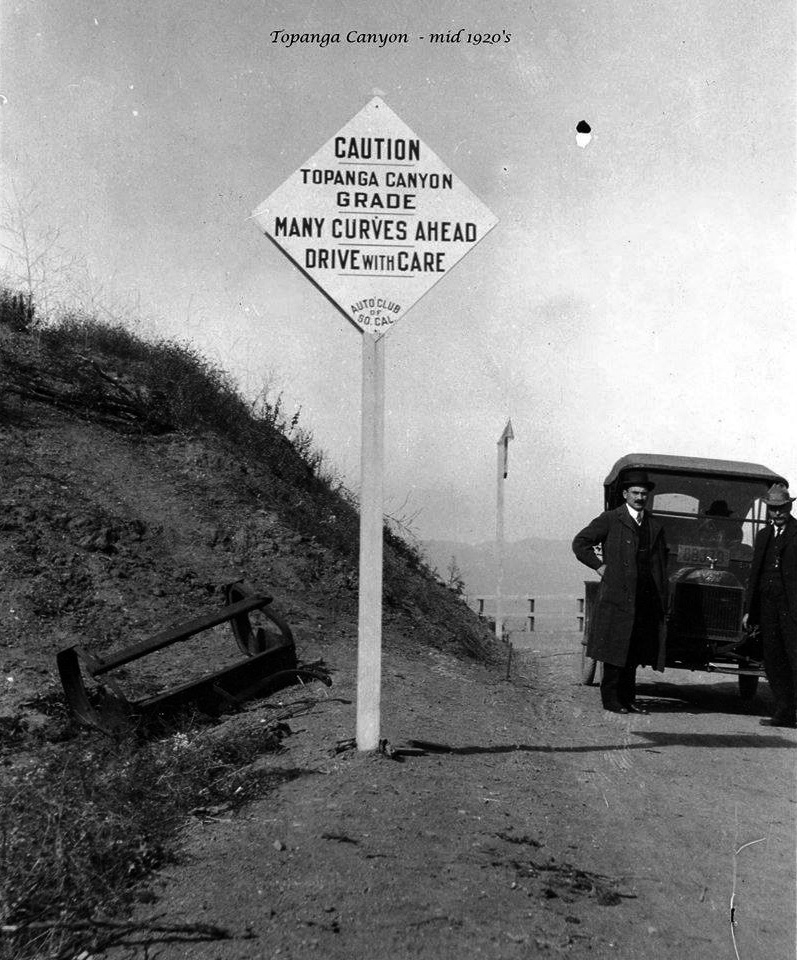 |
|
| (1920s)^ – Two men stop there car in front of a sign on Topanga Canyon Drive. Sign reads: CAUTION – Topanga Canyon Grade – Many Curves Ahead – Drive with Care - Auto Club of So. Cal. |
Historical Notes The first road through Topanga Canyon opened in 1915. The road was an adventure to drive, with a few hundred turns to navigate before arriving at the other end. In 1925, officials began studying how to alter the road for easier travel, with actual restructuring occurring in 1930. |
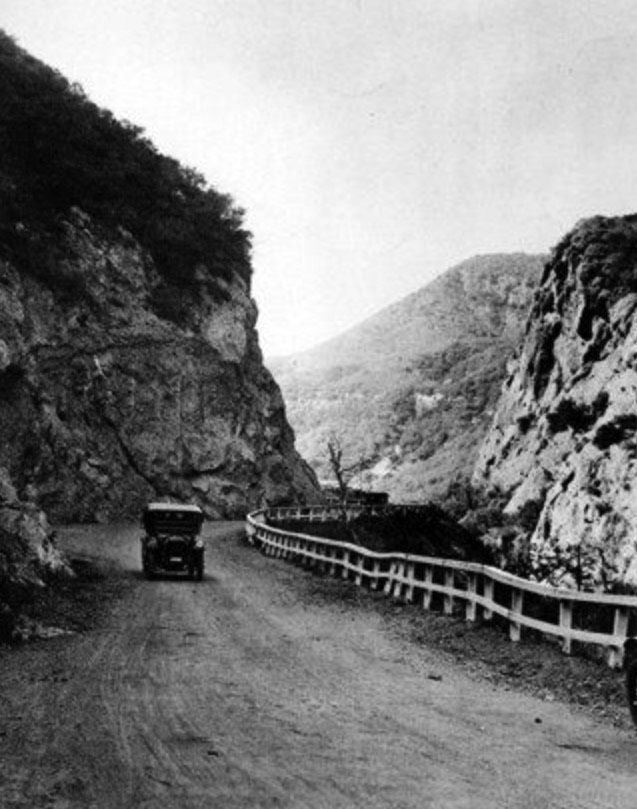 |
|
| (ca. 1920s)*^*# – View showing an early model car making its way up an unpaved Topanga Canyon Road. |
Topanga Canyon Summit
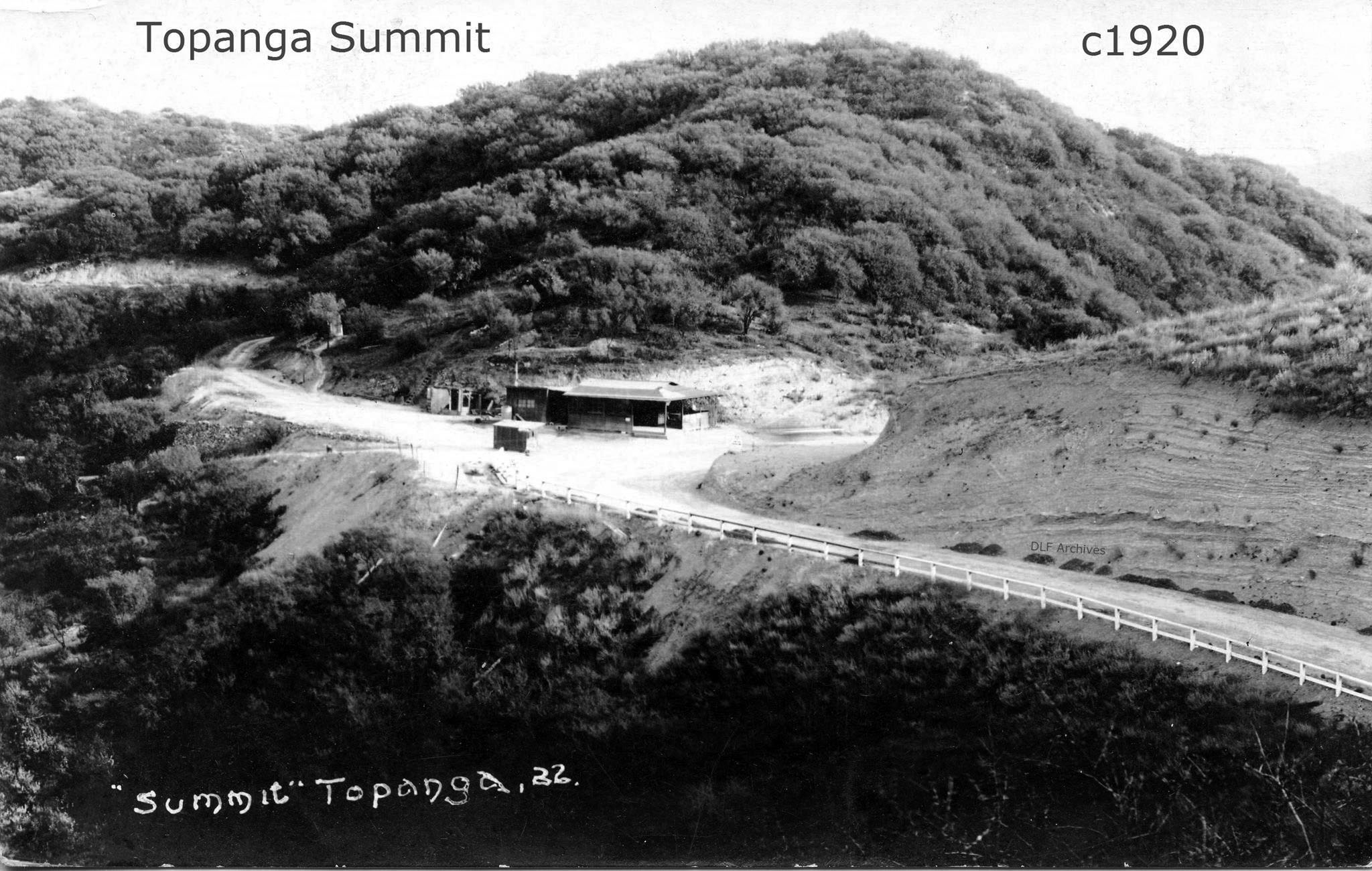 |
|
| (ca. 1920)#^*^ – Postcard view showing Topanga Summit. At center stand several buildings, possibly including a food stand. |
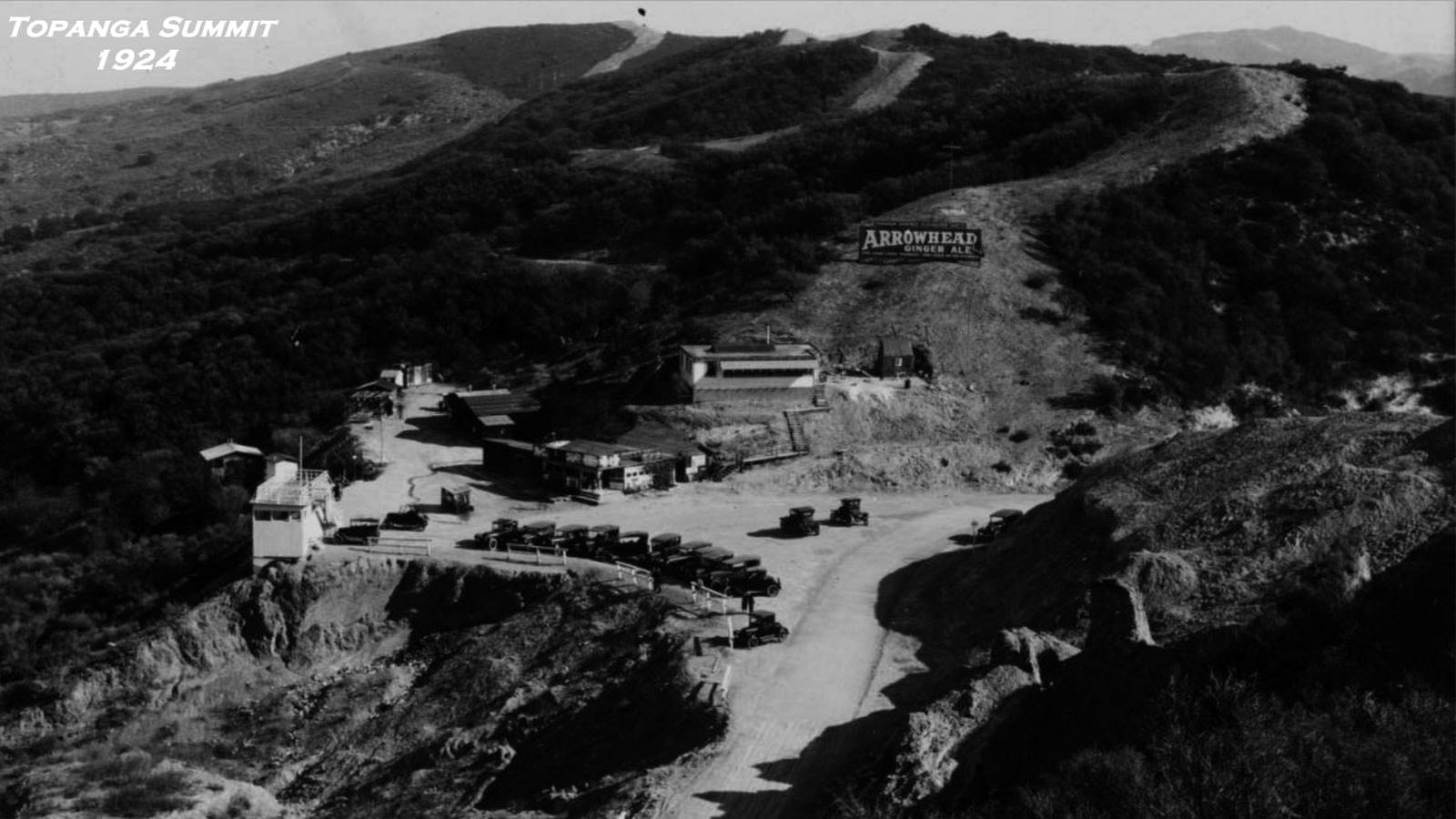 |
|
| (1924)#* – View looking southerly at the Topanga Summit. Cars are lined up along the railing to get a good view of the San Fernando Valley. |
 |
|
| (ca. 1920)^*^*^ – View showing a full parking lot at the Topanga Canyon Summit. To the left is a two-level structure with a viewing platform on top. At right is a large billboard perched on the hillside reading: “Arrowhead Ginger Ale”. At center stand several buildings, including a food stand. |
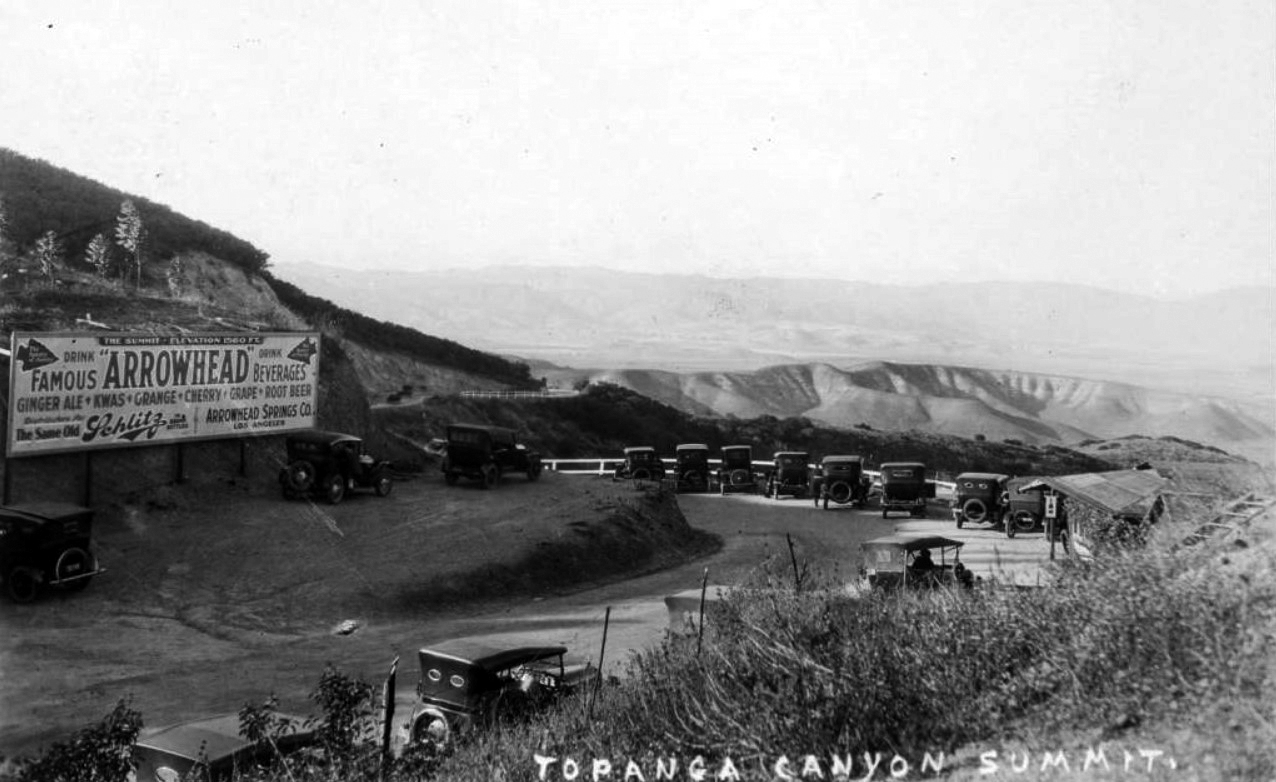 |
|
| (ca. 1920)#* - Image showing automobiles parked at the Topanga Canyon Summit, with a view of the San Fernando Valley. A sign at left reads "The summit elevation 1560 ft." and "Drink famous Arrowhead beverages... Distributed for the same old Schiltz in brown bottles. Arrowhead Springs Co., Los Angeles." |
 |
|
| (1920s)#^*^ – Postcard view showing Bailey’s at Summit of Topanga Canyon serving “Good Old Eastside – The Perfect Brew”. |
Historical Notes Eastside was a Los Angeles beer in the early 1900s, brewed by the Los Angeles Breweing Company (later Eastside Brewing Co.). It was called Eastside because the brewery was located on the east side of the Los Angeles River. Click HERE to see more. |
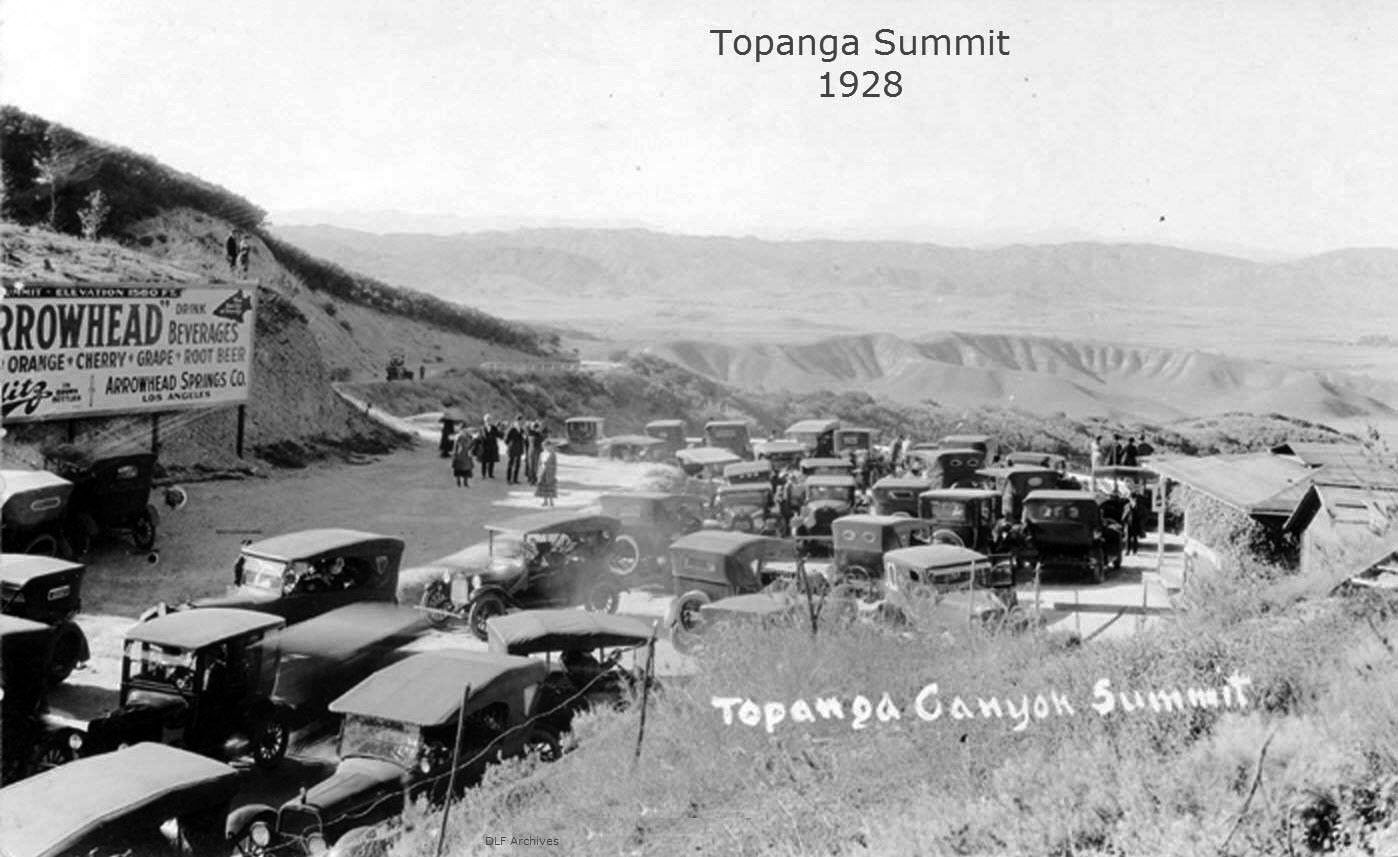 |
|
| (1928)#^*^ – Topanga Summit without hardly a parking spot to be had. The refreshments stand is to the right. |
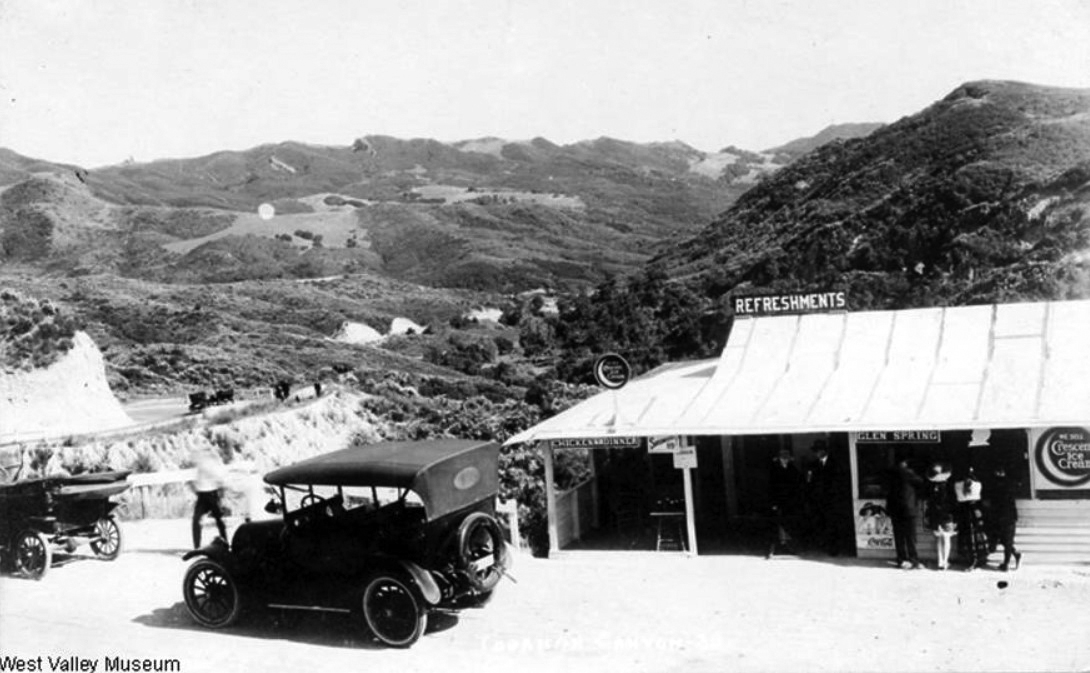 |
|
| (ca. 1920)#^ - View of a food stand in Topanga Canyon with large sign on the roof reading: “Refreshments”. The sign above the front counter reads “Glen Spring” and the type of ice cream they're selling is called “Crescent Ice Cream”. |
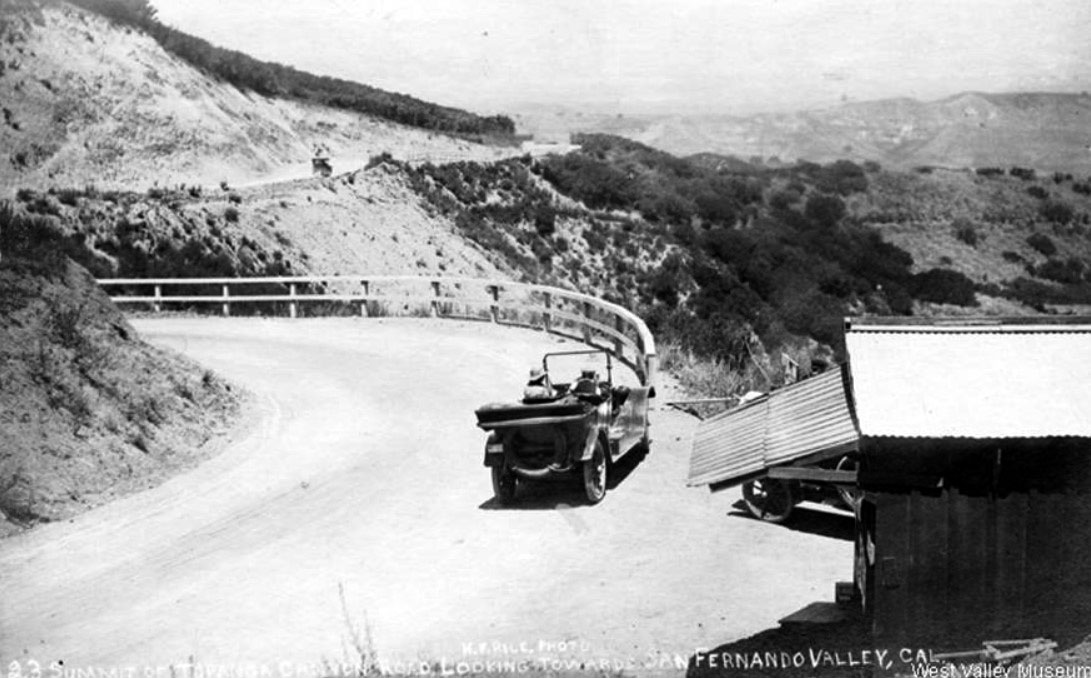 |
|
| (ca. 1920)#^ - Postcard view showing two people sitting in a car at the Summit of Topanga Canyon Road looking out towards the San Fernando Valley. |
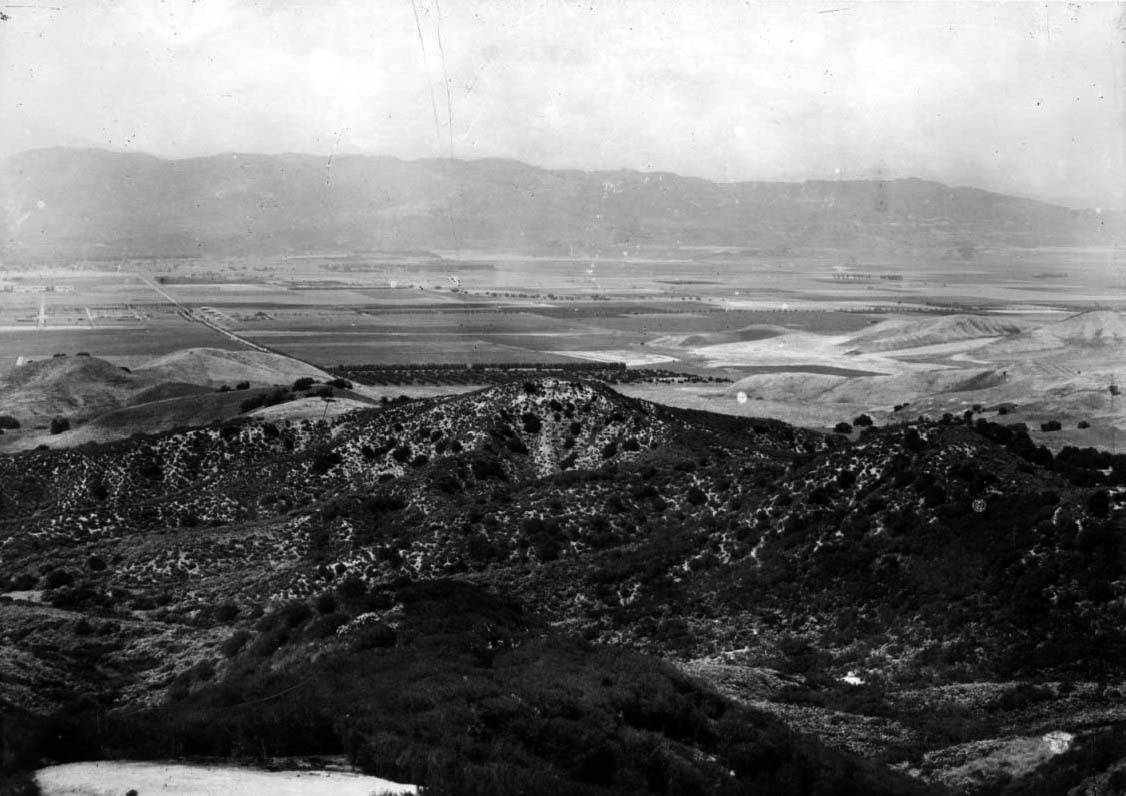 |
|
| (ca. 1914)^^ – Birdseye view of San Fernando Valley from near Topanga Canyon Road. The wide, flat valley is in the distance at center and is divided into many large farm plots. A small orchard is visible at center and a road cuts through the valley at left. |
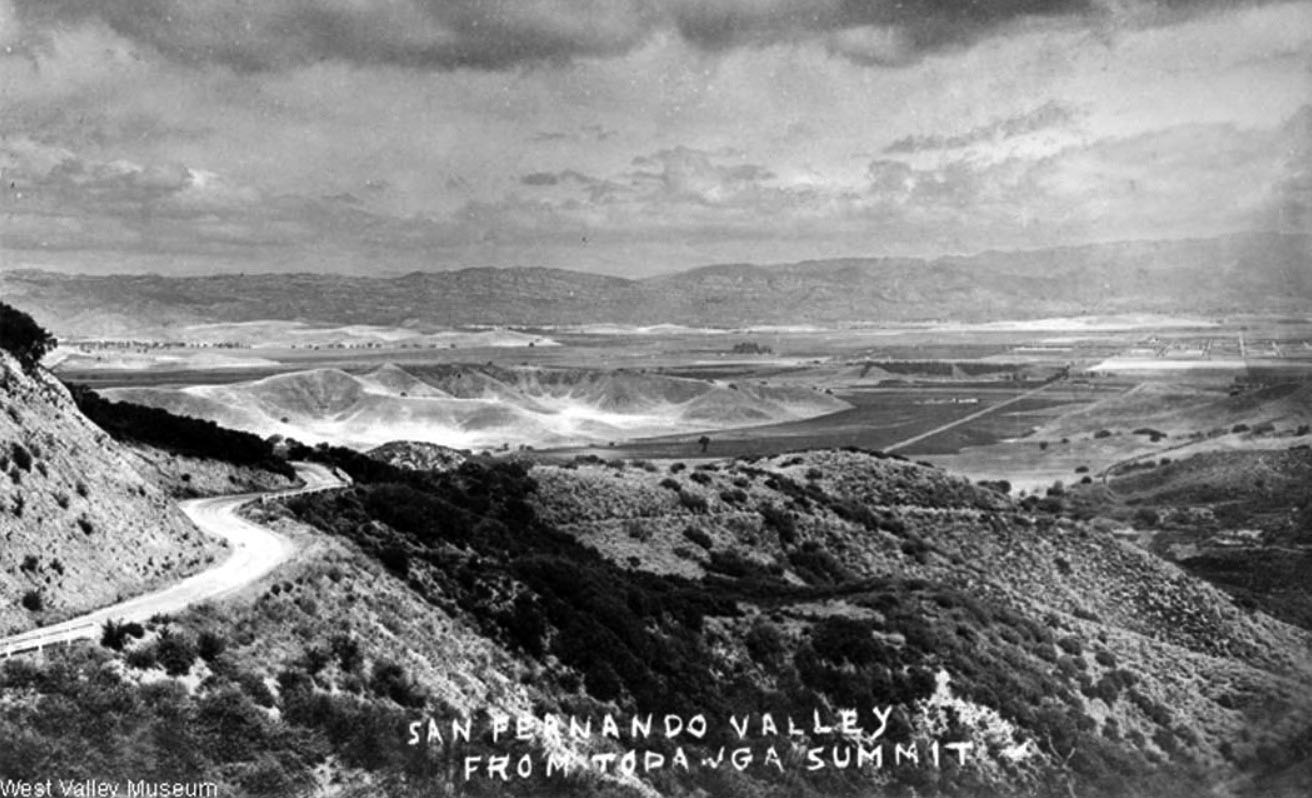 |
|
| (ca. 1920)^ - Panoramic view showing the San Fernando Valley from the Topanga Summit. Wide open spaces are seen below with little or no development. |
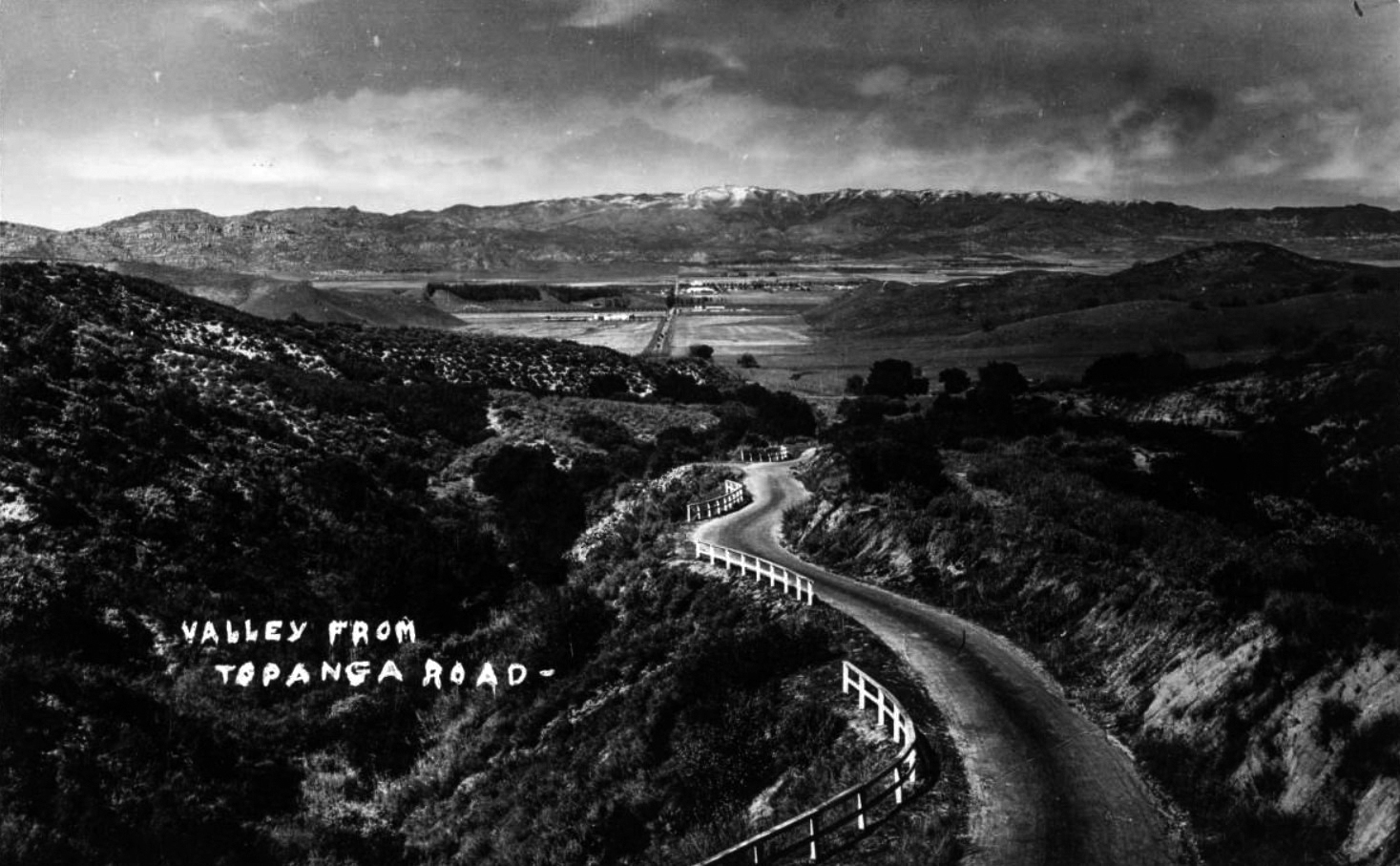 |
|
| (ca. 1920)#* – View of the San Fernando Valley as seen from Topanga Canyon Road with little or no development down below. |
Girard (now Woodland Hills)
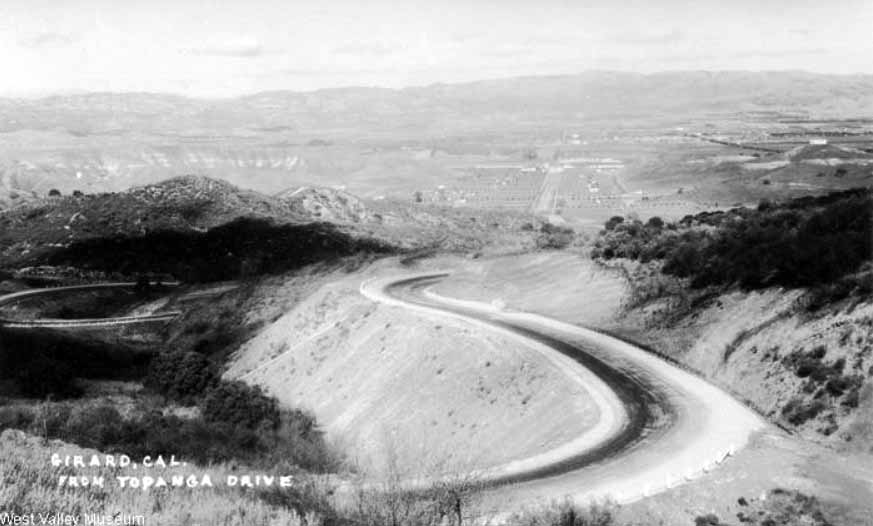 |
|
| (ca. 1922)#^ - View of the San Fernando Valley from Topanga Canyon Drive showing some early signs of development in what was then known as the town of Girard (now Woodland Hills). |
Historical Notes Victor Girard Kleinberger bought 2,886 acres in the area from Chandler's group and founded the town of Girard in 1922. He sought to attract residents and businesses by developing an infrastructure, advertising in newspapers, and planting 120,000 trees. His 300 pepper trees forming an arch over Canoga Ave. between Ventura Boulevard and Saltillo St. are Los Angeles Historic-Cultural Monument #93 in 1972. The community of Girard was eventually incorporated into Los Angeles, and in 1945 it became known as Woodland Hills.*^ |
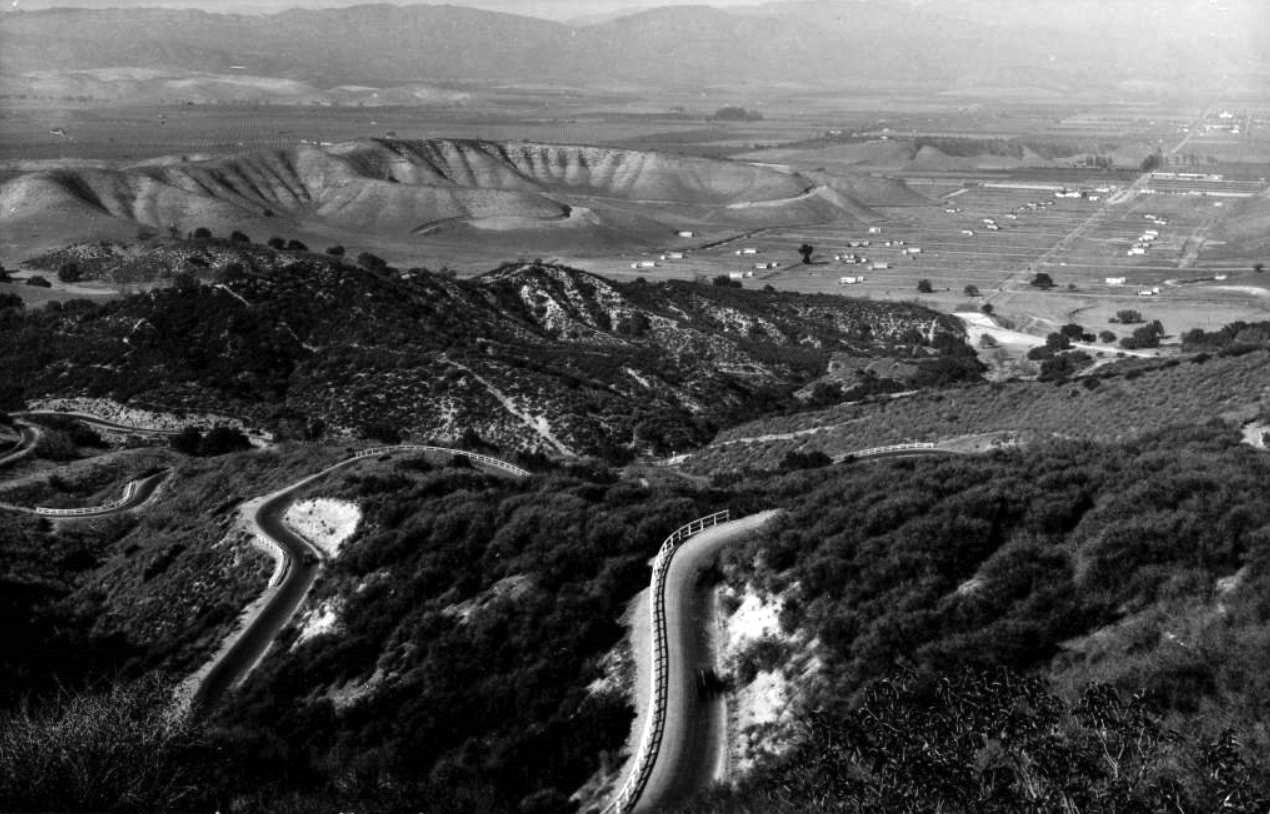 |
|
| (1922)#* - View of Girard and Owensmouth in the West San Fernando Valley, looking north from the summit of Topanga Canyon Highway. The canyon road leads to the San Fernando Valley, showing houses and trees in an open landscape. The town called Girard became present-day Woodland Hills. Ernest Marquez Collection |
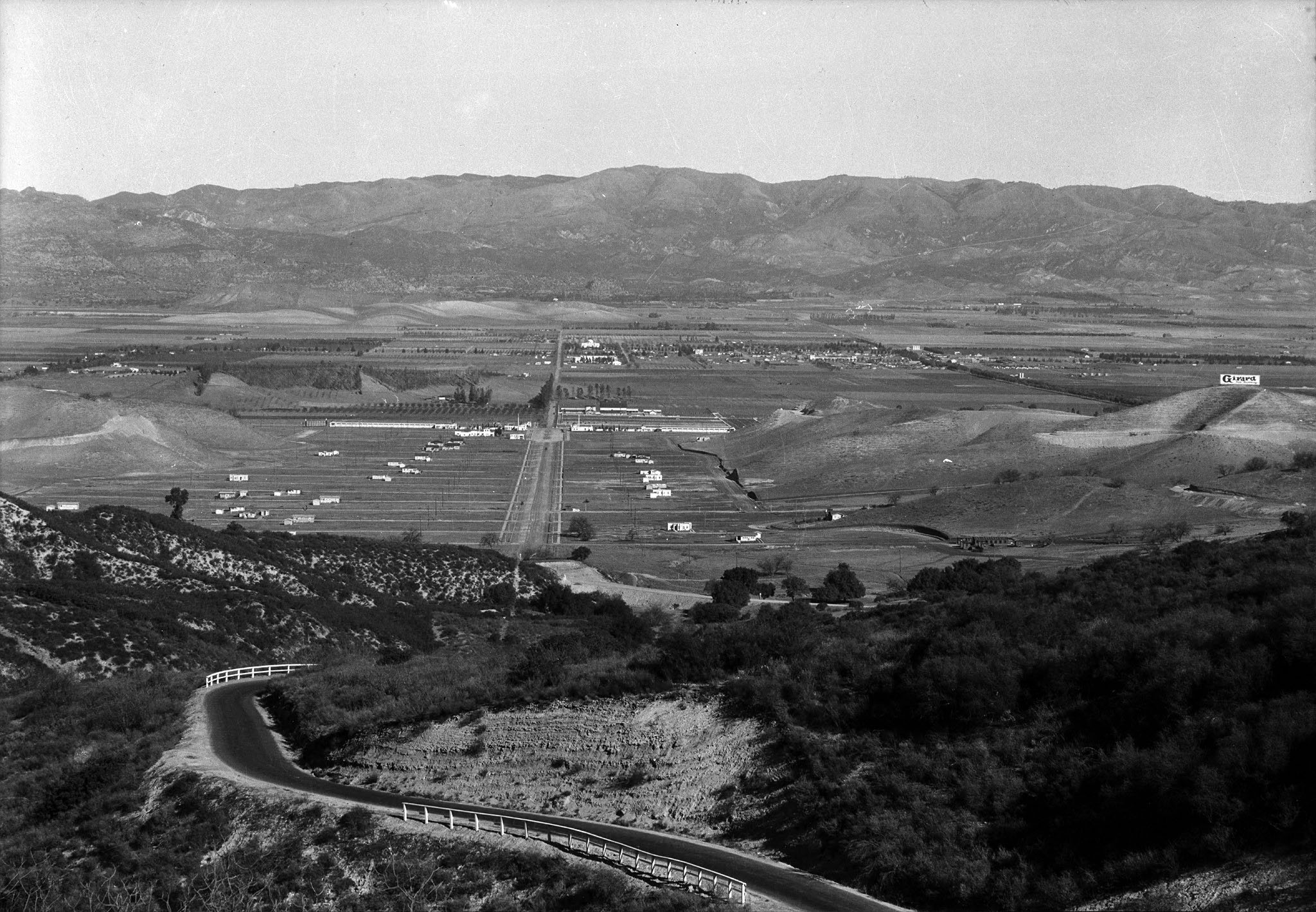 |
|
| (ca. 1922)^.^ - View looking out toward the San Fernando Valley with Topanga Road in the foreground. In upper-right can be seen a very large sign on top of a hill (Chalk Hill). The sign reads “Girard”. Photo C.C. Pierce. |
Historical Notes The town Girard was founded in 1923 and named after its developer, Victor Girard Kleinberger. By 1941, the community was renamed Woodland Hills. |
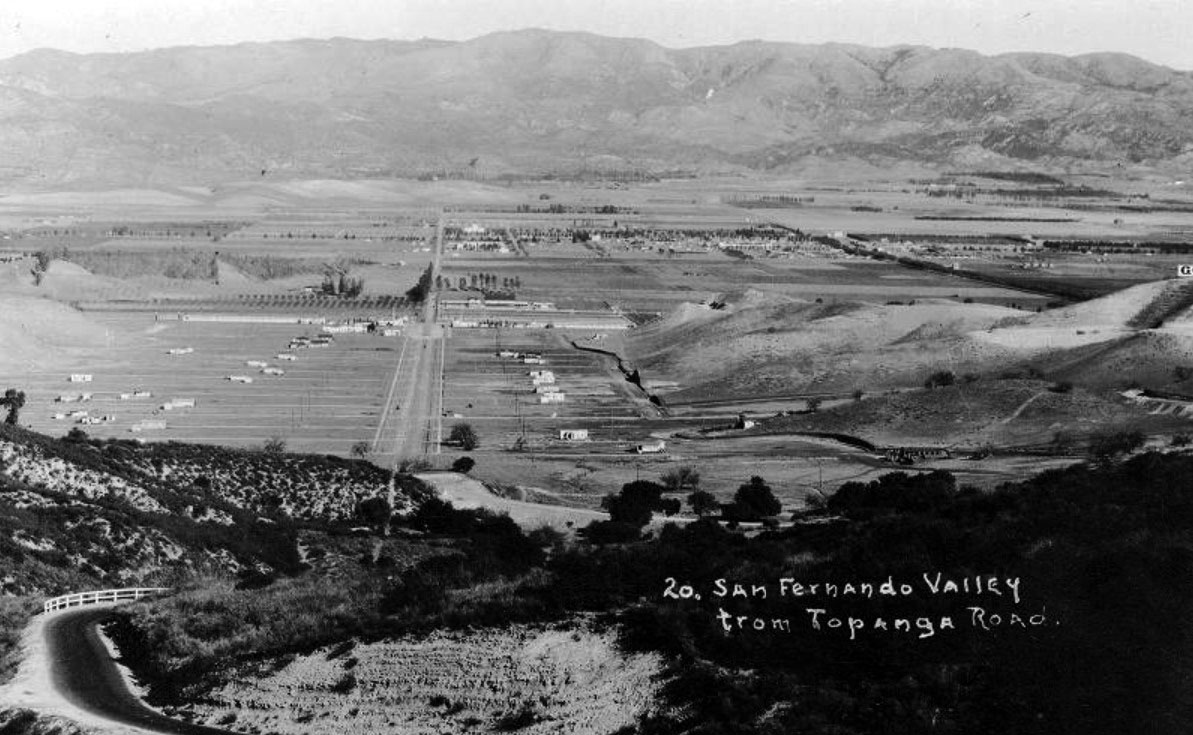 |
|
| (ca. 1922)*#^* - Closer view of the San Fernando Valley from Topanga Road. Photo taken in the early stages of Girard's development. |
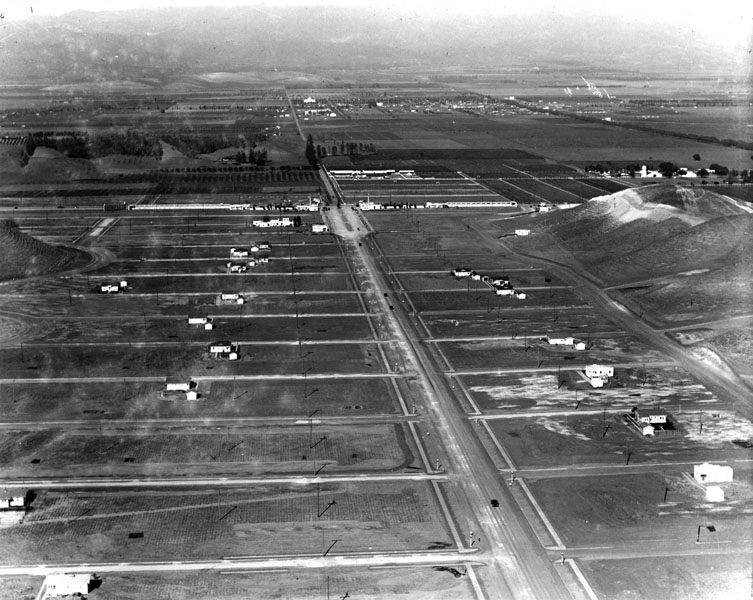 |
|
| (1924)^ - Aerial view looking north on Topanga Canyon Boulevard, Girard (later Woodland Hills). The intersection of Ventura Blvd and Topanga Cyn can be seen at upper-center where the road widens and has a center median. Brant Ranch is at upper-right. |
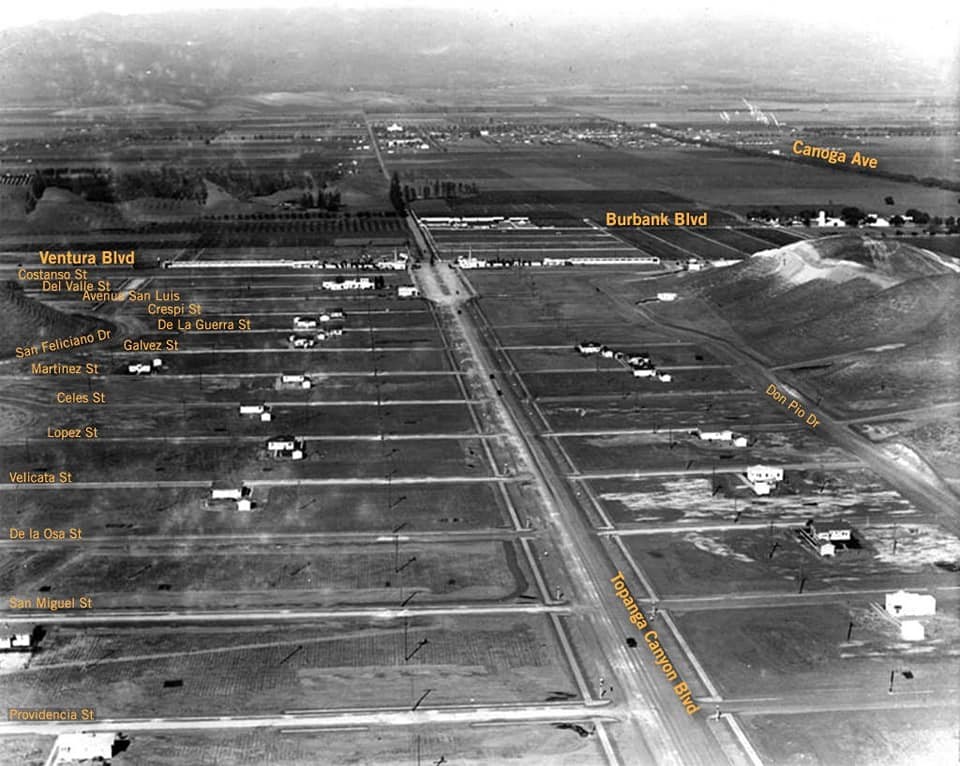 |
|
| (1924)^.^ - Same as previous photo but annotated to show street names. Courtesy of Bill Klea |
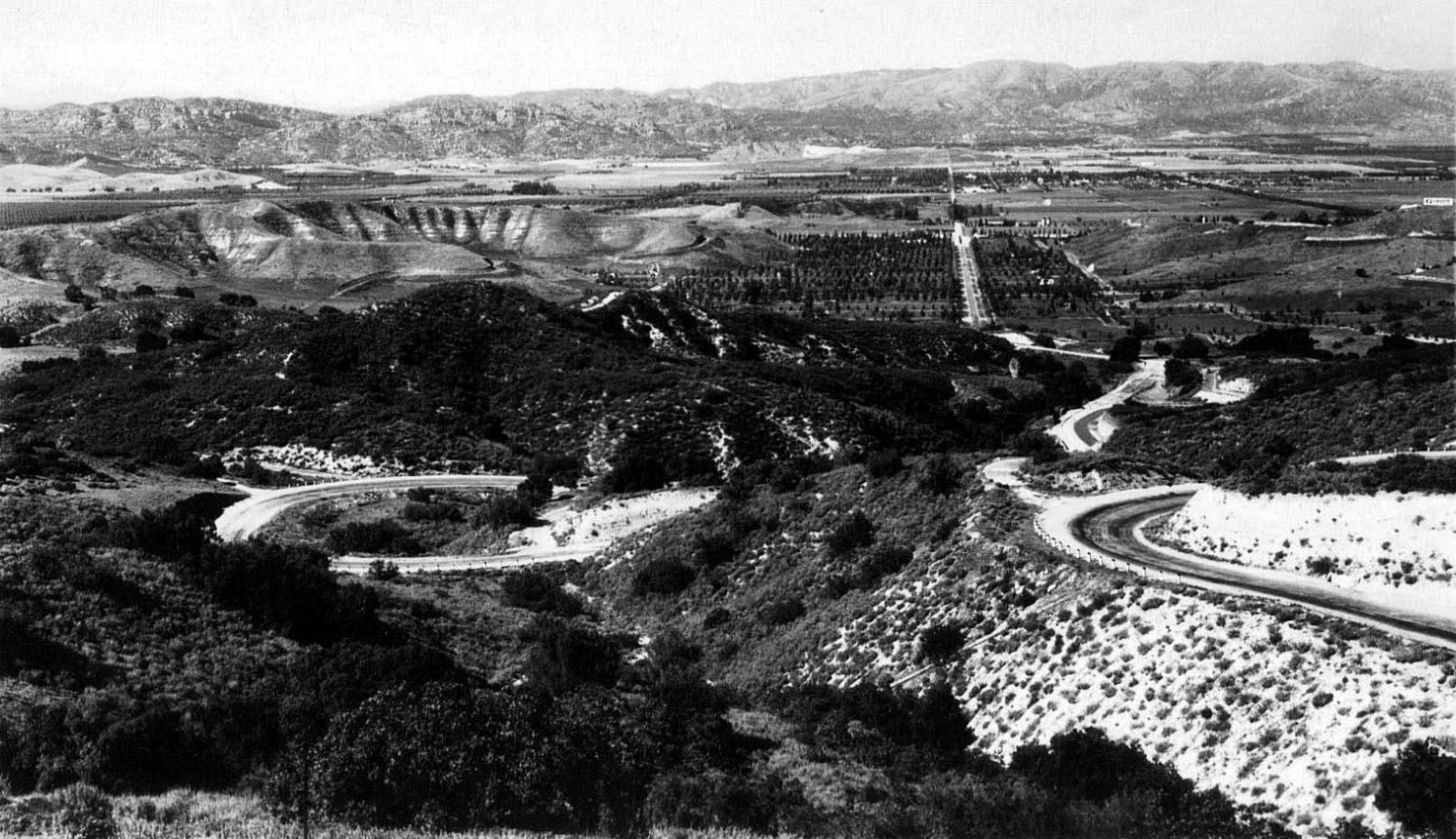 |
|
| (late 1920s)#^# – Postcard view of Girard and the San Fernando Valley from Topanga Canyon Road. Note the hundreds of new trees at upper center-right that Victor Girard planted for his new development. |
Historical Notes Victor Girard is credited for planting more than 120,000 sycamores, eucalyptus, fir pine, and pepper trees across the townsite for which Woodland Hills would later be named for. #*#* Click HERE to see more in Early Views of Girard. |
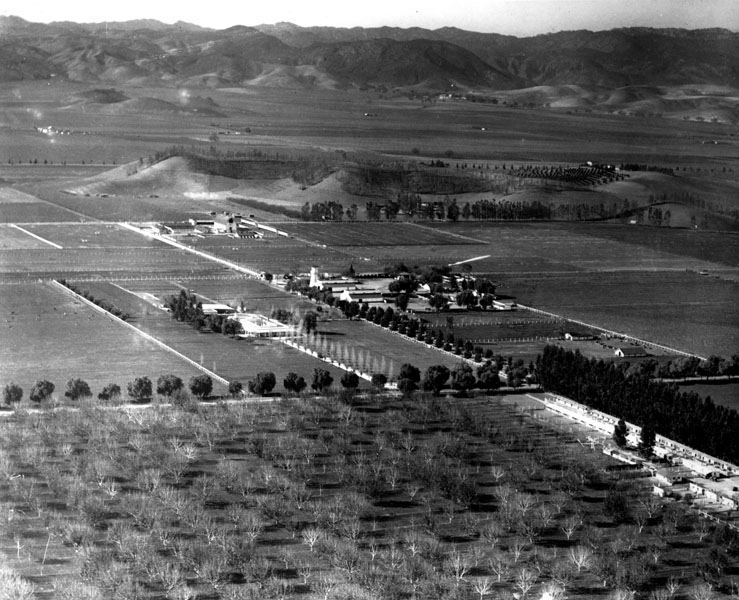 |
|
| (ca. 1920s)* - Aerial view of Owensmouth just north of Girard (now Woodland Hills/Warner Center) looking northwest. Brant Ranch is seen at center of photo. Oxnard Street runs diagonally from lower-right to upper-left. Tree-lined Canoga Avenue runs from left to right in the foreground. |
Historical Notes The area was originally named Owensmouth by Los Angeles Suburban Home Company's general manager, Hobart Johnstone Whitley, with a real estate salesman's exaggeration that it was the new mouth of the Owens River, after the Los Angeles Aqueduct would be completed the next year. The town was founded on March 30, 1912, and the Suburban Home Company contracted with the Janss Investment Company, to sell properties.*^ |
Owensmouth
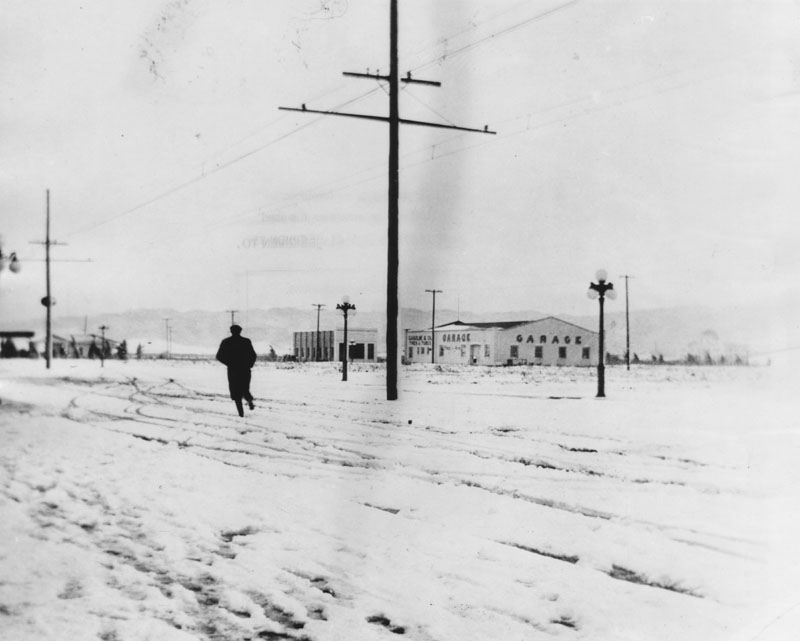 |
|
| (ca. 1915)* - View showing a man walking/running through the snow on Sherman Way in Owensmouth (later Canoga Park). An automotive garage/service station and other structures can be seen in the background. |
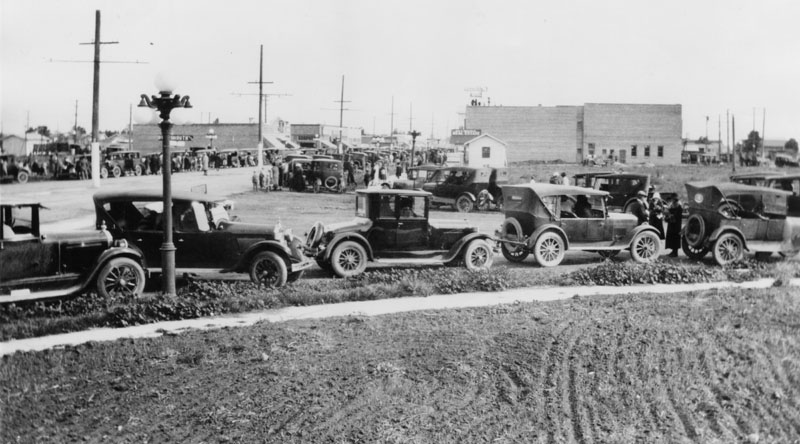 |
|
| (1920)* - View of the intersection of Owensmouth and Sherman Way in Owensmouth (later renamed Canoga Park) showing crowded street during the San Fernando Valley Fair and Market. |
Historical Notes The event seen above was the first annual San Fernando Valley Fair and Market that took place on September 15-18, 1920 in commemoration of what the aqueduct has done for the San Fernando Valley. There were horticultural and industrial exhibits to wow the crowds with lots of news clippings about it. Per the Van Nuys News (9-17-20 – Page1), the management of the fair gave a reception in the Owensmouth HS auditorium Sept 15 1920. Sept 17th was designated "San Fernando Day". |
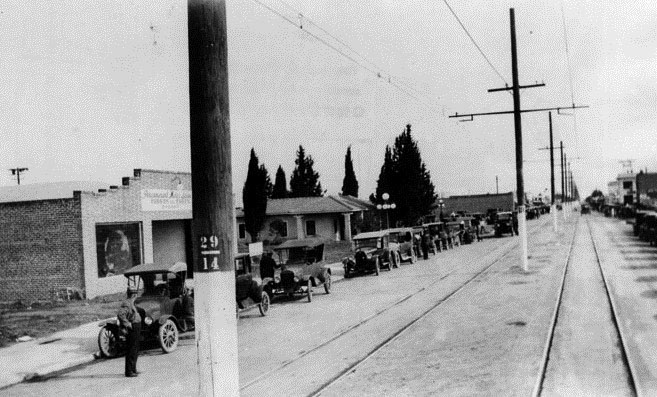 |
|
| (ca. 1920s)* - Sherman Way, divided by railroad tracks and a power pole line, in "downtown Owensmouth" in the early 1920's. |
Historical Notes A well-thought pre-development scheme brought Pacific Electric streetcars and an all-purpose highway (Sherman Way) out all the way from Hollywood through Cahuenga Pass, through the previously subdivided Van Nuys (1911). Highlighting the "opening day barbecue" was the display of the "Owensmouth Baby", a race car that could go up and down the paved Sherman Way at the incredible speed of 35 mph—as you could do—in an age without pavement or speed limits.*^ |
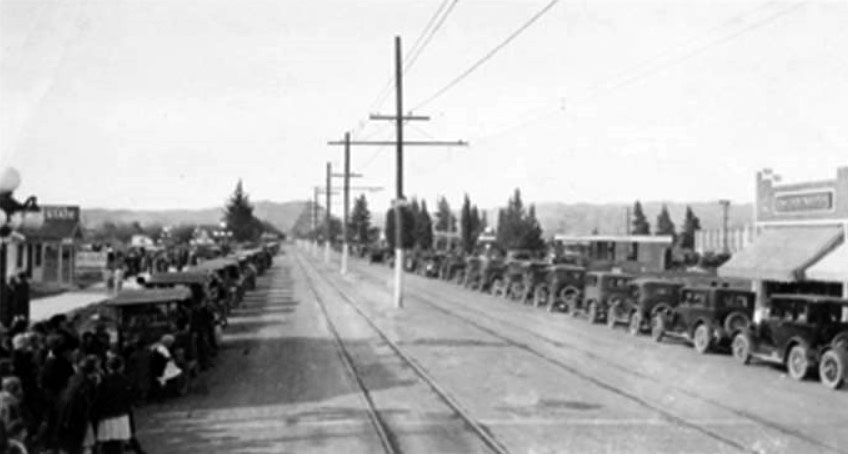 |
|
| (1924)^ - Sherman Way in Canoga Park looking west with a crowd of people, rows of cars, telephone poles and streetcar tracks visible. |
Historical Notes Owensmouth, as the junior San Fernando Valley city to Van Nuys, promoted itself with the "baby" motif—using storks in their advertisement—the "baby city" of the Valley. And Owensmouth remained a very small community.*^ |
 |
|
| (1920s)##^* - Panoramic view of Sherman Way showing two sets of rails and a power pole line running down the center of the street. Note the ornate streetlights located on the intersection corners in the foreground.. Click HERE to see more in Early LA Streetlights. |
Historical Notes The lack of an independent water supply made annexation to the City of Los Angeles inevitable, and on February 26, 1917 Owensmouth joined with its larger neighbor. The name was changed to Canoga Park in 1930. It is believed to be named after Canoga, New York, which derived its name from the Native American village "Ganogeh". Eventually, the area's zoning was rural/agricultural and its industry was small farms involved in production of fruits, vegetables, melons, some livestock, horses, movie/television studio and stunt location work. |
Zelzah (later Northridge)
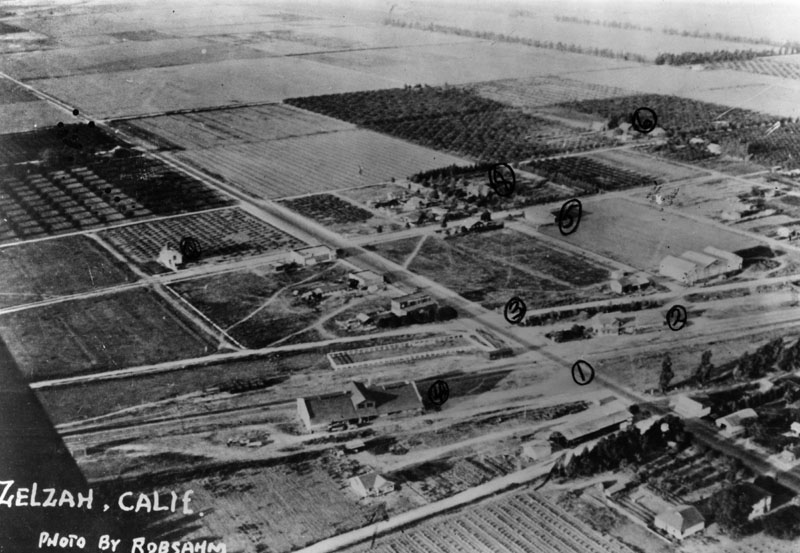 |
|
| (1918)* - Aerial view of Northridge, then known as Zelzah, in 1918. Number one is Reseda Boulevard, number two is the Southern Pacific Depot, number three is Parthenia Street, number four is the Zelzah School, and number five is the Clubhouse, the community's meeting hall. |
Historical Notes Parthenia Street was named for Miss Parthenia Staton of Lafayette Park, Calif. in 1916, when it opened between Van Nuys Blvd. and Kester Ave. Kester Ave was named for Kester Ranch, a major wheat-growing concern—part of the Lankershim-Van Nuys empire—from the 1870s to 1909.^* Reseda was named after a fragrant North African yellow-dye plant, Reseda odorata, whose English name is mignonette and which grows in hot, dry climates—replaced Marian as a designation for a stop on the Pacific Electric interurban railway running along Sherman Way. The name "Reseda" was given first to a siding on a branch of the Southern Pacific Railroad in the south San Fernando Valley. Zelzah Avenue was part of the 19th-century wagon route from San Fernando to the Hawk Ranch, which became the town of Zelzah (a Biblical name for "oasis," or "watering place in the desert"). In 1929 the name was changed to North Los Angeles. In 1938, the name changed again to Northridge Village and promptly shortened to Northridge.*^ Click HERE to see more SFV Street Name Origins. |
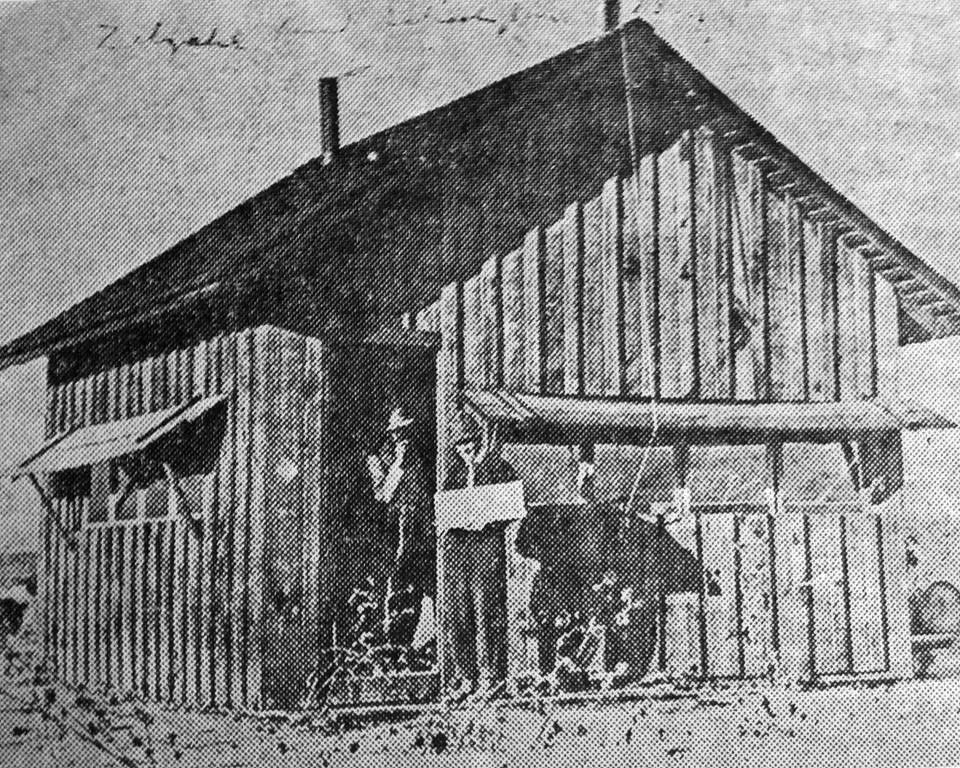 |
|
| (1911)^x^ – View showing two men standing in front of the first school in Zelzah (later Northridge, 1938), located on Canby Avenue and Rayen Street. Originally this building was a bunkhouse and later turned into a schoolhouse. |
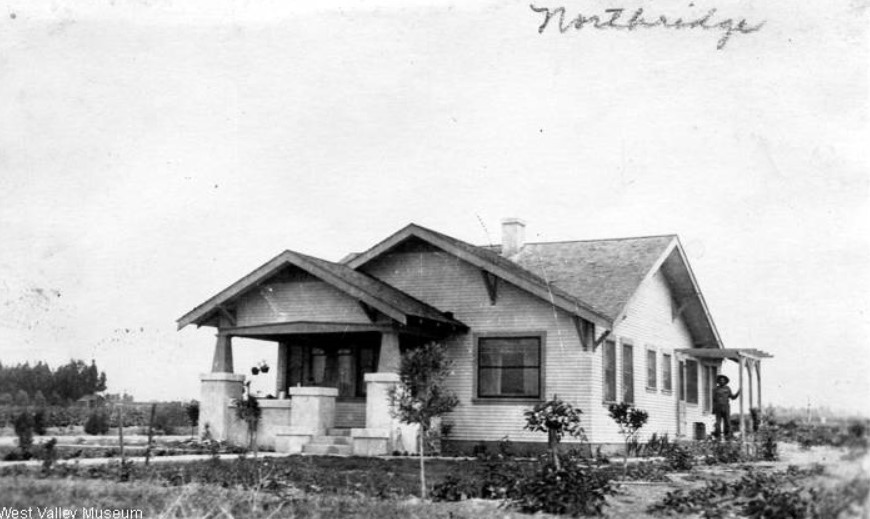 |
|
| (1918)#^ - Man standing on the side porch of a house in Zelzah (now Northridge). |
Historical Notes The above photo appeared on the front side of a postcard mailed by the owner of the house in 1918. See next photo for the reverse side of postcard. |
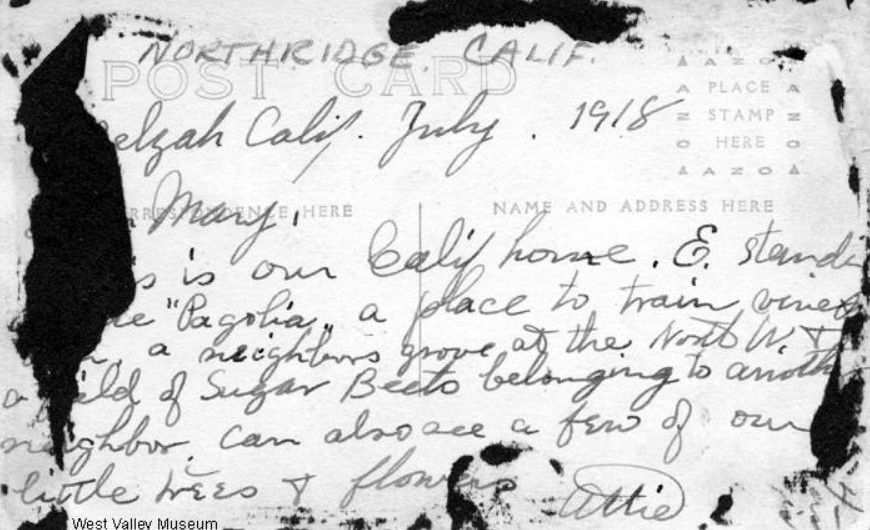 |
|
| (1918)#^ - Back side of postcard signed by "Attie". See previous photo for the front side of postcard. |
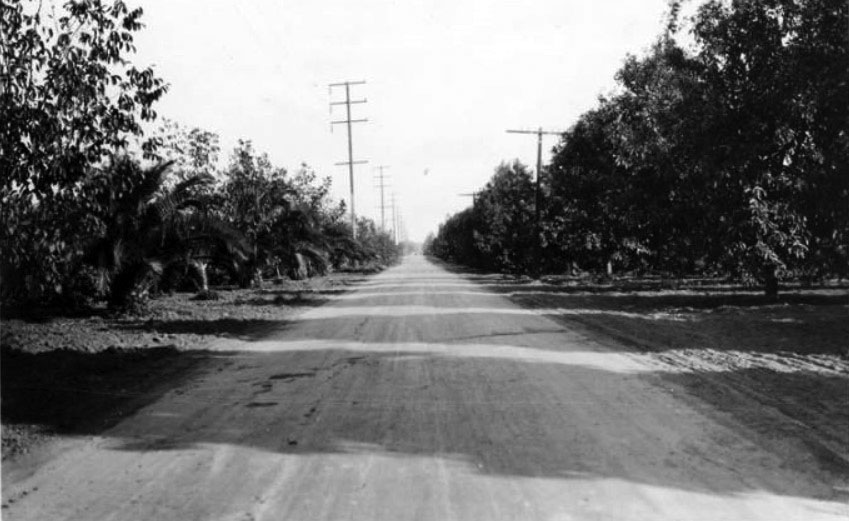 |
|
| (1921)#^ - Chatsworth Boulevard in Zelzah (later, Northridge. Fruit orchards are visible on both sides of the road. Photograph taken by Automobile Club of Southern California surveyor to show the condition of the roads. |
Historical Notes Chatsworth Boulevard was a dirt road that ran from the City of San Fernando all the way to the town of Chatsworth Park located at the west end of the San Fernando Valley. It followed present-day Chatsworth Street and Zelzah Avenue, then continued west on Devonshire Street to Santa Susana Avenue (Now Topanga Cyn Blvd). |
 |
|
| (ca. 1920)^ - View of orchards in the San Fernando Valley. |
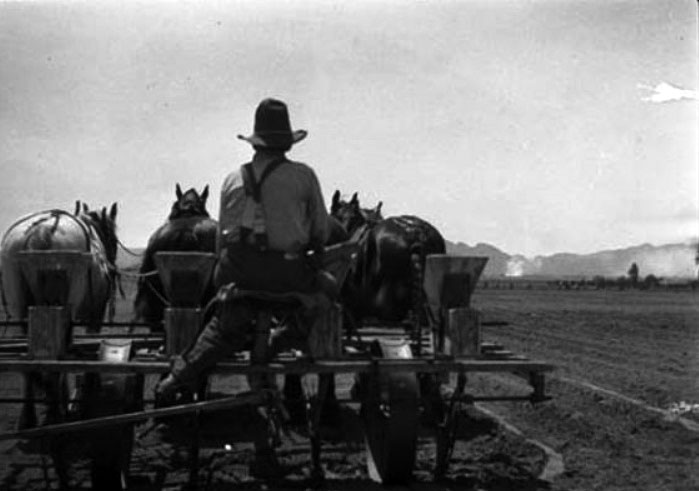 |
|
| (1925)#^ - Tilling the soil on the Halverson farm. The Halverson farm was located in Zelzah (now Northridge) and was part of the land of the future campus of the California State University, Northridge (CSUN). |
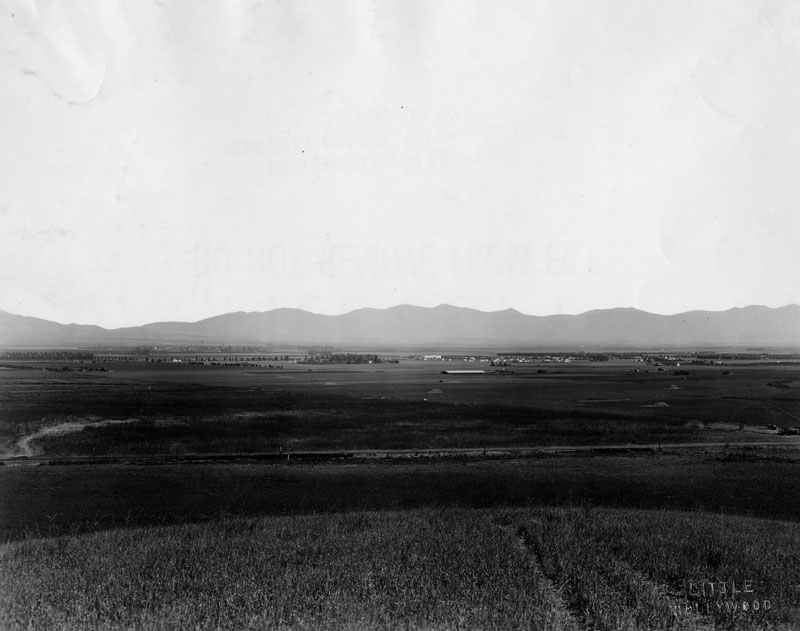 |
|
| (1925)* - Panoramic view looking north across the San Fernando Valley toward the community of Zelzah (now Northridge). |
Historical Notes Francis Marion ("Bud") Wright, an Iowa farm boy who migrated to California as a young man, became a ranch hand for Senator Porter and later co-developer of the 1,100-acre Hawk Ranch, which is now Northridge land. Wright continued to farm the land with Colonel Henry Hubbard from 1887 until 1910, when it was sold for subdivision to the Valley Farms Company. Before the first small farm homes had been sold, Bud Wright's wife, Emily Vose Wright, a deeply religious woman, had christened the development Zelzah, a Biblical name for "oasis," or "watering place in the desert." Zelzah became a Southern Pacific depot town at the Henry Hubbard & "Bud" Wright Hawk Ranch.*^ |
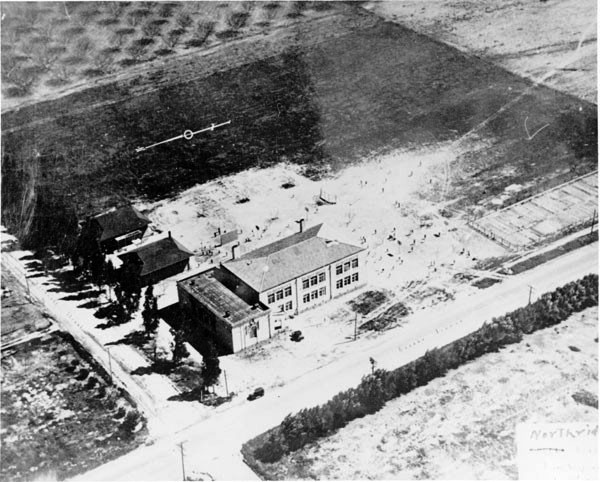 |
|
| (1927)^ - The Zelzah Elementary School in an aerial photograph. The school was located at 9036 Reseda Boulevard. Nordhoff Street is visible to the left (east) of the school and Reseda Boulevard is visible in the foreground (south). |
Historical Notes Zelzah Grammar School opened in 1914, one year after the Los Angeles Aqueduct was completed. The citizens of Zelzah formally voted for annexation to the City of Los Angeles and Owens River water rights in 1915. William Mulholland, engineer of the mammoth project, lived nearby and maintained one of many large rancho tracts remaining from the Spanish, Mexican, and Californio land grant days.*^ |
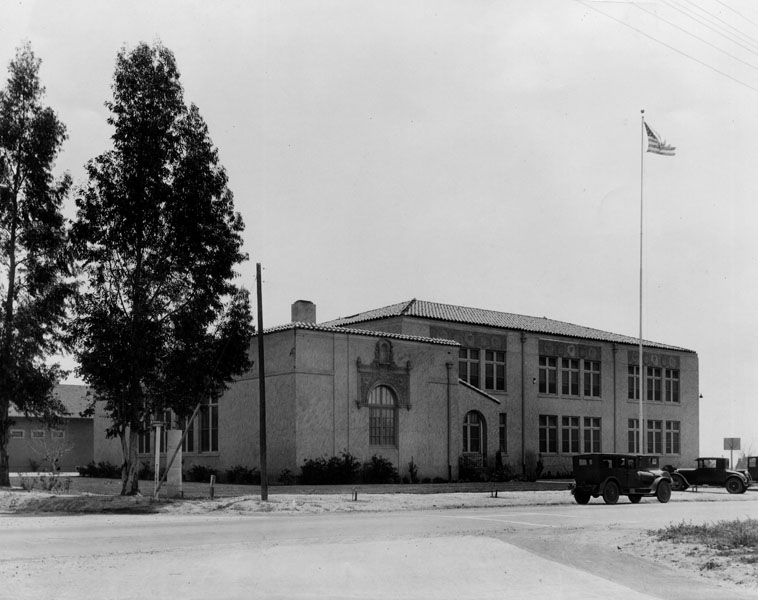 |
|
| (ca. 1920s)* - Close-up view of Zelzah Elementary School located at the southeast corner of Reseda and Nordhoff. |
Historical Notes Nordhoff Street was named for famed 19th-century health seeker and writer Charles Nordhoff. Hired by Southern Pacific rail baron Henry Huntington in 1873, journalist Charles Nordhoff wrote the book California for Health, Pleasure and Residence. Click HERE to see more SFV Street Name Origins. |
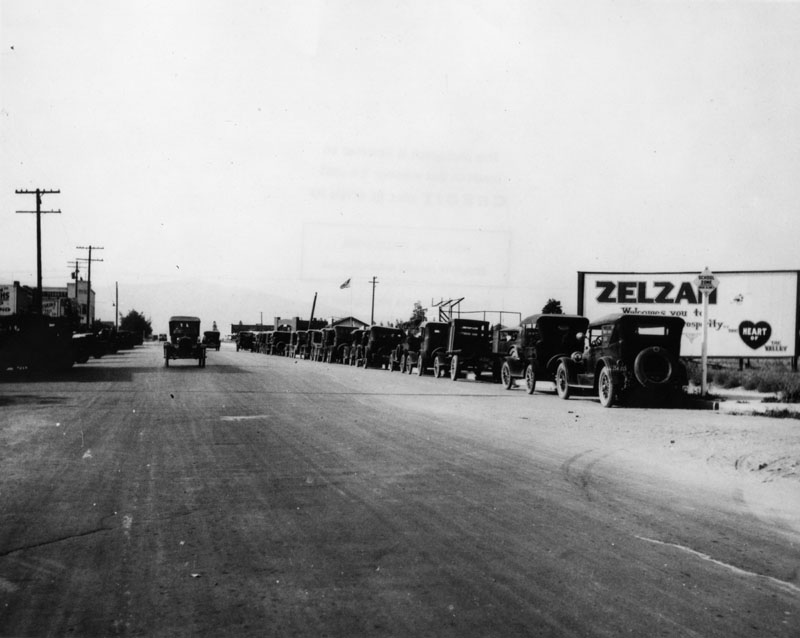 |
|
| (ca. 1920s)* - View of Reseda Boulevard, the main street of Reseda. The community was originally known as Zelzah. The signboard on the right reads: ZELZAH Welcomes you to ........Prosperity, in the HEART of the VALLEY. |
Historical Notes A water source at the intersection of Parthenia St. and Reseda Blvd. served as the watering hole and gathering place for the Gabrielino Indians and later the Spanish who established Missions in the area. The area, fed by underground streams, was very fertile and soon a development christened "Zelzah," a Biblical name for oasis, became important. #*^ Zelzah Acres became the name of one of those early housing tracts carved from the former enormous Rancho Ex-Mission San Fernando lands joining nearby towns of Chatsworth Park, Lankershim, Owensmouth, San Fernando and Van Nuys. Through the 1920s, Zelzah grew up, linked to Los Angeles by annexation, water, city government taxes, and transportation. A group of citizens joined forces and on July 1, 1929, christened this post office and train depot North Los Angeles, a name they considered more suitable and more memorable.*^ |
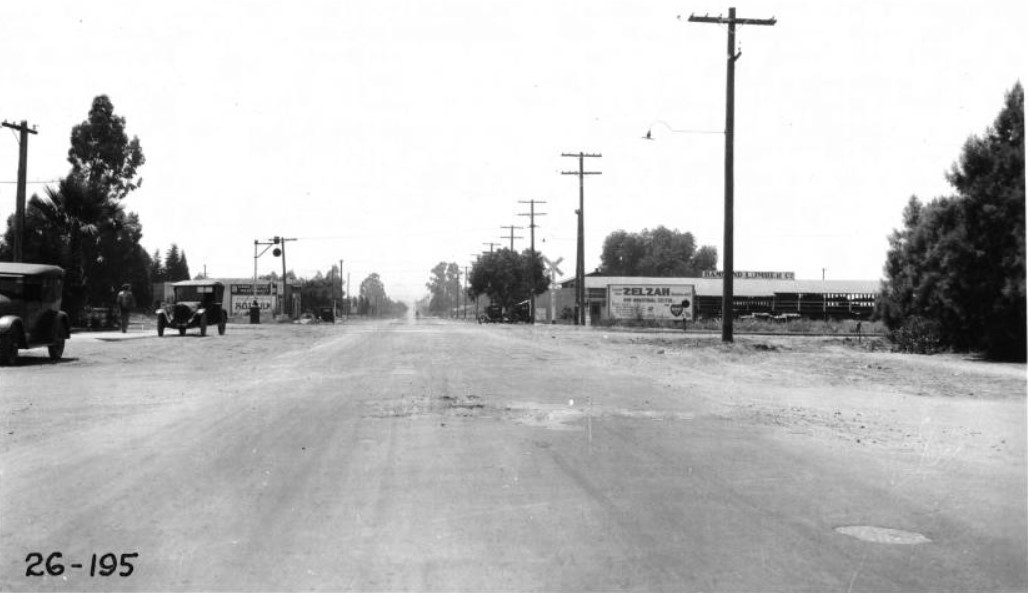 |
|
| (1926)^^ - Panoramic view of the grade crossing of Reseda Avenue (later Blvd.) with S.P. Main Line at Zelzah (soon to be Northridge), looking south from north side of tracks. Camera appears to be situated in or near the intersection with Eddy/Parthenia Street. Pacific Electric Railway operates double track. Sign on the building at right-center reads: “Hammond Lumber Co.” |
 |
|
| (1929)* - Reseda Boulevard looking south from Devonshire Street, in the early 1920s. The community grew on land that was once part of the Hawk Ranch. It's first name became Zelzah. The name then changed to North Los Angeles for a short period of time and then changed again to Northridge. |
Historical Notes At the suggestion of Carl Dentzel, a local resident and director of the Southwest Museum in Los Angeles, North Los Angeles became "Northridge Village" and was promptly shortened to Northridge. The sign on the depot was changed again, and the new name became permanently affixed on Oct. 1, 1938.*^ |
Then and Now
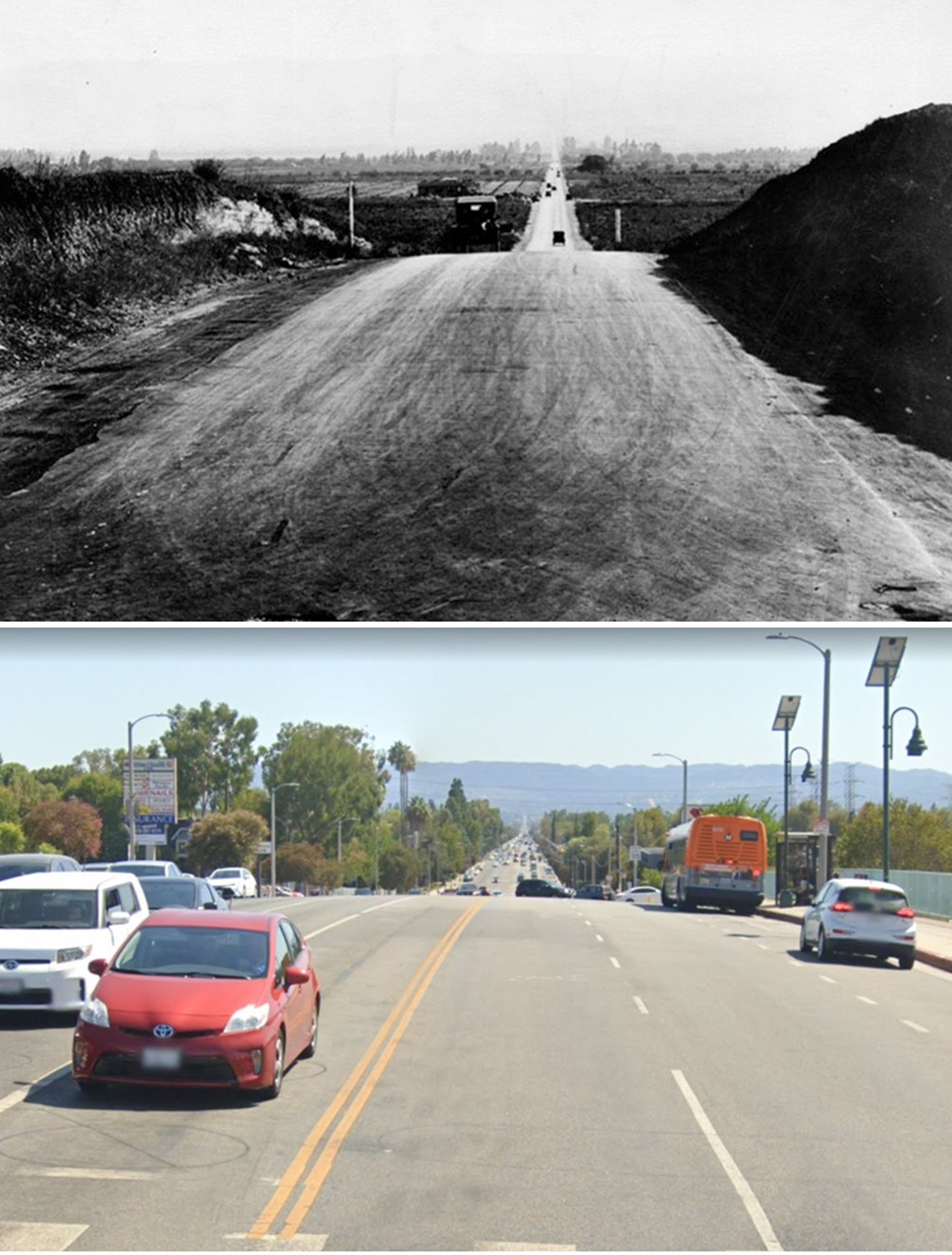 |
|
| (1929 vs. 2022)* - Reseda Boulevard looking south from near Devonshire Street. |
Click HERE to see a Northridge Historical Images Virtual Tour. ^#^# |
Cahuenga Pass
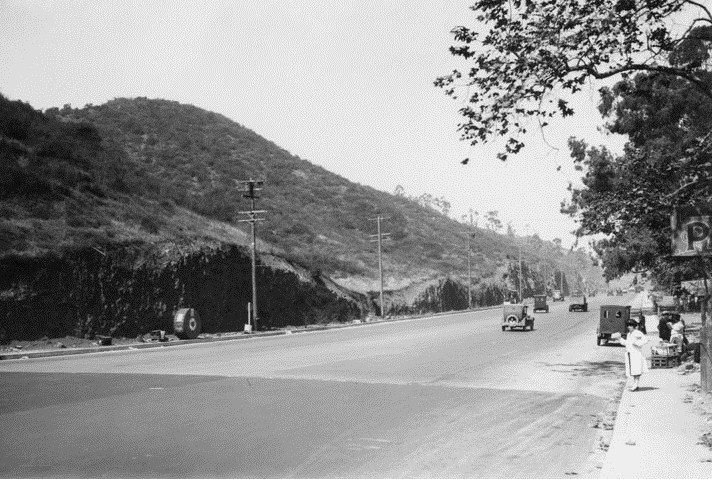 |
|
| (ca. 1920)** - A view of the broad highway on Cahuenga Pass - the lowest through the Santa Monica Mountains - that connects the Los Angeles Basin to the San Fernando Valley. The hills are truncated where they were excavated for the road bed. A street vendor is setup on the curb and although the utility poles are standing, the electric cables have not been strung. A roll of cable sits next to a pole, left. Click HERE to see more photos of Early Power Distribution. |
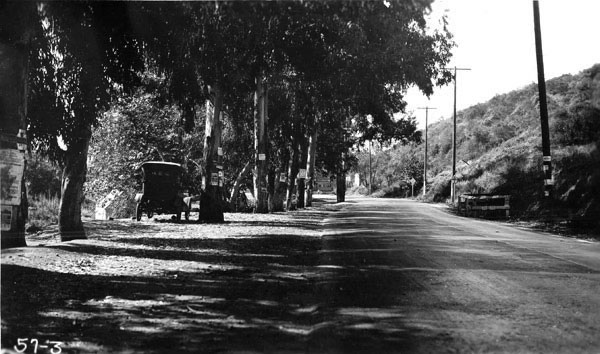 |
|
| (1921)**^^ - View of the highway through the Cahuenga Pass. A car is seen parked under a Eucalyptus tree on the side of the road. Most of the trees appear to have posters attached to them. |
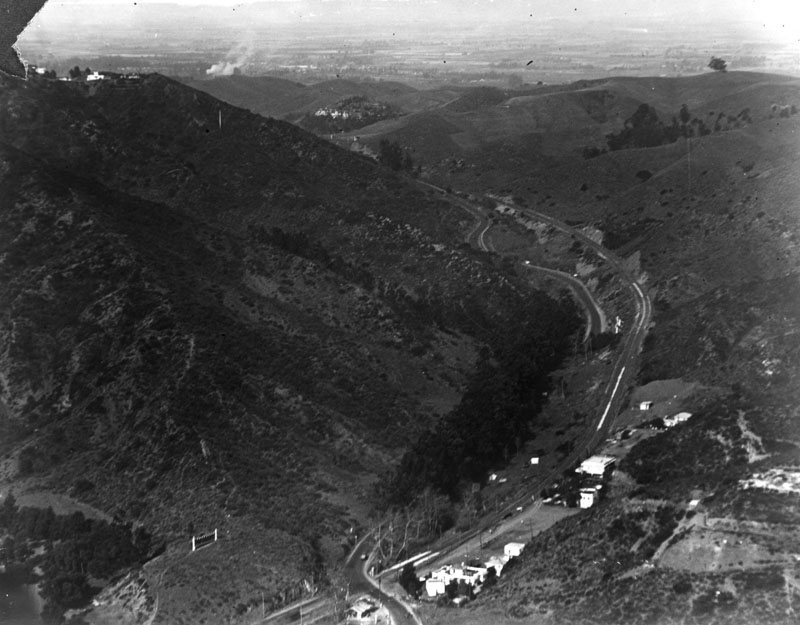 |
|
| (1922)* - Aerial view of Cahuenga Pass with the San Fernando Valley in the background. |
 |
|
| (1922)* - View of Cahuenga Pass looking east towards Hollywood. On the left are the railroad tracks, and paralleling them on the right is the road for cars. |
Mulholland Highway
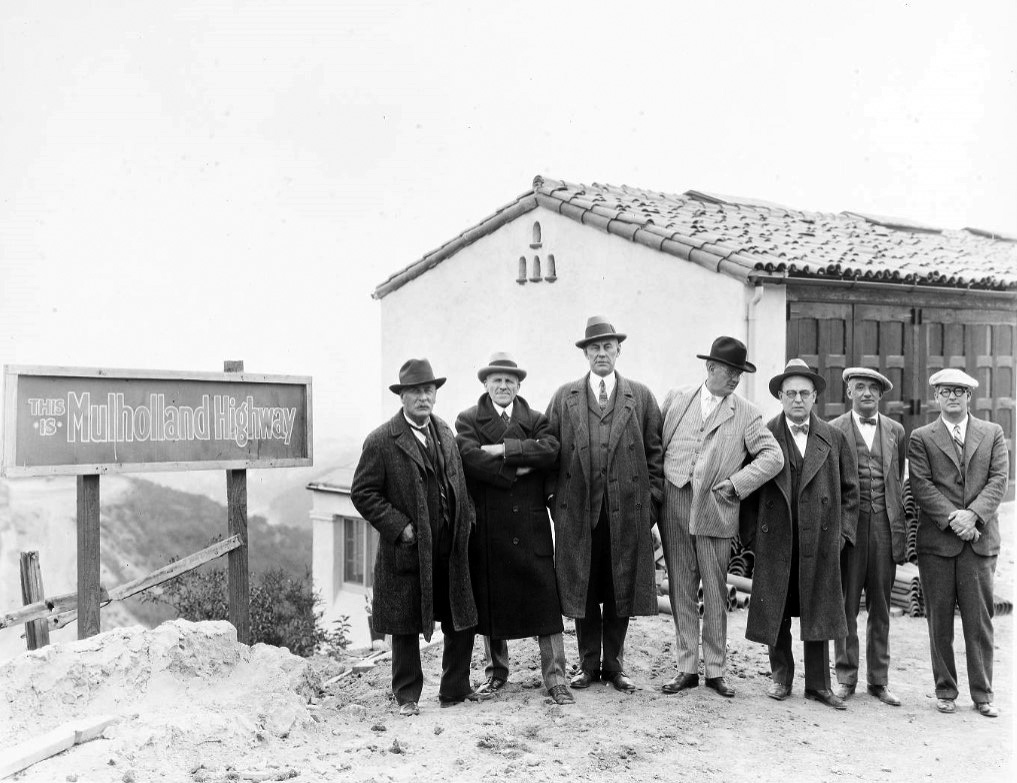 |
|
| (1920s)* - William Mulholland (far left), Moses Sherman (2nd from left), Harry Chandler (center) and a group of men posing next to a "Mulholland Highway" sign while out examining the nearby Mulholland Dam site. |
Historical Notes This winding ridgeline road in the Santa Monica Mountains was dedicated in honor of William Mulholland, the water engineer who designed the Los Angeles Aqueduct, on Dec. 27, 1924. Originally dirt and called Mulholland Highway, the name was changed to Mulholland Drive in 1939. Portions of the original road remain unpaved. ^Moses Sherman served on the water board while he also participated in plans to develop the San Fernando Valley, which became the outlet point for the Los Angeles Aqueduct. Sherman's double role has been the source of conspiracy theories with regard to the aqueduct. |
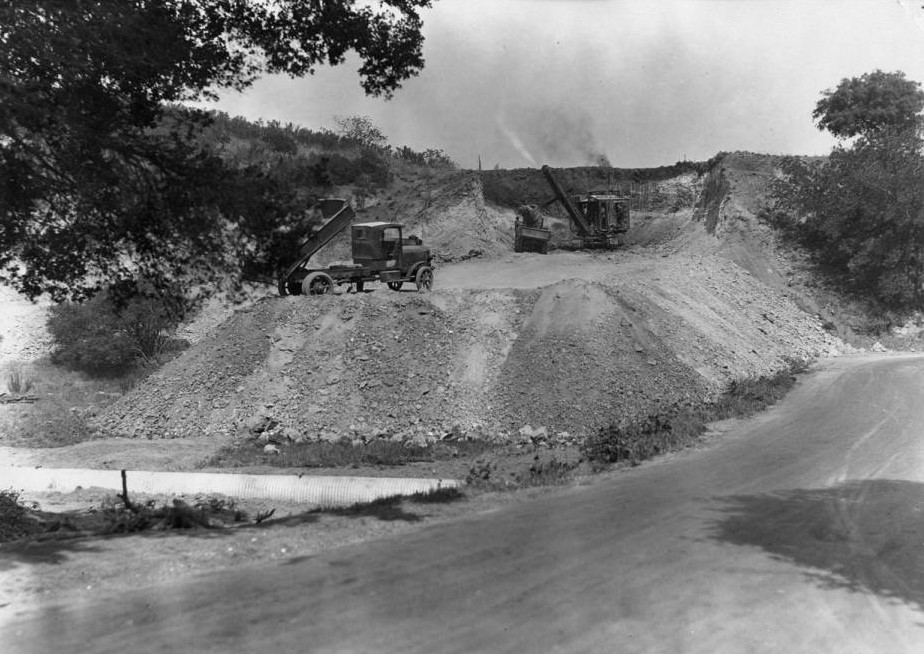 |
|
| (ca. 1924)* - Construction of Mulholland Highway at Topanga Canyon Boulevard in Girard (now called Woodland Hills). |
Historical Notes Mulholland Drive has its origins in 1921 as a scenic drive, with the “working name” of Skyline Drive, engineered by DeWitt Reaburn. The scenic drive was engineered in small sections, with work actually beginning at several points along the route simultaneously. The road was originally planned to encompass a right of way of 200 feet and intended to be 20 miles long, taking a mere two years to complete. For reasons, some to honor Mulholland, but mostly to use his stature and accomplishments to silence opposition, the most traveled scenic highway conceived as Skyline Drive became Mulholland Highway.* |
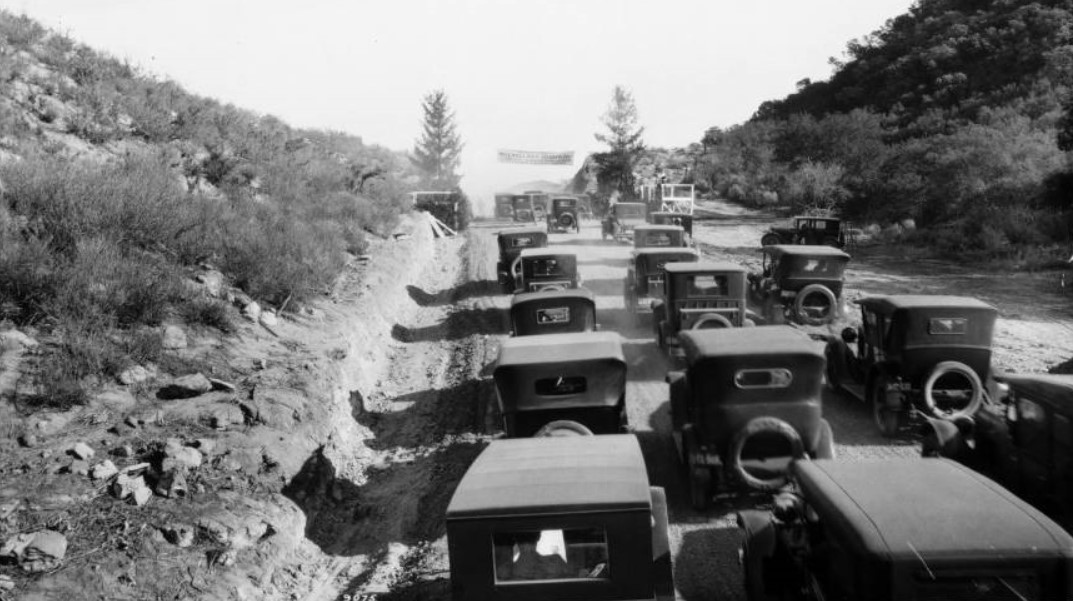 |
|
| (1924)* - View showing over a dozen early model cars clustered at the opening of the Mulholland Highway. Three rows of early automobiles make their way up the hill and through the mountains on the Mulholland Highway. Rocks and scrub vegetation cover the slopes to either side, a parked car and a wooden platform visible to the right, just off the road. At the peak of the hill, a banner is hung between two trees. |
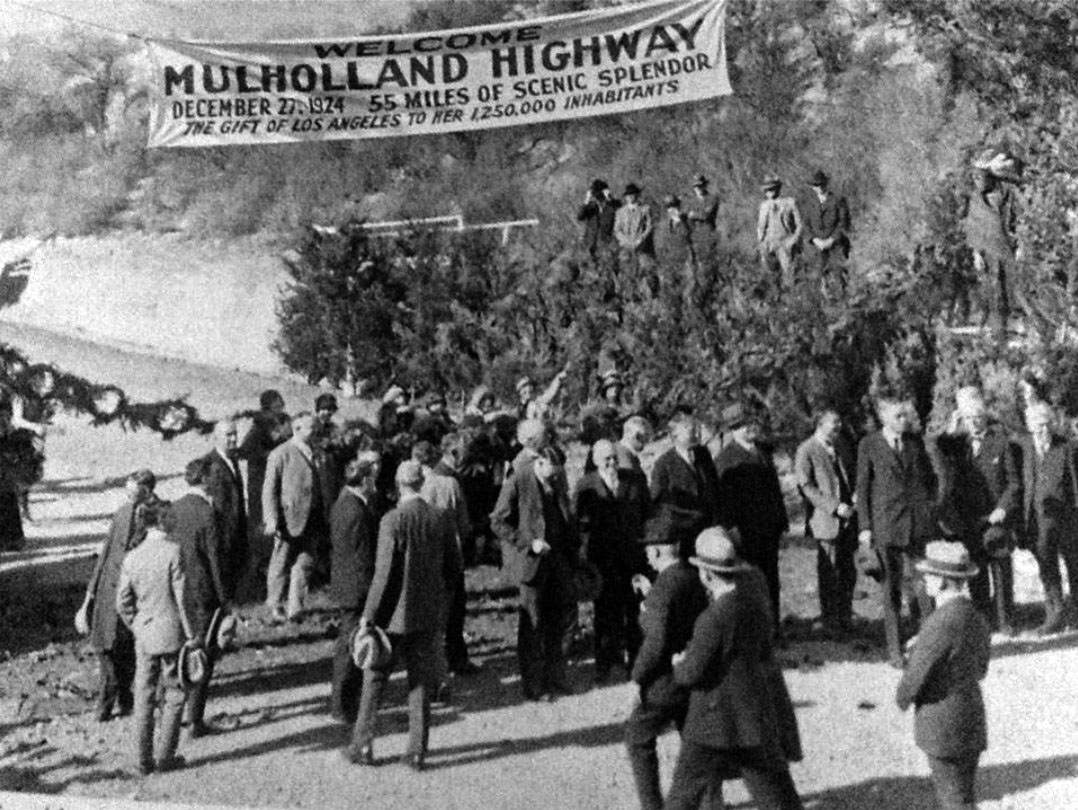 |
|
| (1924)* – Close-up view showing dignitaries assembling near a banner which reads: Welcome Mulholland Highway - December 27, 1924 – 55 Miles of Scenic Splendor – The Gift of Los Angeles to her 1,250,000 Inhabitants |
Historical Notes On the morning of the opening (Dec 27), William Mullholland dedicated the road with, what else, a bottle of aqueduct water. (Being prohibition, he couldn't use champagne). |
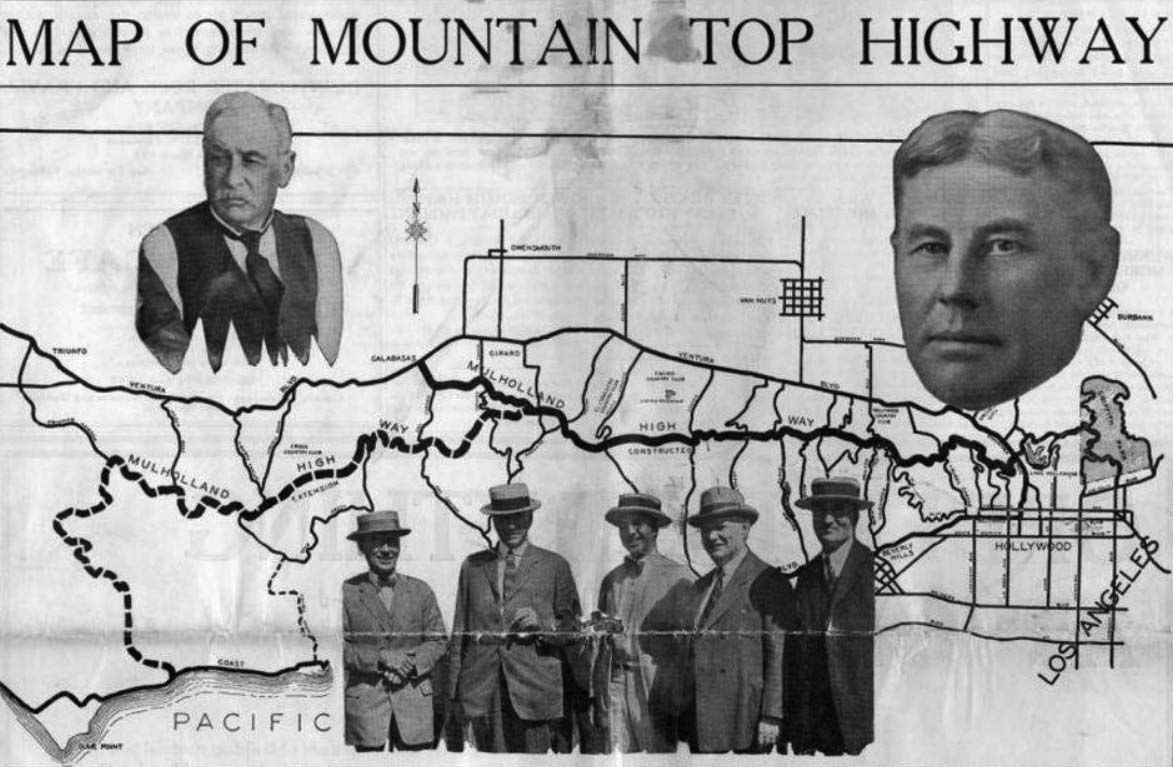 |
|
| (1924)^ – Map of the Mulholland Highway when first opened. Girard News |
Historical Notes When it officially opened on December 27, 1924, Mulholland Highway was 24 miles long - the solid line, running from Cahuenga Pass to Calabasas. The dotted line shows what was still to be constructed, Topanga Summit to the Ocean. Originally the road was of gravel surface treated with oil. |
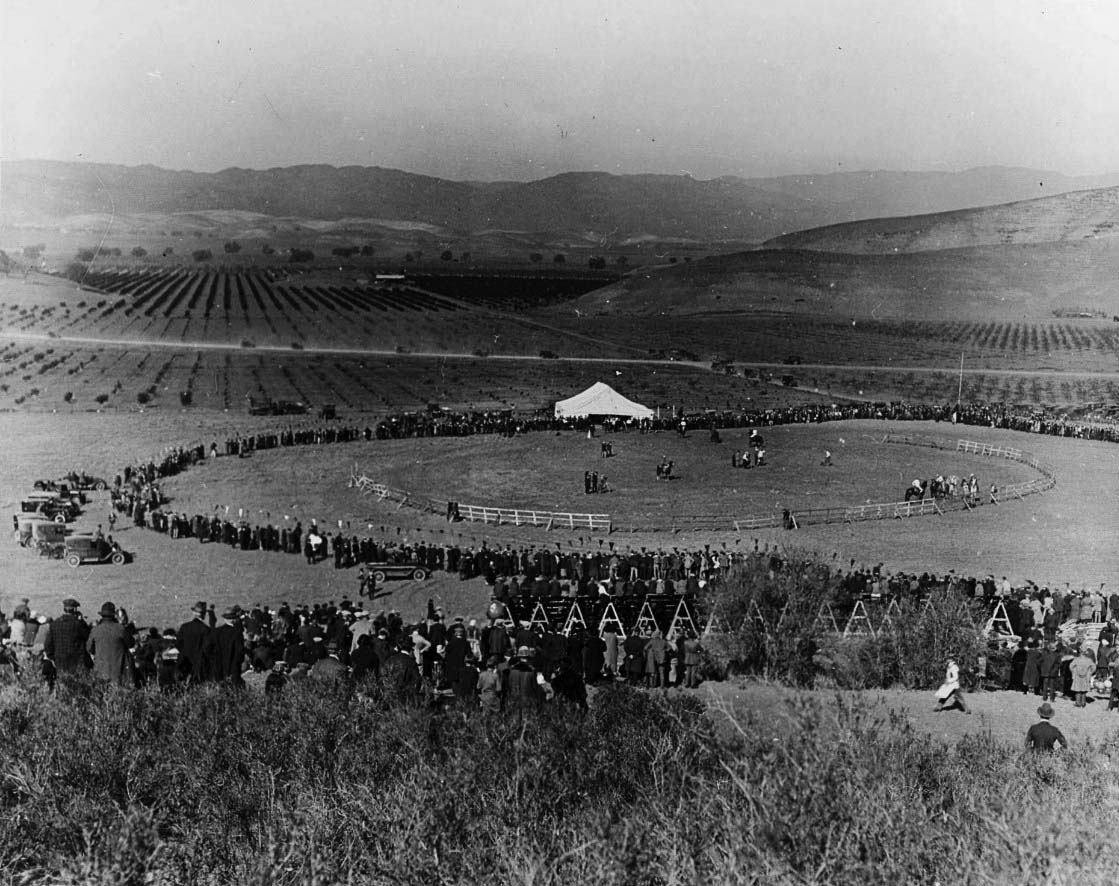 |
|
| (1924)^ – To celebrate the opening of Mulholland Highway, Tom Mix directed this rodeo with a company of rough riders performing in Calabasas. Photo dated Dec 27, 1924, from the Ernest Marquez Collection. |
Historical Notes An article in the Oxnard Press Courier provides additional details of the event: “The first part of the festival program will be held at Calabasas, beginning at 11 o’clock, when a wild west performance and rodeo will be staged by the world’s greatest riders and ropers under the direction of Tom Mix. Other novel features are being arranged for this part of the celebration, which will include one of the most spectacular aerial demonstrations ever witnessed in this state, with more than 50 military and civilian airplanes participating. Hair-raising flying stunts will be performed and the military planes from Clover Field and San Diego will engage in battle manoeuvers and combat demonstrations.” |
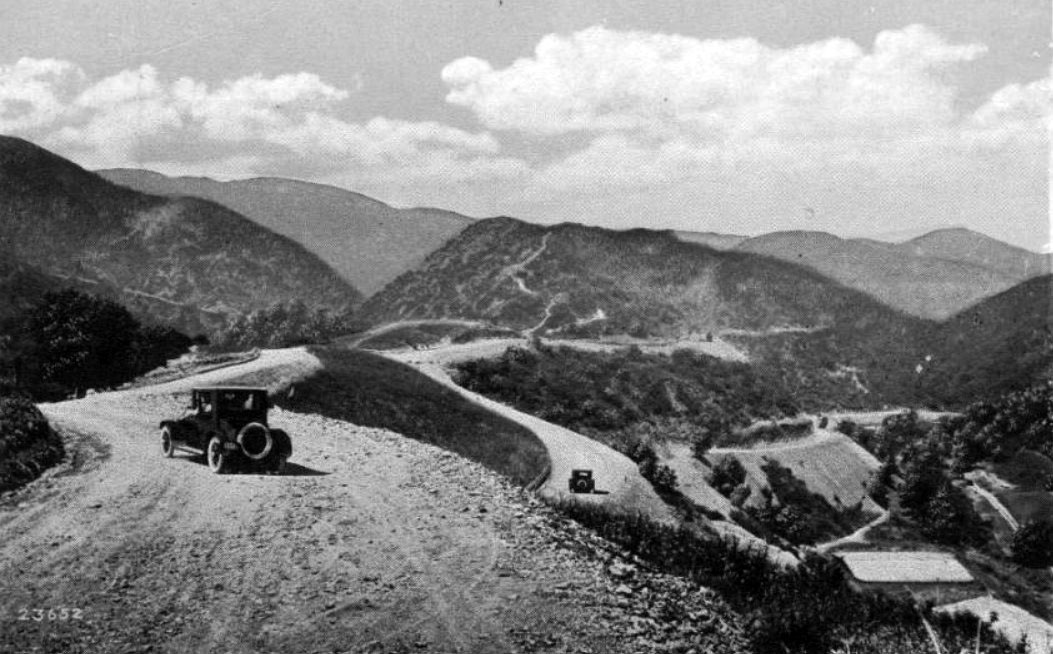 |
|
| (ca. 1924)^ – Postcard view showing two early model cars near the intersection of Mulholland Highway (later Drive) and Franklin Canyon. |
Historical Notes Curving ingeniously through the eastern Santa Monicas, the Mulholland Drive motorway once brought a heavy slew of Angelenos into the Valley. In the early 1970s, however, 5,000 local activists successfully prevented the cement paving of most of that stretch. To this day, that section is known as 'Dirt Mulholland', and is only open to cyclists and pedestrians. From the famous Mulholland Bridge east, Mulholland Drive completes its creator's vision, and winds through the affluent Hollywood Hills to Mulholland Drive's easternmost terminus at Cahuenga Boulevard, near Universal Studios, until again becoming an unpaved footpath to Griffith Park. The paved road begins again east of Topanga Canyon Boulevard at Santa Maria Road. Shortly thereafter, the thoroughfare splits into Mulholland Drive and Mulholland Highway. Mulholland Drive terminates at U.S. Highway 101 (the Ventura Freeway), where it becomes Valley Circle Boulevard. Mulholland Highway continues to the southwest until it terminates at State Route 1 (PCH) in Leo Carrillo State Park at the Pacific Ocean coast and the border of Los Angeles and Ventura counties.* |
Then and Now
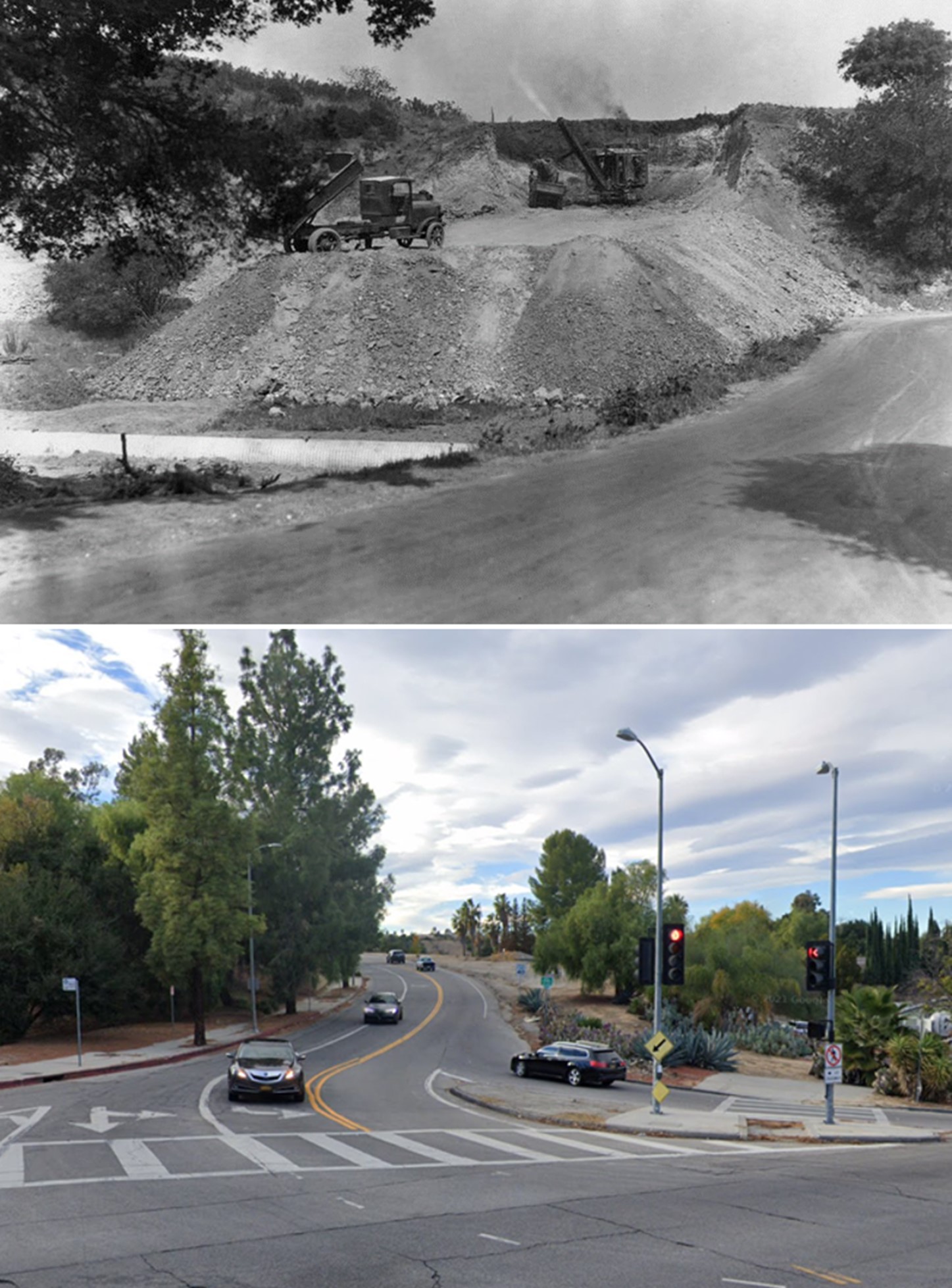 |
|
| (1924 vs 2020)* – Looking west on Mulholland Drive at Topanga Canyon Blvd. Note: Most of Mulholland Highway was renamed Mulholland Drive in 1939. |
Click HERE to see more in Mulholland Monuments |
* * * * * |
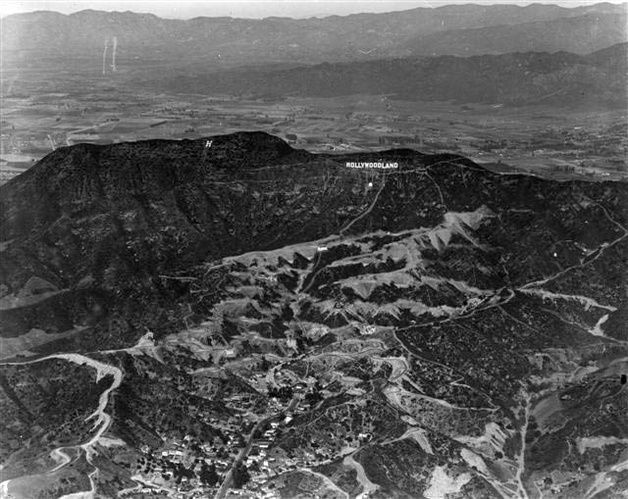 |
|
| (ca. 1920s)**^*- Aerial view of the Hollywoodland Sign showing the newly developed land in the foreground. Beyond the Hollywood Hills can be seen the vast amount of open space and farmland of the San Fernando Valley. The HOLLYWOODLAND sign sits below Mt. Lee. Another sign ( just the letter 'H') is seen to the left on top of Mt. Cahuenga. |
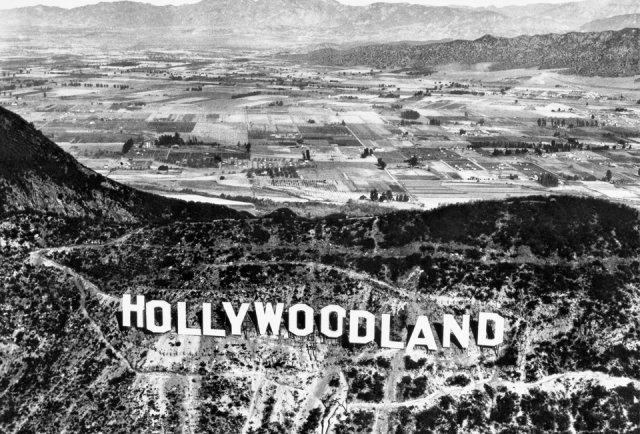 |
|
| (ca. 1924)*^ - Aerial view overlooking the Hollywood Hills and HOLLYWOODLAND sign into Burbank in the east San Fernando Valley. Farmland and open fields can be seen throughout. |
Historical Notes Real estate developers Woodruff and Shoults called their development "Hollywoodland" and advertised it as a "superb environment without excessive cost on the Hollywood side of the hills". They contracted the Crescent Sign Company to erect thirteen letters on the hillside, each facing south. Each letter of the sign was 30 feet wide and 50 feet high, and the whole sign was studded with some 4,000 light bulbs. The sign would flash in segments; "HOLLY," "WOOD," and "LAND" would light up individually, before lighting up entirely. Below the Hollywoodland sign was a searchlight to attract more attention. The sign was officially dedicated on July 13, 1923.*^ |
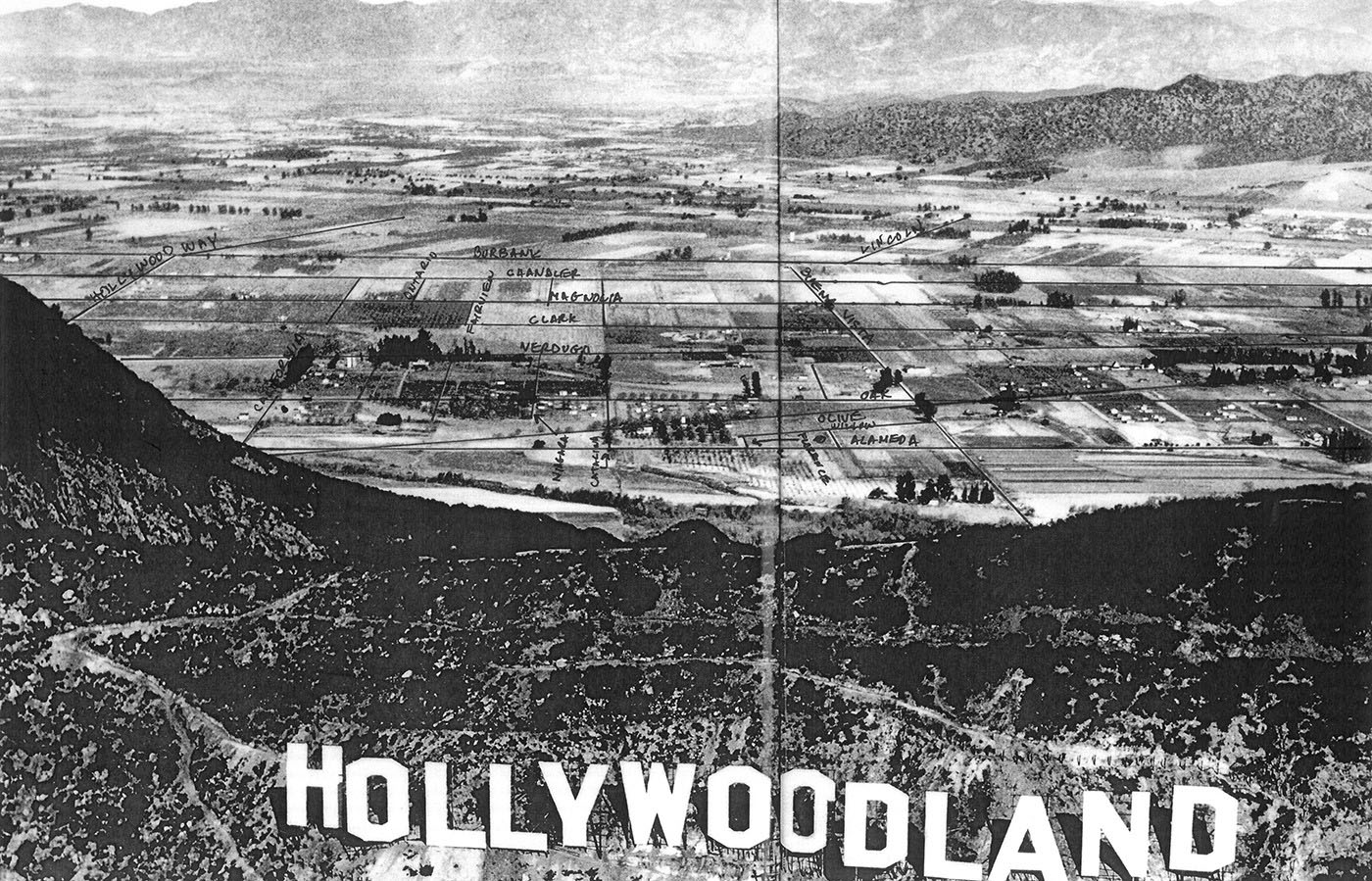 |
|
| (ca. 1924)*#^# - Same view as previous photo but blown up to show details with street names annotated. Note the vast amount of famland and open fields. |
Click HERE to see more in Early Views of Hollywood |
Sunland - Tujunga
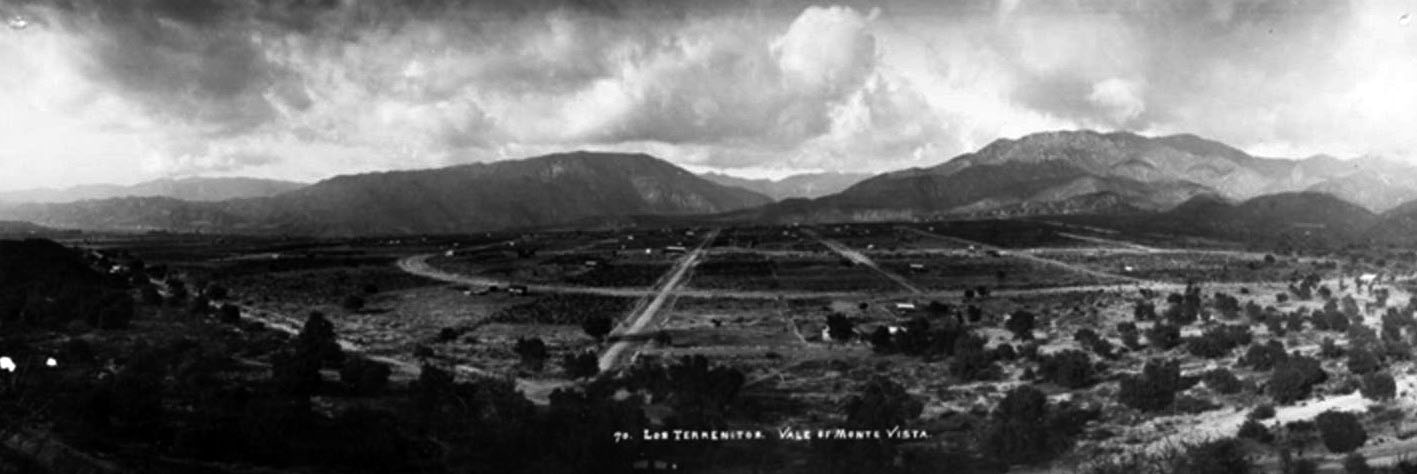 |
|
| (1914)#^ - Panoramic view showing the area called Los Terrenitos - Vale of Monte Vista, currently Tujunga. |
Historical Notes In the early 1900s, the area now known as Tujunga was undeveloped land, the former Rancho Tujunga. In 1913, William Ellsworth Smythe, working alongside M.V. Hartranft (they had purchased the land together), formed a Utopian community called Los Terrenitos— Spanish for The Little Landers. Smythe was the leader of the Utopian Little Landers movement and had already established colonies in Idaho and San Ysidro, California. He advocated the principle that families settling on an acre or two of land could support themselves and create a flourishing community.*^ |
 |
|
| (ca. 1920s)* - Panoramic view of Sunland showing the Monte Vista Valley and Big Tujunga Wash. |
Historical Notes Generally thought to be a part of the San Fernando Valley, Sunland-Tujunga is actually located in a valley of its own --the Tujunga Valley — which opens into the northern edge of the larger San Fernando Valley. Also known as The Rock, the towns lie on a large bedrock close to 2,000 feet above sea level with mountain ranges on both sides.* |
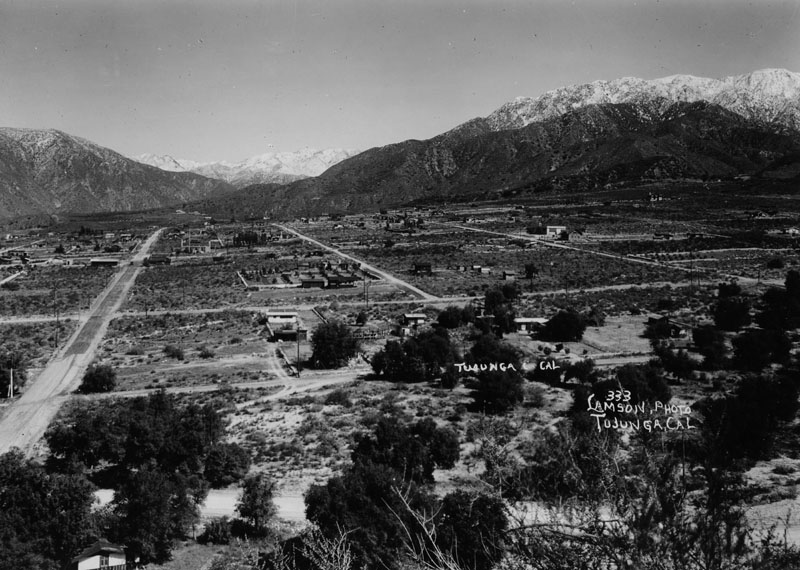 |
|
| (ca. 1920s)* - An overview of Tujunga from a nearby hillside, looking towards the snowcapped San Gabriel Mountains. |
Historical Notes Sunland and Tujunga were originally home to the Tongva people. In 1840 the area was part of the Rancho Tujunga Mexican land grant, but later developers marked off a plot of land known as the Tejunga Park, or the Tujunga Park, Tract. The name Tujunga is assumed to have meant "old woman's place" in the extinct Tongva language, where Tuhu "old woman" is a term for Mother Earth in Tongva mythology.*^ |
 |
|
| (ca. 1930)#^ - Farmland, perhaps a vineyard, near Tujunga. The San Gabriel Mountains are seen in the background. |
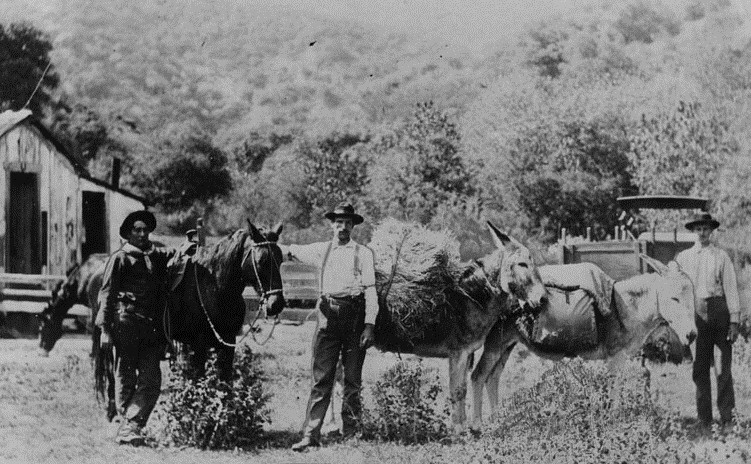 |
|
| (ca. 1910)* - A farm at the corner of Haines Canyon and Tujunga Canyon Boulevard. Men in suspenders and hats, some with holster and gun, stand beside a saddled horse and donkeys loaded with bags and hay. |
Historical Notes The above print was reproduced in 1955 for an article in the Herald Examiner. Photo caption read "Farming was hardly worthwhile. The land was poor. If you dug out stones to build a home or barn, there wasn't enough dirt to fill up the hole."* |
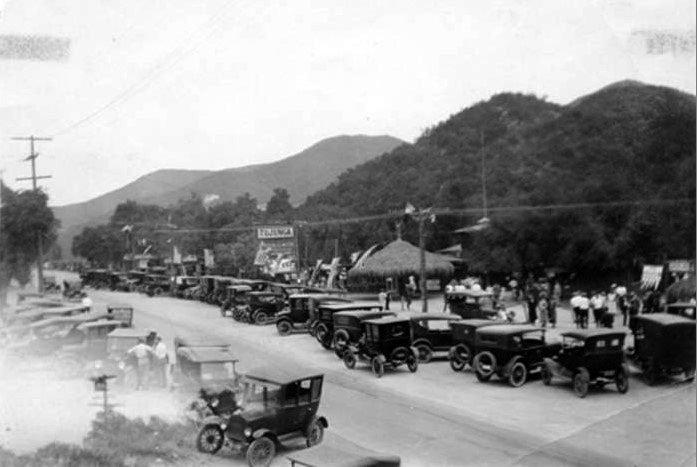 |
|
| (1924)*^^^ - Independence Day Celebration on July 4, 1924 at the Garden of the Moon Park and Campgrounds in Tujunga. |
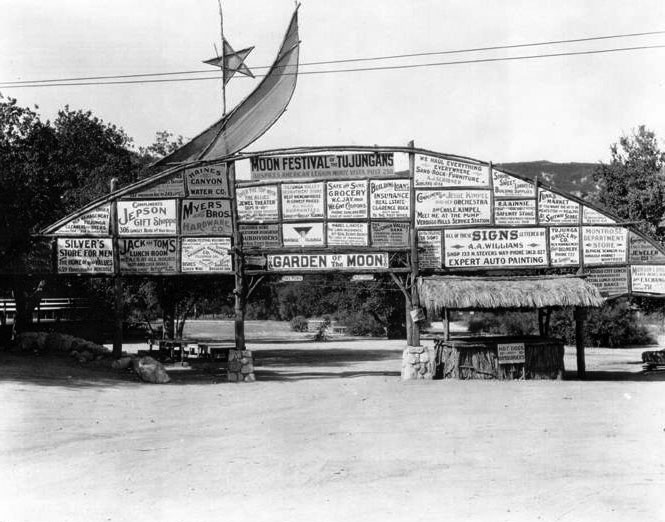 |
|
| (1925)*^^^ - View of Garden of the Moon Park and Campgrounds in Tujunga. The grounds were located at Foothill & Commerce Avenue. |
Historical Notes The "Moon Festival of the Tujungans" was sponsored by the American Legion (Monte Vista Post 250) as well as other Tujunga businesses and establishments.*^^^ |
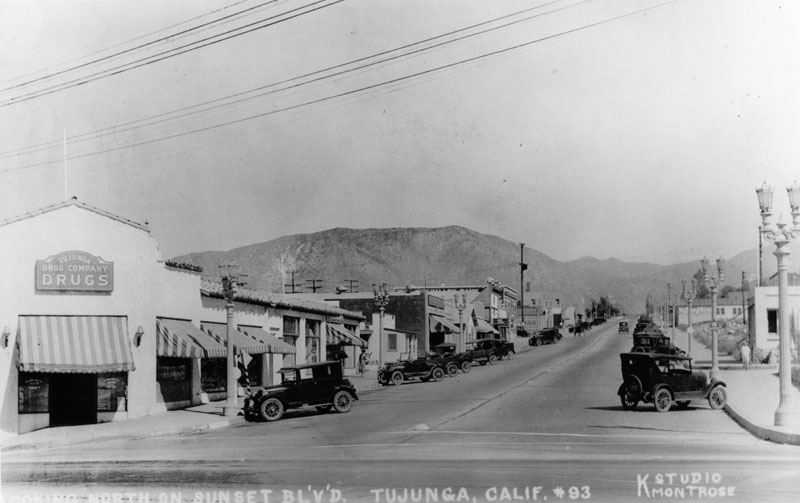 |
|
| (ca. 1925)* - A view up Commerce Avenue in Tujunga. This is looking north from Foothill Blvd. The picture was originally labeled as "looking north on Sunset Blvd. Tujunga, Calif." |
Historical Notes The first election for Tujunga to be consolidated with Los Angeles was held on February 15, 1927. In heavy rain, voters turned down the idea by a vote of 594 to 354. A second election held in March 1930 also resulted in defeat for annexation, "by a large majority." The third and final election in January 1932, however, resulted in a favorable vote to join Los Angeles, even though the actual transfer was delayed by inaction of state authorities. Tujunga finally joined the city on March 8, 1932. Sunland was annexed to the city of Los Angeles effective August 4, 1926.*^ |
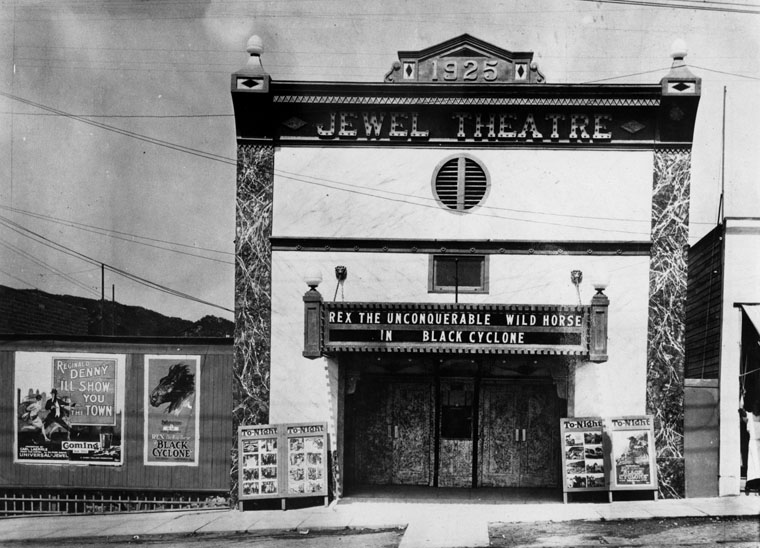 |
|
| (ca. 1925)* - The Jewel Theater which was built in 1925. It was possibly the first theater in Tujunga and was located on Commerce Street. Now showing: Rex the Unconquerable Wild Horse in Black Cyclone. |
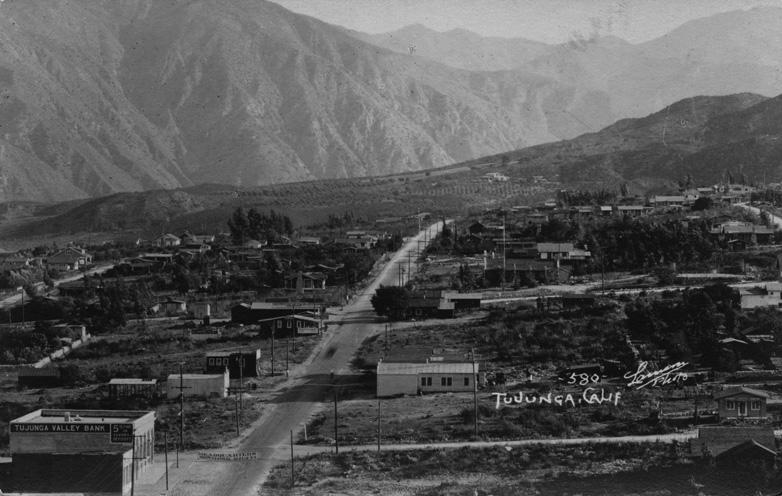 |
|
| (ca. 1920)#** - View of Tujunga looking north toward the San Gabriel Mountains. The Tujunga Valley Bank stands at lower left on Sunset Boulevard, now Commerce Avenue. |
.jpg) |
|
| (1926)^^ - Birdseye view of Sunset Boulevard, now Commerce Avenue, in Tujunga, looking north toward the San Gabriel Mountains. The paved lanes of Sunset Boulevard run through the center of the image, lined sparsely on both sides by one- and two-story commercial buildings. Automobiles are parked to each side of the street, while a few others drive along it. Visible buildings include the "Tujunga Valley Bank", a hardware store, and a store bearing the sign "The Sunset Fair". Greeley Street intersects Sunset Boulevard in the lower right corner of the image; Michigan, now Foothill Boulevard, sits one block south (beyond the image). |
 |
|
| (1925)^ – View of the business district, looking south on Commerce Avenue towards the Verdugo mountains. The cross street is Valmont. At this time only the business district streets were paved. Originally Commerce Avenue was called Sunset and Valmont was originally called El Centro. On the right is the Breidt Building and next to it is a real estate office. |
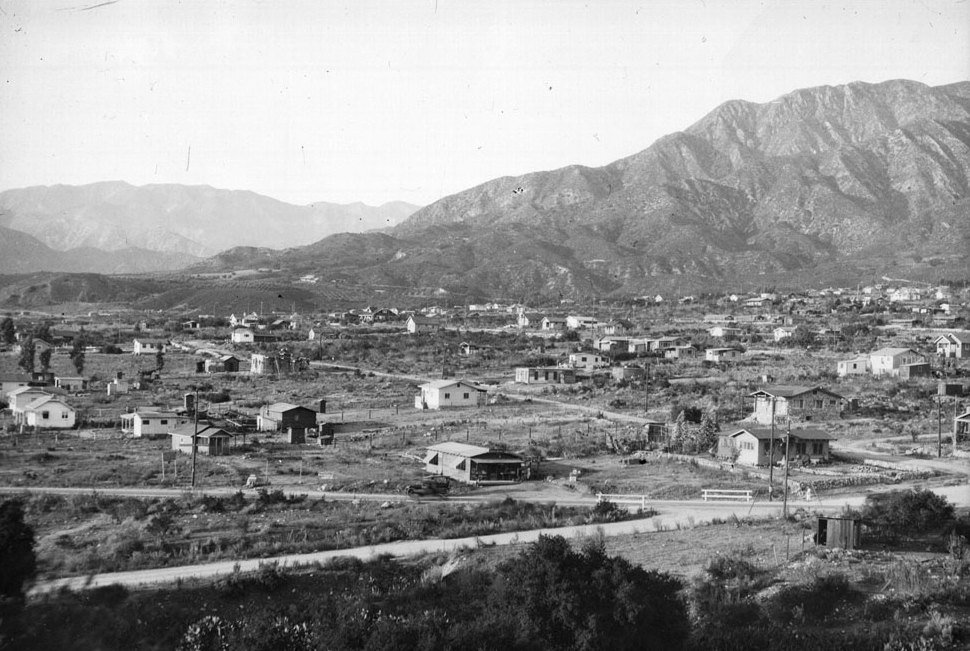 |
|
| (ca. 1928)#** - View of the residential area of Tujunga, looking north. Many small houses are scattered sparsely throughout an expanse of land that sits at the foot of a mountain. The majority of the houses are frame houses, though one in the right centerground is made of stone. Orchards are visible on the distant foothills to the left of the image. Several mountains sit in the background. |
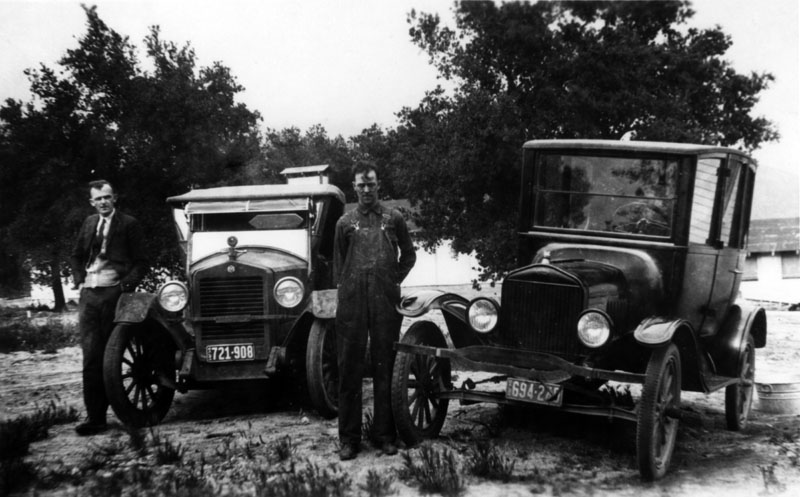 |
|
| (ca. 1928)* - Two men posing by their cars in Sunland. |
Historical Notes Clarence, center, and his friend Odgen, a coworker at the Claycraft pottery factory, with their cars. Clarence's car is a Model T. He could coast most of the way from his home in the town of Tujunga down Tujunga Canyon Boulevard past Verdugo City and through Glendale via Verdugo Road to work at San Fernando Road and Fletcher Drive, in Los Angeles.* |
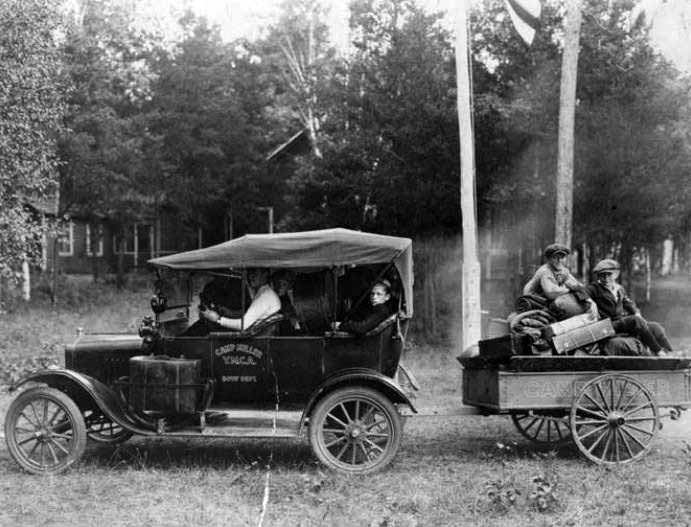 |
|
| (ca. 1920s)^ - Car and trailer filled with camping gear and boys from the YMCA at Camp Miller in Tujunga. |
Bolton Hall
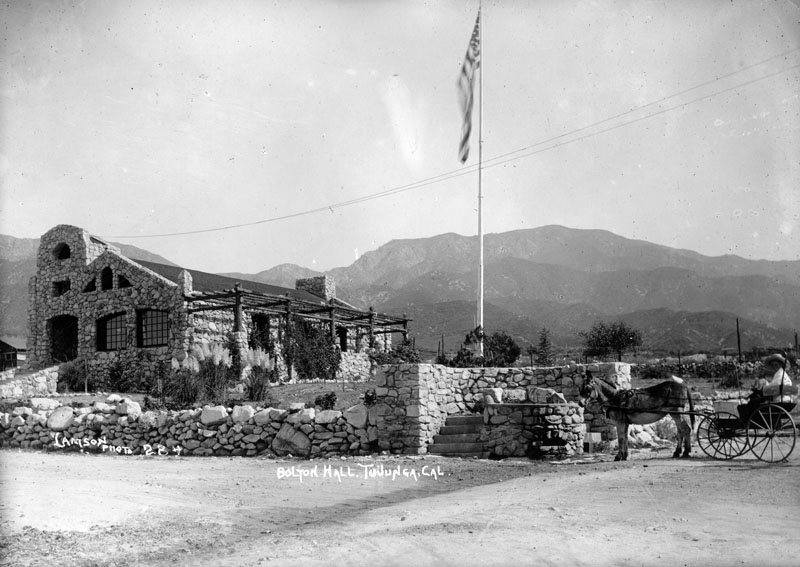 |
|
| (ca. 1920s)* - Photograph taken from Commerce St. looking east at the exterior of Bolton Hall in Tujunga. |
Historical Notes Bolton Hall was built in 1913 by George Harris, a self-described "nature builder, rock mason and stone sculptor. He first named it "Bolton Hall Hall," after Bolton Hall (1854–1938), a New York City progressive activist and proponent of the back-to-the-land movement. Harris urged that the 3,000-square-foot hall be built solely of native materials, and selected a design that he said borrowed nothing from European architecture. Harris and the Terrenitos community built the hall using granite chunks and stones from nearby fields and hillsides and from the Tujunga Wash. Stones were placed in position in the structure based on the positions in which they settled after falling from a cliff. |
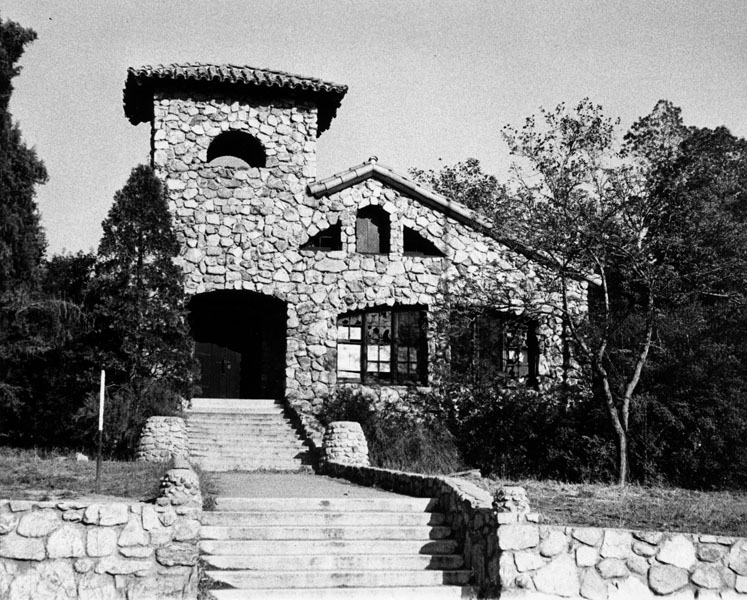 |
|
| (n.d.)* - Exterior view of Bolton Hall, built in 1913 as part of the Little Lands Colony in Tujunga, and used for church services, town meetings, weddings and other social occasions. |
Historical Notes When Bolton Hall opened in August 1913, the Los Angeles Times reported that it marked the "awakening of the Vale of Monte Vista" (the former name of Sunland): First settled nearly thirty years ago, the valley has shown more life in the past six months than in all its previous history. Los Terrenitos, the settlement of "'little-landers," has made wonderful progress since its inception, five months ago, about 200 families having purchased land, not all of whom are yet on the ground. But enough are here to make it a beehive of industry. The dedication of "Bolton Hall" last Saturday aroused much enthusiasm among the "little-landers." The Times also reported that Bolton Hall was "built to stand for ages," and it has survived the 1971 Sylmar and 1994 Northridge earthquakes without a scratch. During the hall's early years, it hosted community meetings patterned after those held in old New England town halls. Over the next decade, it was used for church services, musical performances, lectures, motion picture shows, the Women's Club, dances and pot-luck suppers. It also was the site of the San Fernando Valley's second public library. In 1962, Bolton Hall at 10116 Commerce Avenue was designated Los Angeles Historic-Cultural Monument No. 2 (Click HERE to see complete listing). |
Chatsworth
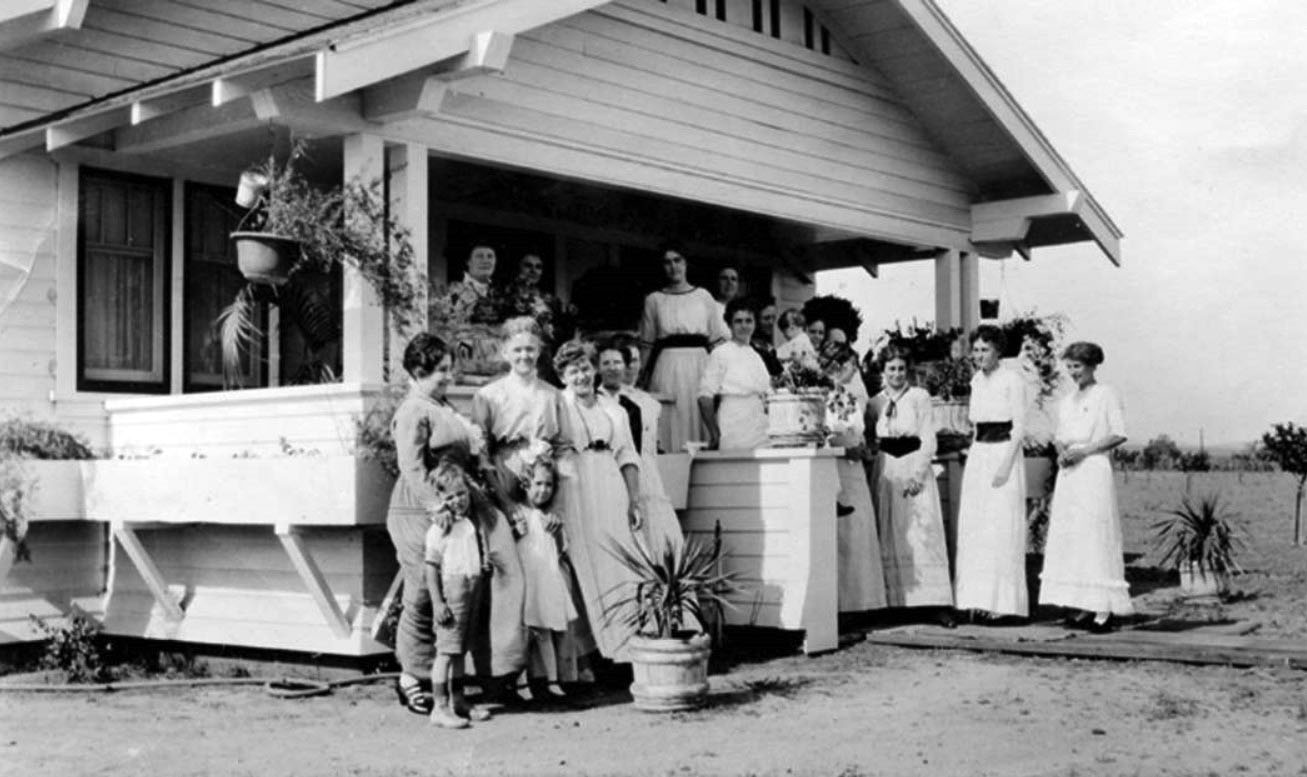 |
|
| (1921)^ - Organizers of the Women's Club at Mrs. Hageman's home, February 14, 1921. Grace Hageman brought together this group of 24 women. They were subsequently known as the Women's Community Club of Chatsworth. |
Historical Notes The Women’s Community Club of Chatsworth hoped to improve the area through their good works such as sewing for needy families and the Red Cross. They funded their work by private donations and benefits such as their 50 cent "Plate Lunch" events. Their slogan was: "Bite off more than you can chew, and chew it; Plan more than you can do, then do it; Hitch your wagon to a star, sit tight, and there you are." |
Chatsworth Reservoir
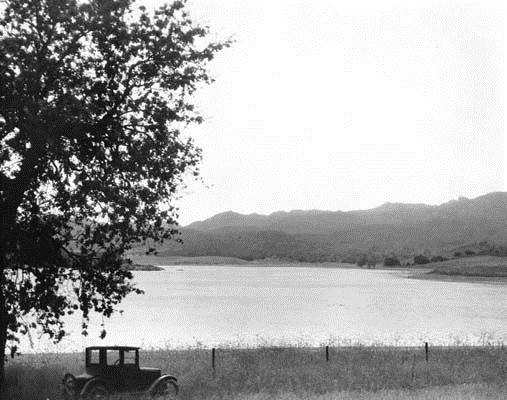 |
|
| (ca. 1925)** - View showing an early model car parked on the edge of the Chatsworth Reservoir in the Northwest San Fernando Valley. |
Historical Notes Chatsworth Reservoir was placed in service in 1919 at a time when the San Fernando Valley was a sparsely populated agricultural area. The reservoir has two earthfill dams which provided an initial capacity of 7,400 acre-feet and a high water elevation of 884.3 feet. Click HERE to see Construction of the Chatsworth Reservoir. |
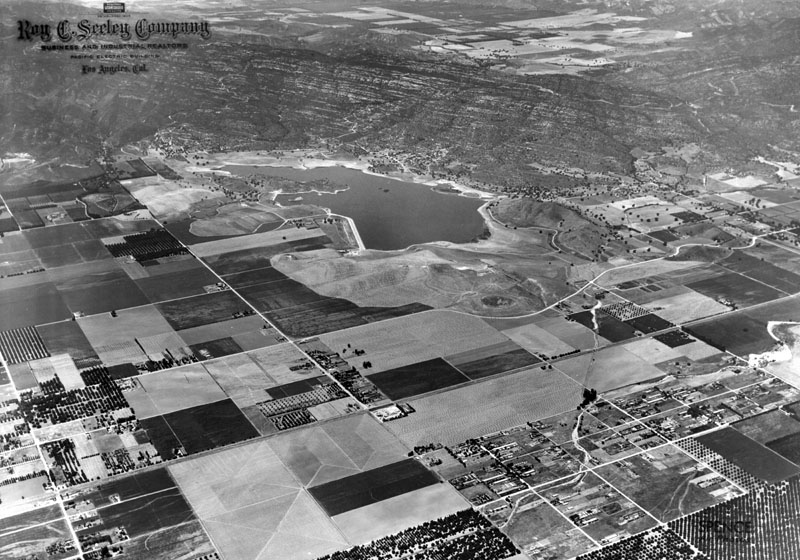 |
|
| (ca. 1920s)* - Aerial view northwest across Chatsworth Reservoir to the Simi Valley. The intersection of Roscoe and Topanga Blvds. can be seen in the center-left of the photo. |
Historical Notes For many years Chatsworth Reservoir served as the principal water storage facility in the western San Fernando Valley, serving the irrigation needs of agriculture. At various times during this period, improvements to the reservoir were constructed to increase its capability to provide the required water supply. The most significant improvement occurred during 1930 and 1931 when the dams were partially reconstructed to increase the high water level of the reservoir 5 feet to elevation 889.3 feet and the capacity to 9,840 acre-feet. As the area served by Chatsworth Reservoir was subdivided and developed to meet the demands for increased housing, the character of the West San Fernando Valley changed from an agriculture to urban setting. This transition gradually changed the requirements for Chatsworth Reservoir and its storage was increasingly used to supply residential and domestic drinking water, emergency requirements and continued agriculture uses. |
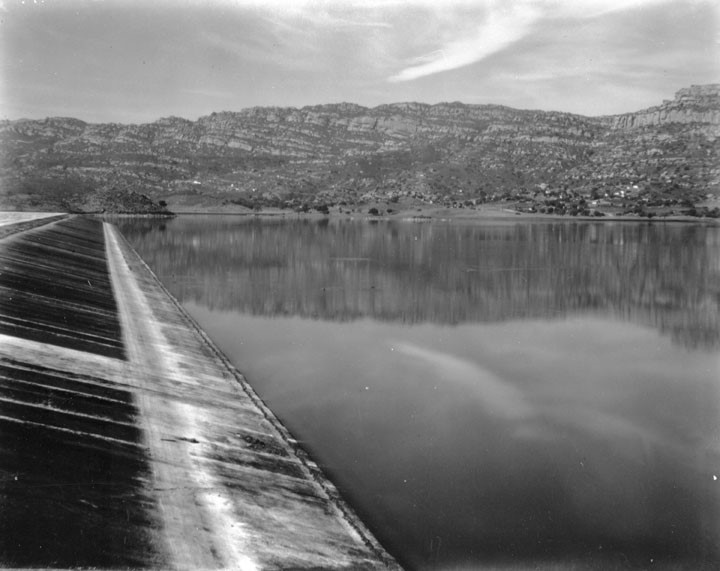 |
|
| (1930s)** - View showing the Chatsworth Reservoir and one of its two cement-lined dams with the Santa Susana Mountains seen in the background. |
Historical Notes After the Sylmar Earthquake of 1971 the reservoir was placed out-of-service and permanently retired. Since then, 150 acres has been handed over to Rec. and Parks for recreational use. Another 30 acres has been converted to an ecology pond for the habitat of migratory birds.* Click HERE to see more Early Views of the Chatsworth Reservoir. Also, click HERE to see more Early L.A. Water Reservoirs. |
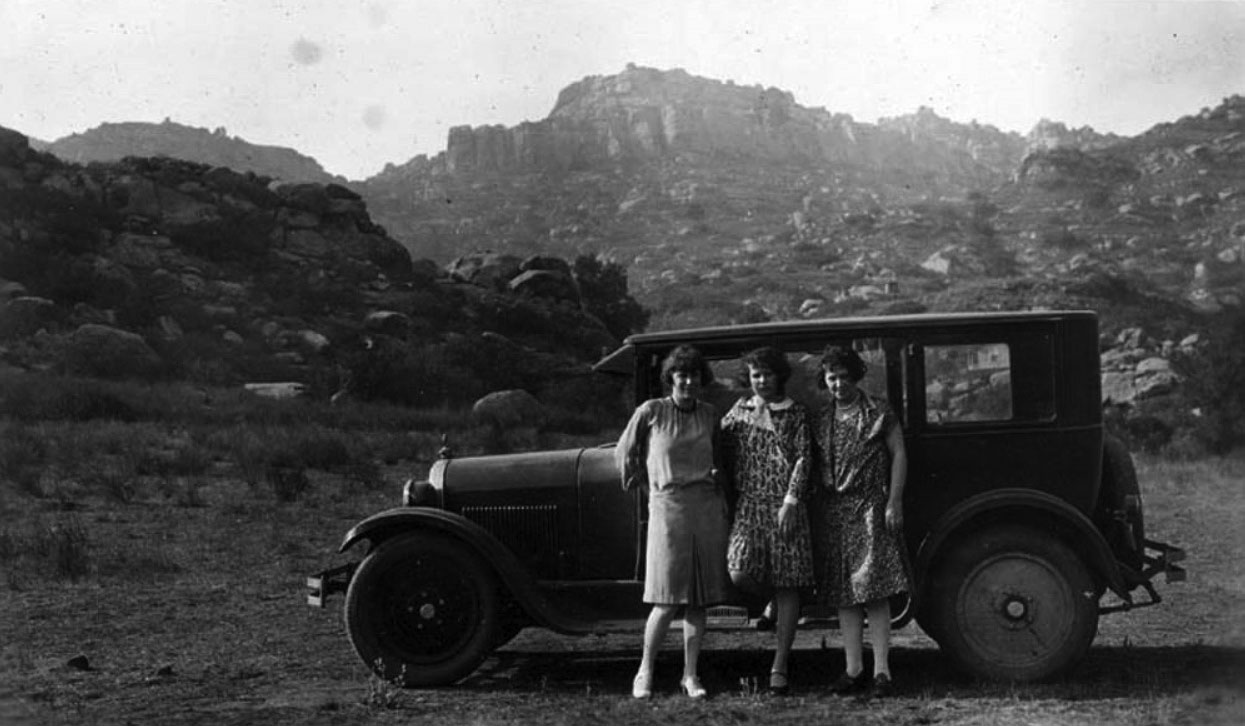 |
|
| (1928)^ - Jessie, Mill & Winsome with Homer Halverson's automobile at the base of the Santa Susana Mountains in Chatsworth |
Brant Ranch
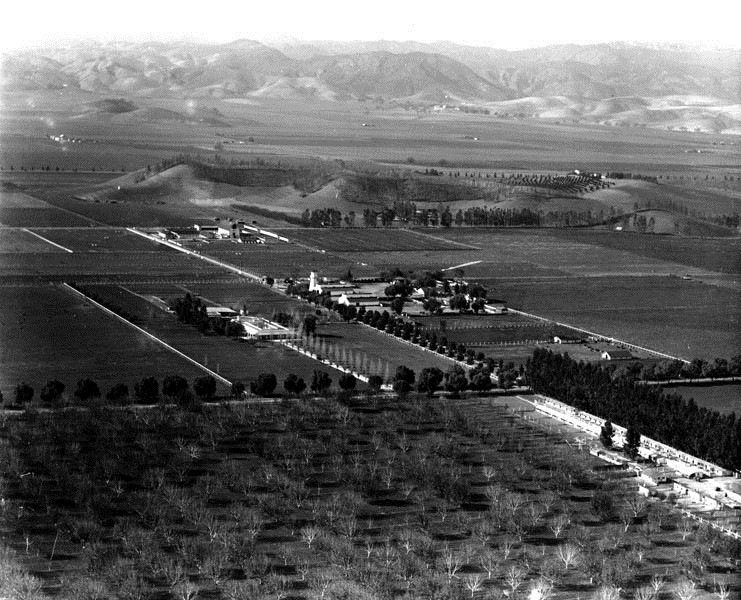 |
|
| (1924)* - Aerial view of Owensmouth just north of Girard (now Woodland Hills/Warner Center) looking northwest. Brant Ranch is seen at center of photo. Oxnard Street (Burbank Blvd?) runs diagonally from lower-right to upper-left. Tree-lined Canoga Avenue runs from left to right in the foreground. |
Historical Notes In 1910, Otto F. Brant (along with Gen. H. G. Otis, Gen. M. H. Sherman, H. J. Whitley, and Harry Chandler) was one of the five original investors in the Suburban Home Company (aka The Syndicate). Each of the major partners put up $100,000. In return Brant took 850 acres of land at Ventura and Topanga Canyon Boulevards, later to be known as the Brant Rancho, where his son created a model ranch for the world’s largest pure-bred Guernsey dairy herd of dairy cattle. |
 |
|
| (1913)^ – View showing workers harvesting cabbage on Brant Ranch. The ranch was located in Girard, south of Ventura Boulevard. This is noted in the upper right hand corner of the image with an arrow. Raymond Bayly is shown in the foreground. Photo Courtesy: Beverly Daic Taber. |
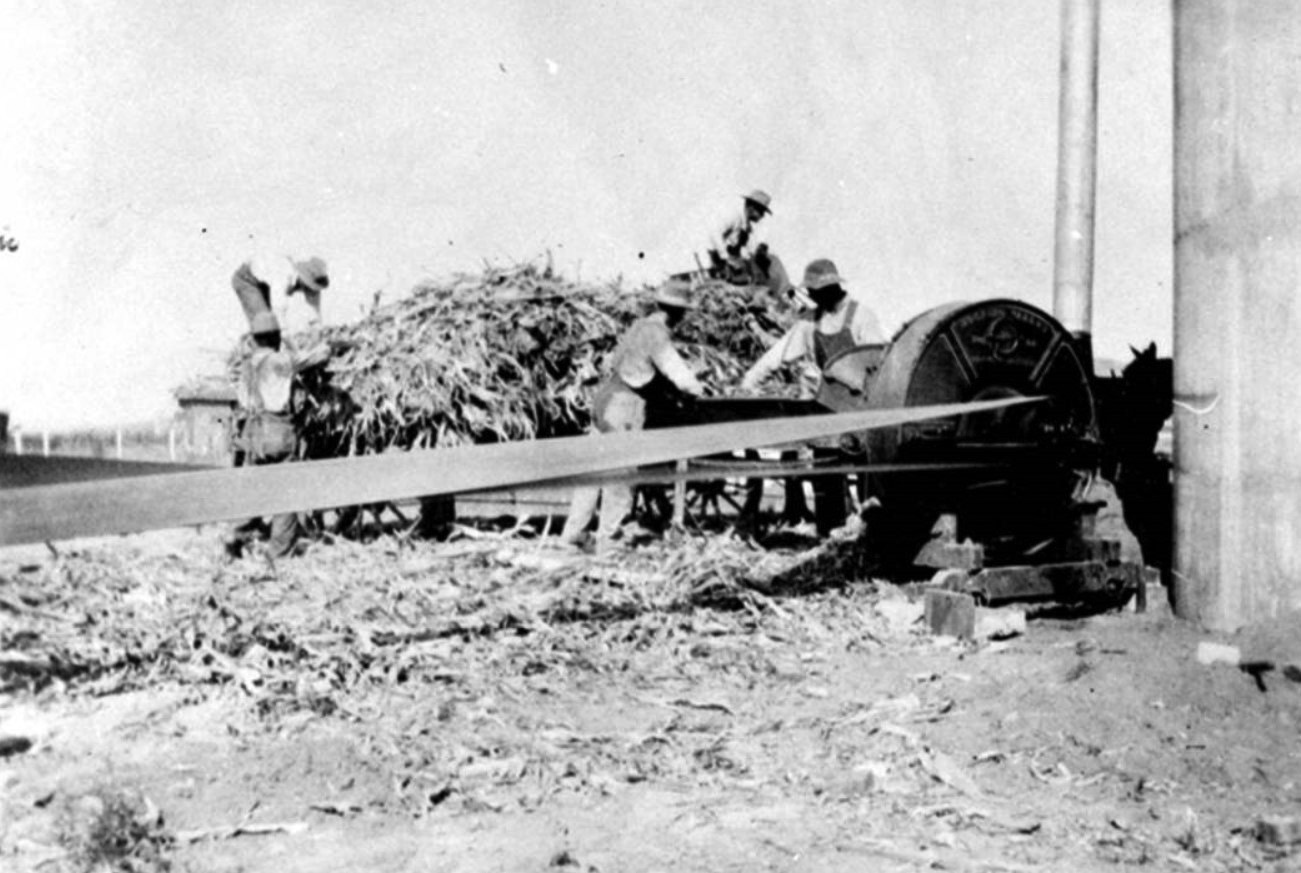 |
|
| (1913)^ - Grinding green corn at the Brant Ranch, Woodland Hills/Girard. Joe Daic is visible on the back of the wagon. Photo Courtesy: Beverly Daic Taber. |
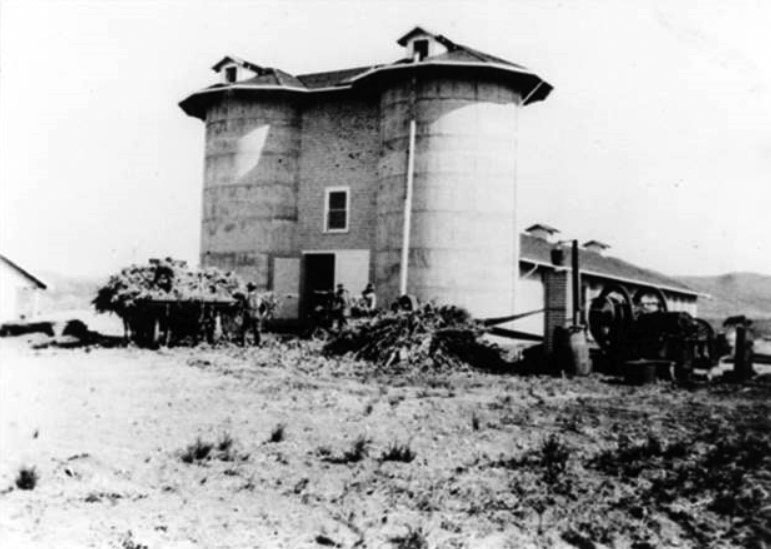 |
|
| (1913)^ - View of silos at Brant Ranch, Woodland Hills/Girard, 1913. Located on the mountain south of Chalk Hill visible in background. |
Historical Notes D. O. Brant was the manager and one of the owners of the Brant Rancho, breeders of registered Guernsey cattle.#^ |
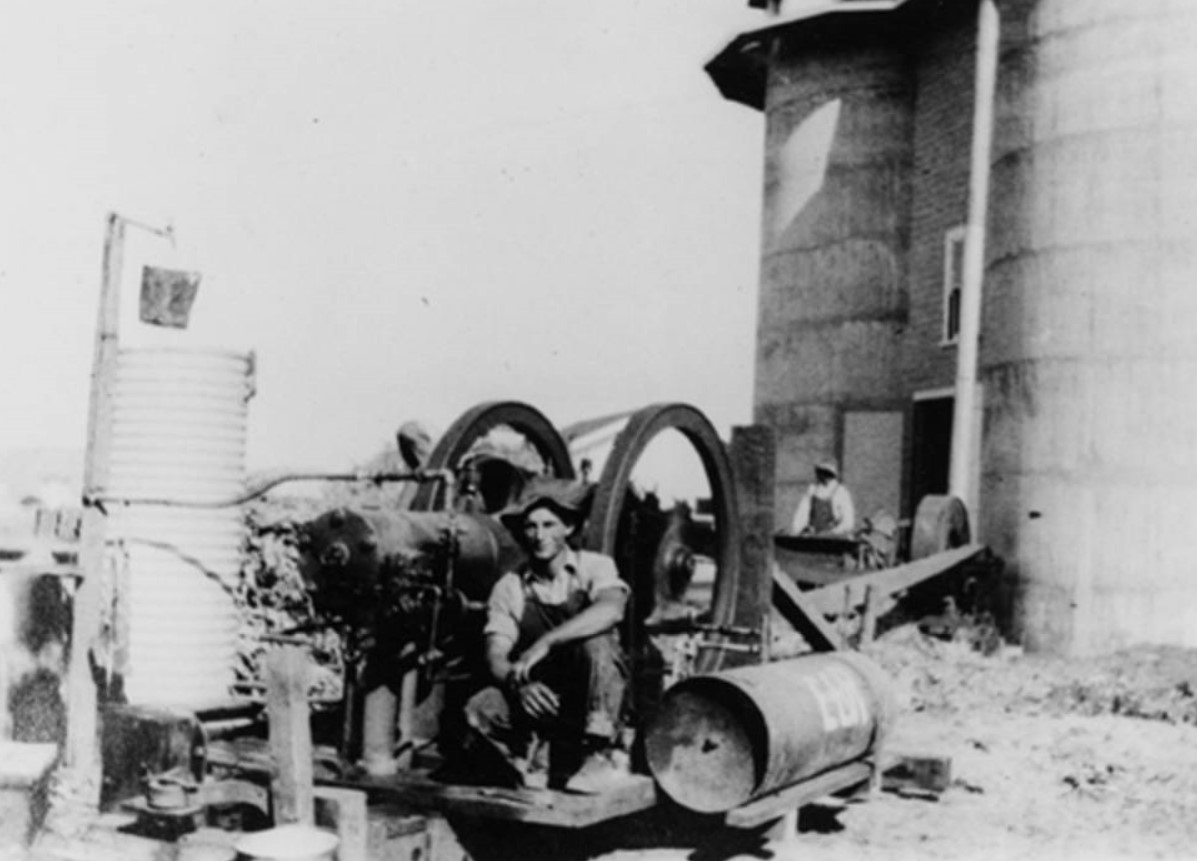 |
|
| (1913)^ – View showing Joe Daic in front of the water pump and silos on the Brant Ranch, Woodland Hills/Girard. |
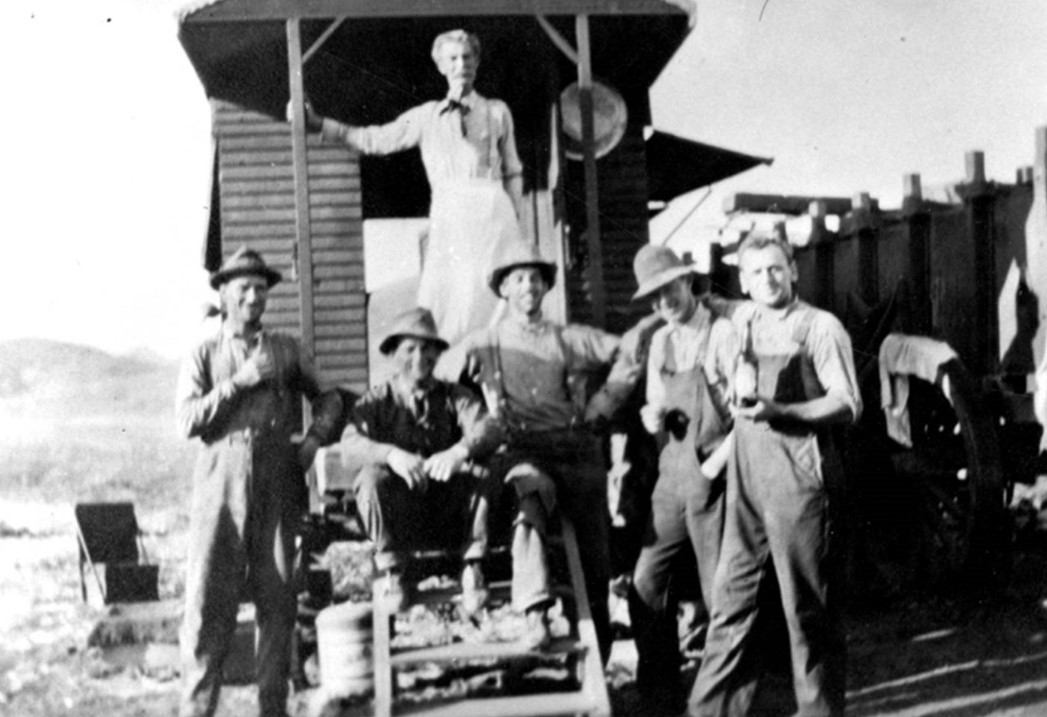 |
|
| (1913)^ - The cook's wagon on Brant Ranch, Woodland Hills/Girard, with the harvester crew. Joe Daic is visible sitting on steps. The man at the right is holding a bottle of wine or whiskey (?). |
Girard (Woodland Hills)
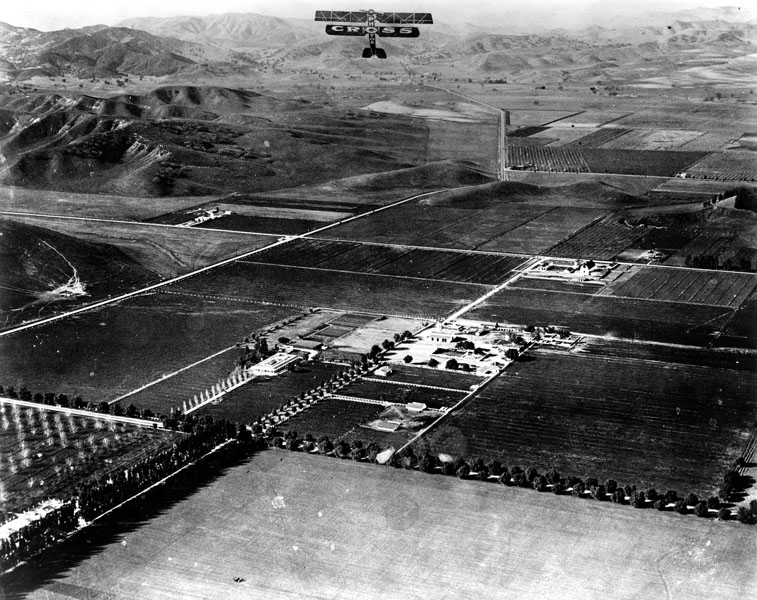 |
|
| (1924)* - Aerial view of of Girard (now Woodland Hills/Warner Center) looking southwest. Brant Ranch sits at the center of the photo. The intersection of Canoga Avneue and Oxnard Street (Burbank Blvd?) is at lower center-left, with Oxnard running diagonally from lower-left to upper-right. Ventura Boulevard runs from left-center to top-center (Calabasas). |
Historical Notes TIn 1922, Girard Kleinberger bought 2,886 acres in the west San Fernando Valley and founded the town of Girard. He sought to attract residents and businesses by developing an infrastructure, advertising in newspapers, and planting 120,000 trees. His 300 pepper trees forming an arch over Canoga Ave. between Ventura Boulevard and Saltillo St. are Los Angeles Historic-Cultural Monument #93 in 1972 (Click HERE to see the LA Historic-Cultural Monuments List).*** |
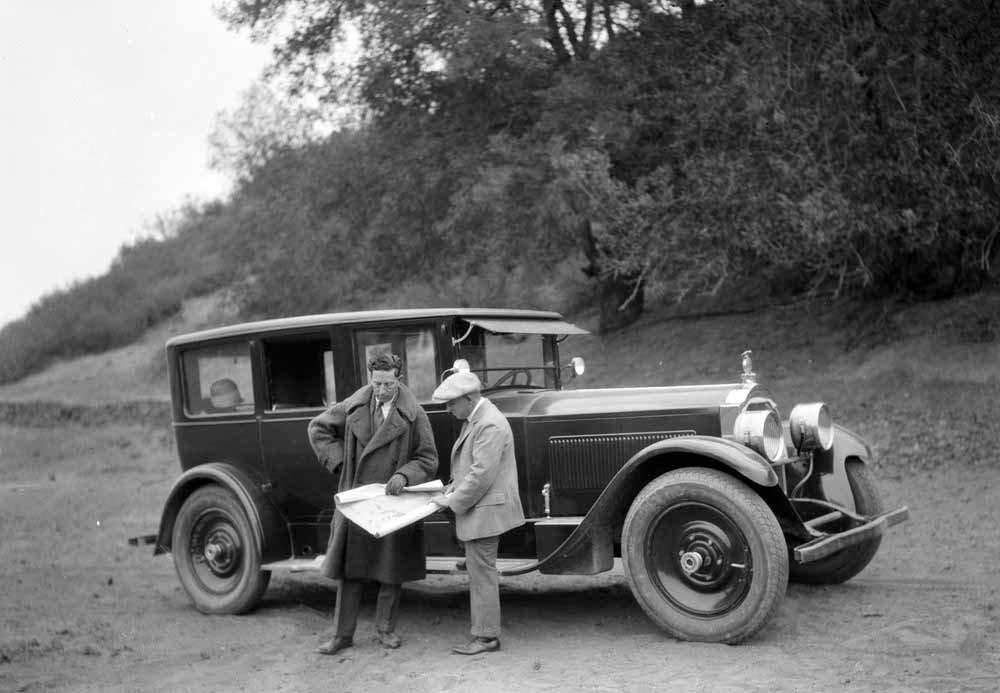 |
|
| (1924)^^ – View of Victor Girard, left, surveying the hillside and making plans for his new West San Fernando Valley development. |
Historical Notes Victor Girard Kleinberger was a land huckster with big dreams. Born in Kentucky, he began his sales career peddling Persian rugs -- fakes, of course -- door to door. Girard's modus operandi was to shove the rolled-up rug into the door frame (thus preventing the door from being slammed shut on him) and begin coughing profusely -- all the while mumbling about tuberculosis and priceless rugs. It was a ruse that apparently worked, and by 1899, with his fortune already made, the 18-year-old Girard (he had dropped his last name) headed west to Los Angeles, where he branched out into other enterprises, including real estate.*## |
 |
|
| (1924)^ - Aerial view looking north on Topanga Canyon Boulevard, Girard (later Woodland Hills). Brant Ranch can be seen at upper-right. |
Historical Notes Girard (later to become Woodland Hills) is seen in the later stages of subdividing, paving and installation of utilities. Topanga Canyon Boulevard runs away from the camera from lower right to the middle distance with the residential streets radiating left and right. First street at the bottom is Dumetz Road and then, in order, Providencia, San Miguel, De La Osa, Velicata, Lopez, Celes, Martinez, Galvez, De La Guerra, Crespi, Avenue San Luis, Del Valle, Costanso and finally Ventura Boulevard with the Girard real estate buildings built east and west along the boulevard. Road that skirts the base of the hill on the right is Don Pio Drive and on the left is San Feliciano Drive.##^ |
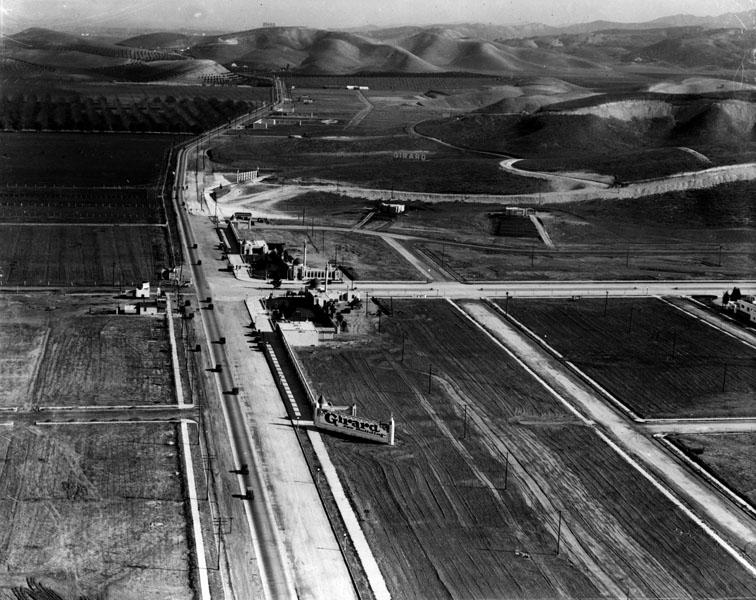 |
|
| (ca. 1924)* - View looking east on Ventura Boulevard. This is the intersection of today's Ventura Boulevard and Topanga Canyon Boulevard (center-left), in the real estate development of Girard. |
Historical Notes In 1924 Victor Girard opened a real estate office on what is now Topanga Canyon and Ventura Boulevard and built a mosque-like gate to his 2886-acre subdivision named Girard. He graded the streets, set aside land for parks and schools, and planted thousands of trees.* |
 |
|
| (ca. 1924)* - Exterior view of the Islamic-influenced Real Estate Syndicate Building in Girard, which later came to be known as Woodland Hills. |
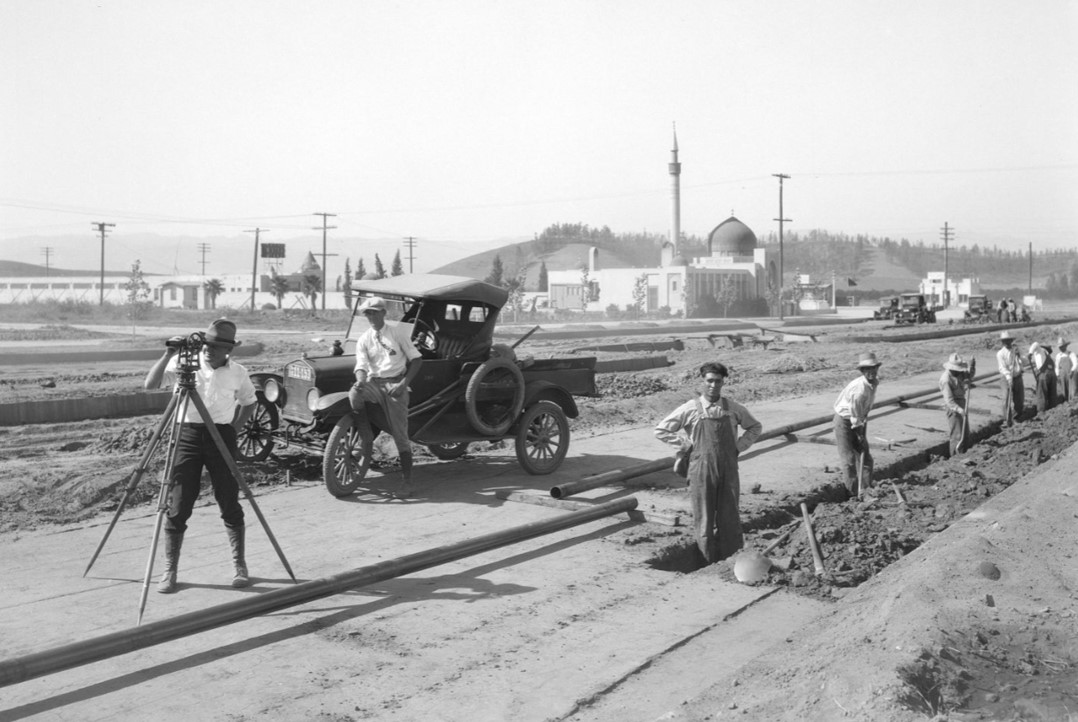 |
|
| (ca. 1924)* – View is looking north on Topanga Canyon Boulevard toward Ventura Boulevard. Workers lay pipe for the Southern California Gas Company. Girard Development offices can be seen on the southwest corner of Ventura and Topanga Blvds. |
Historical Notes In 1923, when Girard was building his town (later re-named Woodland Hills), he and a team of engineers designed a plan to lay the pipes starting in Mission Acres, and running through Reseda, Zelzah, Weeks Colony, Owensmouth, and ending at Girard. This proposal was presented to So Cal Gas, which determined that the job would cost $153,000. The West End Improvement Assn, assisted by Girard, raised $60,000 to defray the costs so that the project could begin. |
 |
|
| (1924)* - Southern California Gas Company workers lay gas lines on Topanga Canyon Boulevard for the new development in the town of Girard (later Woodland Hills). View is looking north with the mosque-style building located at the SW corner of Ventura and Topanga. (AI image enhancement and colorization by Richard Holoff) |
 |
|
| (ca. 1924)* – View looking north showing Southern California Gas Company workers laying gas mains toward one of the two mosque-like buildings for the new Girard development located on the southeast corner of Topanga and Ventura Blvds. Photo from the Ernest Marquez Collection |
 |
|
| (ca. 1925)#^*^ - View looking south on Topanga Canyon Boulevard at Ventura Boulevard. Source: Snapshots in Time |
 |
|
| (ca. 1924)*^^^ - View of the Mosque-like buildings constructed by Victor Girard Kleinberger to promote his new real estate housing development located near the intersection of Ventura and Topanga Canyon. |
Historical Notes The neighborhood was founded in 1923, named after Victor Girard Kleinberger, developer and founder. The new town was heavily promoted while bus tours from Los Angeles to the new town were offered.*^^^ |
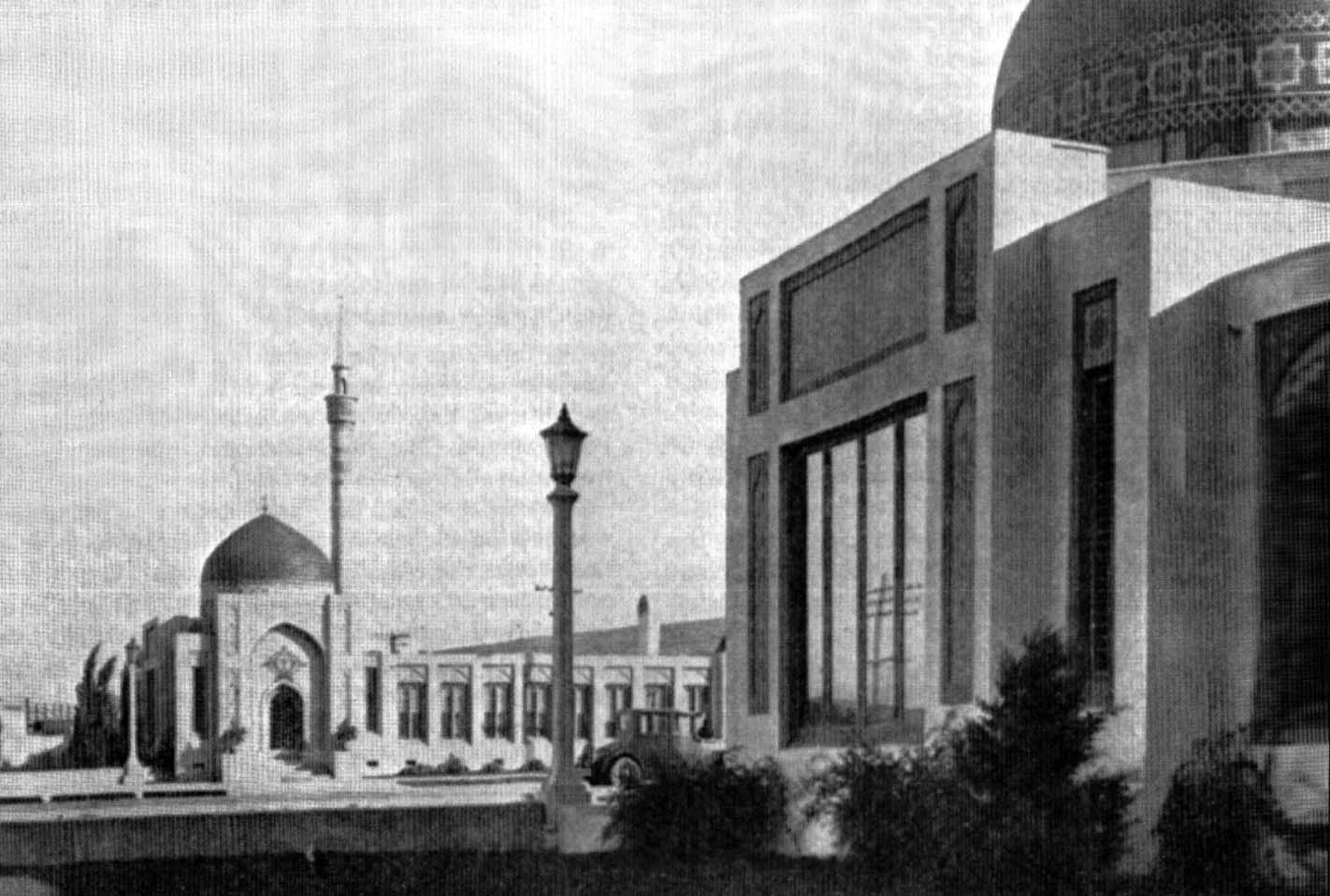 |
|
| (ca. 1925)#^*^ – Closer view showing the mosque-like gateway to Girard located on the south side of Ventura Blvd at Topanga Blvd. |
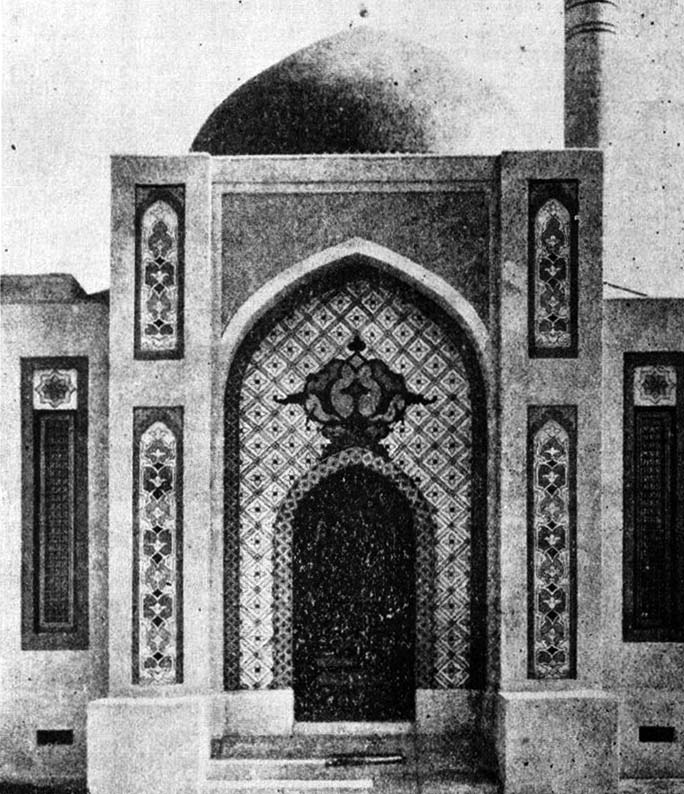 |
|
| (ca. 1924)#^*^ - Close-up view showing the beautiful Moorish Architecture of the front entrance to the Girard development administration building. |
Historical Notes This was the first commercial building to be built in the town of Girard (now Woodland Hills). It is now replaced by a gasoline station on the southeast corner of Ventura and Topanga Canyon boulevards. Click HERE to see contemporary view. |
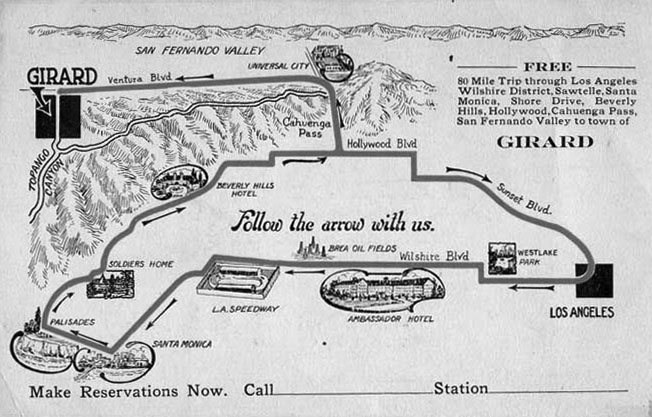 |
|
| (ca. 1924)*#^# - Map showing route of the promotional 80 Mile Tour offered by Victor Girard. |
Historical Notes Girard offered a free lunch and organized bus shuttles on a sightseeing tour that included, among other things, a stop at his new town. #*#* |
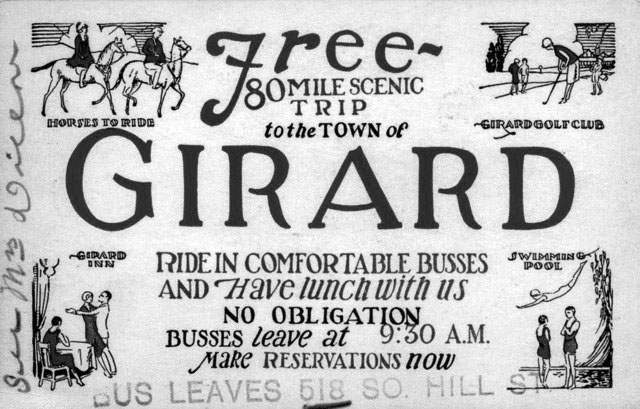 |
|
| (ca. 1924)^^ - A Ticket for one of Girard's bus tours to his new town of “Girard”. |
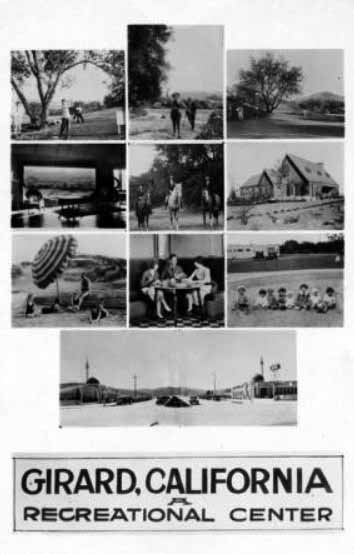 |
(1924)#^ - Postcards advertising the recreational activities of Girard.
|
Historical Notes The town of Girard officially opened in 1923 with an advertising blitz. Newspaper ads and pamphlets distributed in train depots and hotels across the region promoted the new town's location and the soon-to-be developed amenities. #*#* |
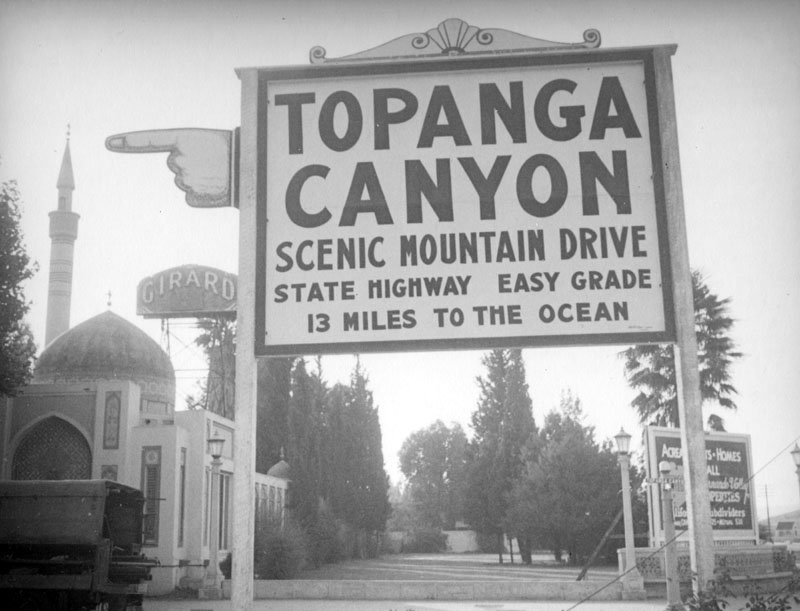 |
|
| (1937)* - A sign in front of the minaret and rooftop dome of Girard encourages the traveler to visit Topanga Canyon on a "scenic mountain drive, state highway, easy grade, 13 miles to the ocean." Topanga Canyon Boulevard (now State Highway 27) still enters Topanga Canyon at Woodland Hills and ends at the Pacific Coast Highway. |
Historical Notes Although Girard Kleinberger's early efforts were criticized as providing only a dubious facade of economic activity (local lore has it that in order to attract development he erected false store fronts on Ventura Boulevard, for which he spent time in jail), the Girard Golf Course completed in 1925 continues to operate today as the Woodland Hills Country Club, and his scheme was ultimately successful in attracting interest in the community.*^ |
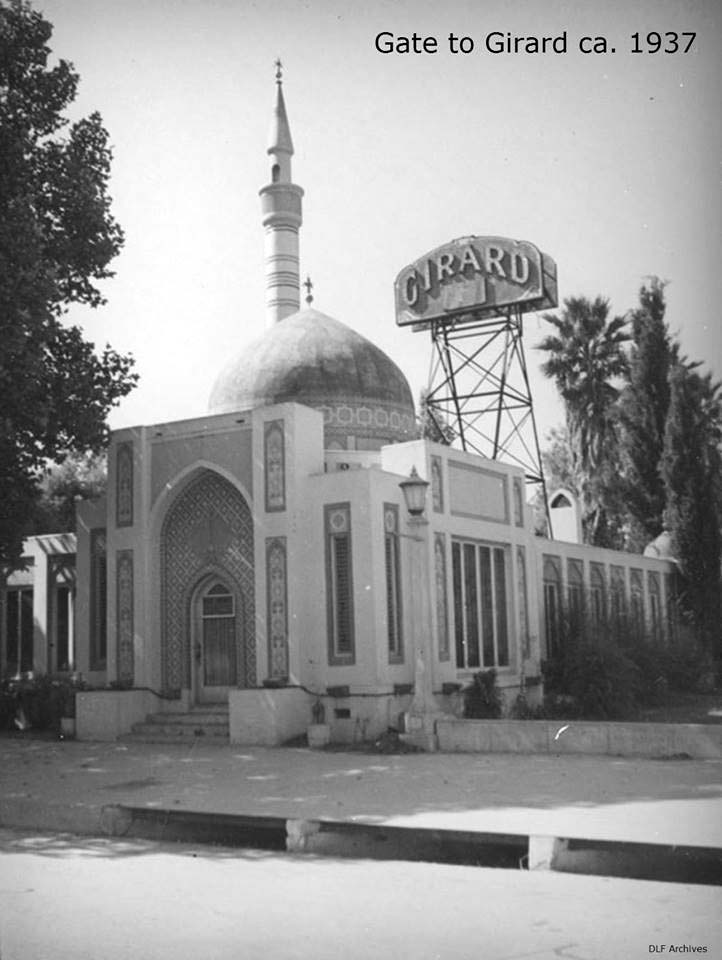 |
|
| (ca. 1937)#^*^ – Close-up view showing the mosque-like Gate to Girard as it appeared on Ventura Boulevard circa 1937. A bulb light sign built on scaffolding lets everyone know they have arrived to Girard. |
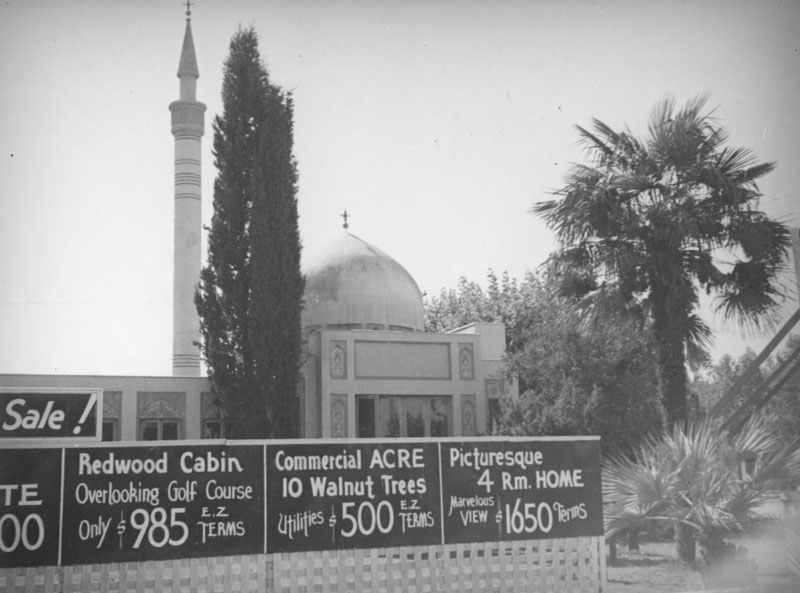 |
|
| (ca. 1937)* - The mosque like gatehouse, complete with minaret, rooftop dome, and tiled facade, can be seen behind signs advertising a sale for anyone wanting to buy into the community of Girard. The bargain is a commercial acre with 10 walnut trees and utilities for $500. A redwood cabin overlooking the golf course is just under a thousand and "E.Z terms" are available. The most luxurious, a four room home with a mountain view, goes for $1650. Interestingly there is a Palm tree on one side of the building and a Cyprus on the other accommodating all arboreal tastes. |
Historical Notes Girard is credited for planting more than 120,000 sycamores, eucalyptus, fir pine, and pepper trees across the townsite for which Woodland Hills would later be named for. #*#* |
 |
|
| (1920s)^^ - View of one of Girard's Moorish-style houses. The houses were scaled on the small side. |
Historical Notes Would-be buyers could purchase an undeveloped parcel for as little as $500, or choose from a small selection of houses that would be constructed on the lot of their choice. With an advertised "marvelous view," $1,625 bought a four-room house that could be designed in the Moorish style Girard loved so much. However, the most common pick was a small cabin that sold for $985. Sometimes placed on lots as small as 50 by 125 feet, the cabins were in line with Girard's standards and thus constructed with cheap materials and wooden foundations that sat directly on the ground. #*#* |
 |
|
| (1924)^ - Girard News Newspaper serving Girard (now called Woodland Hills), San Fernando, Van Nuys, Lankershim, Reseda, Owensmouth, Chatsworth, Rio Vista, Pacoima, Zelzah, Weeks Colony and other cities. Supplement to the paper focusing on particular cities. |
Historical Notes Unbeknownst to many of the buyers, Girard and his Boulevard Land Company added a lien on every lot in his town to help pay for all the improvements, forcing the residents to repay the funds at a later date. After the 1929 Stock Market Crash many of the residents were confronted with the debt that Girard incurred on their behalf. Many simply left—by 1932 there were only 75 families remaining. Girard and the Boulevard Land Company faced a slew of lawsuits, most of which accurately contended the company had misrepresented the land it was selling. Unable to sell the heavily taxed 1,350 acres it still possessed, the Boulevard Land Company eventually folded. #*#* |
 |
|
| (late 1930s)#^*^ – Aerial view looking east on Ventura Boulevard at Topanga Boulevard. |
Historical Notes By 1941, the community was renamed Woodland Hills. Also, in the 1940s, Harry Warner of the Warner Bros. Studio, bought 1,100 acres in the area for a horse ranch and named it Warner Ranch. The modern Warner Center commercial zone is named for Harry and features high-rise buildings, hotels, and shopping centers.*^ |
Before and After
 |
|
.jpg) |
|
| (ca. 1924)* vs. (late 1930s)#^*^ - Comparative view showing the changes in the town of Girard over a dozen plus years. |
Ventura and Glade
 |
|
| (1927)^ – View showing a woman standing by an early model car in front of a small cottage-like structure located on the NW corner of Ventura Boulevard and Glade Avenue. |
Historical Notes This little cottage at the corner of Ventura Blvd and Glade Ave was built in 1927. Most recently it was a coffee shop and outdoor cafe called The Secret Garden. Before that it was a gift shop called Dove Hill. As of 2023 the little cottage structure was still there. Click HERE for contemporary view. |
 |
|
| (1927)^.^ – Aerial view showing the little cottage building seen in previous photo standing on the NW corner of Ventura Blvd and Glade Ave. Photo courtesy of Dan Fields. |
Then and Now
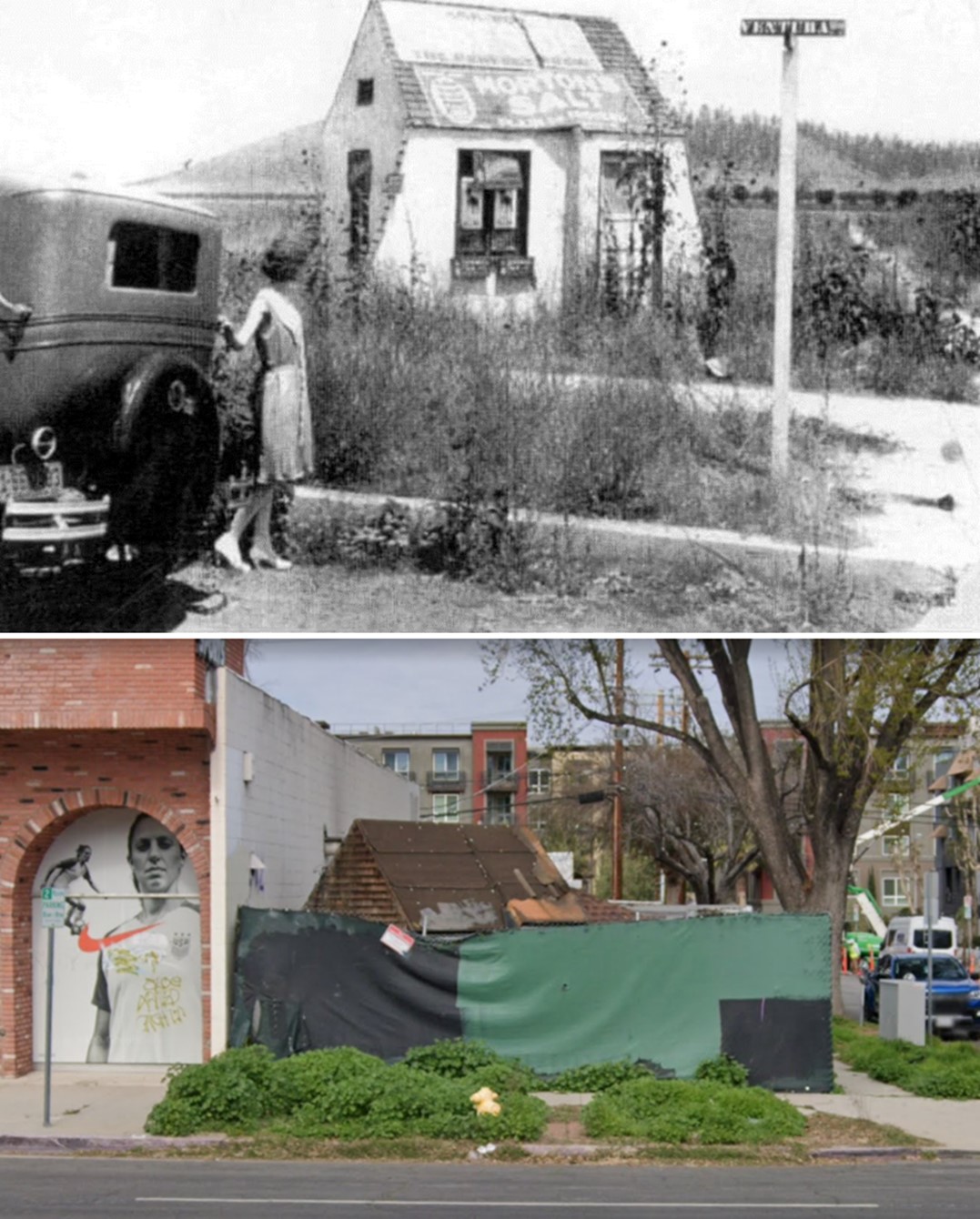 |
|
| (1927 vs 2023)* – Looking at the NW corner of Ventura Boulevard and Glade Avenue in Woodland Hills. This little cottage has stood at the same corner for almost a century. |
* * * * * |
Girard (later Warner Ranch)
 |
|
| (1930s)^ – View showing the town of Girard in an area that would become Warner Ranch and later Warner Center, Woodland Hills. |
Historical Notes During the 1940s, Harry Warner of Warner Bros. acquired over 1,000 acres of land in what was then Girard. Called the Warner Ranch, he built his home there and raised thoroughbred horses on the surrounding property. A portion of this land is now the Warner Center in Woodland Hills.^ Click HERE to see more Early Views of Warner Ranch. |
* * * * * |
Weeks Poultry Colony
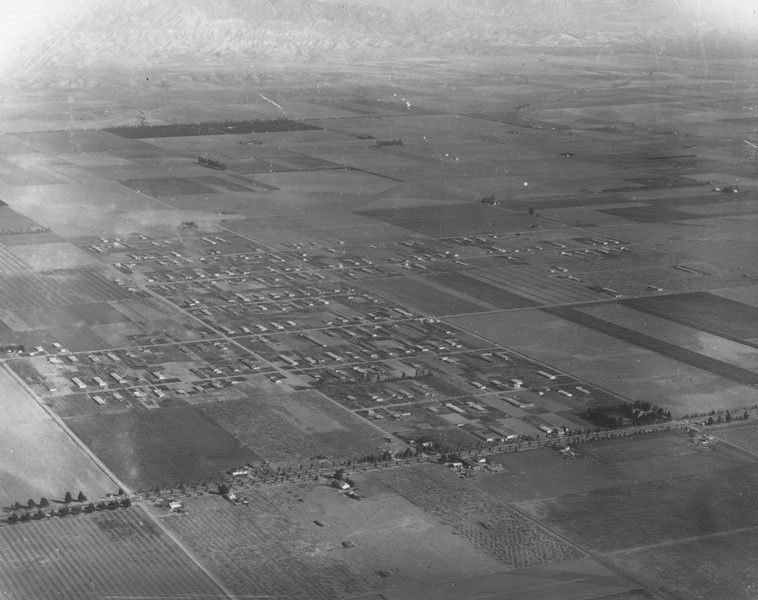 |
|
| (1925)* - Aerial view looking northeast showing the Weeks Poultry Community in Owensmouth (later Winnetka), founded by Charles Weeks as a utopian colony. The intersection at lower left is Sherman Way and Mason Avenue. |
Historical Notes In 1916, Charles Weeks established the "Weeks Poultry Colony," also known as Runnymede, on land near his Palo Alto farm in Northern California. With a heavily promoted motto of "one acre and independence," Mr. Week’s experimental utopian community grew quickly, housing 400 families by 1922. Adding to the success of the colony was his monthly magazine publication called Intensive Little Farm which attracted new buyers to the area and kept the area thriving for years, peaking at over 1,000 citizens by the mid-1920s. In 1923, Weeks moved out of Northern California and engaged himself in actively promoting a new colony in Owensmouth. He had been invited to the San Fernando Valley by the Los Angeles Chamber of Commerce in 1920 to establish a series of one-acre farms in the area that would emulate the success of his Los Altos "poultry colony." The colony Mr. Weeks created eventually developed into a small farming community, which actively engaged in uplifting the spirit of its members, and aided in the social, intellectual and artistic enlightenment of the region.^ |
.jpg) |
|
| (1927)* - Aerial view looking northwest showing the Weeks Poultry Community. The intersection at lower-right is Sherman Way and Winnetka Avenue. The large empty lot on the northeast corner is today the home of Sutter Middle School. |
Historical Notes Weeks, the 50-year-old philosopher-entrepreneur, began building his egg-based Eden along Sherman Way, a wide boulevard lined with palms and roses. It was the only paved road in the West Valley. A trolley called "Big Red" ran down its center and made daily round-trips to Los Angeles. "Each man must create his own little world," Weeks liked to say. "None that others prepare for him will ever satisfy." The Valley community of Owensmouth was the ideal place for little-world building, Weeks argued. Its soil was rich, there was abundant water because of the Owens Aqueduct and nearby Los Angeles was a ready and growing market for the settlers' eggs. Weeks disseminated his philosophy of collective self-reliance in a widely distributed magazine called "Intensive Little Farms" and in a book he sold by mail for $1. He described the Valley project with characteristic confidence as "the greatest economic work of the age, bringing peace of mind, health of body and an abundant living to thousands bound in slavery by wage-earning and too much business." ^^^ |
.jpg) |
|
| (1925)* - Aerial view looking southwest showing the one-acre farms located in the Weeks Poultry Community. The intersection at lower-right is Winnetka Ave and Saticoy St. |
Historical Notes By 1923, Weeks sold the first acre of his Colony to Jenja Beckman of Los Angeles, when the lots went for $1,250. By the end of the year, 41 families had established their acre plots in the tract bounded by Winnetka and Oso avenues and Leadwell and Lanark streets.......The Weeks Colony became a Valley institution, listed on maps and well known in the surrounding towns. Weeks deeded five acres at Winnetka and Roscoe Boulevard to the city for an elementary school (later becoming Winnetka Elementary School). The colony grew to more than 500 families and had its own egg co-op, warehouse, and packing plant. #^# |
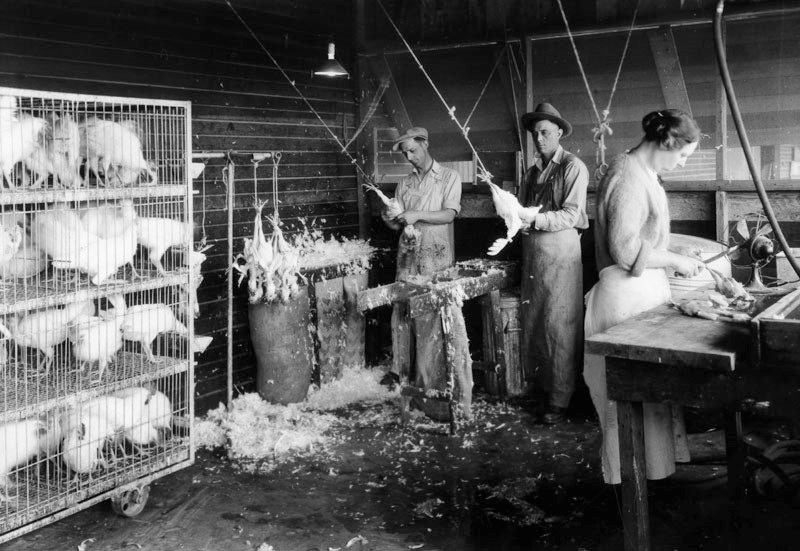 |
|
| (1927)* - Workers plucking chickens at Weeks Poultry Ranch, also known as the Charles Weeks Poultry Community. |
Historical Notes Charles Weeks established new methods of raising poultry, concentrating birds into coops. Previous to this time, it was a commonly accepted farming practice to raise chickens in large, space consuming, chicken runs. The "Weeks Poultry Method" of raising poultry in compact houses became so successful that visitors from all over the world began arriving at Mr. Weeks' farm to study and learn his method.^ |
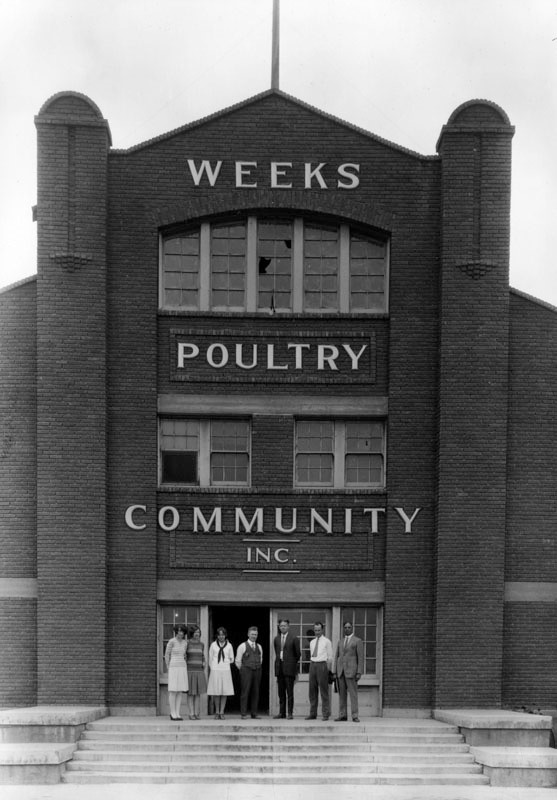 |
|
| (1927)* – View showing a group of people posing in front the Weeks Poultry Community, Inc. office building located at 21228 Sherman Way, Owensmouth (later Winnetka). |
Historical Notes Unfortunately, the Great Depression and the dramatic downturn of the Los Angeles economy drastically affected both the Owensmouth and Runnymede communities. By 1932, many of the farms faced bankruptcy and Mr. Weeks himself lost almost everything. With the failure of the poultry colonies, Mr. Weeks relocated to Florida, where he lived out the remainder of his life growing papayas, raising fishing worms and skin diving. Many of the colony’s residents also fled facing dire economic situation and a lot of the homes were abandoned. Some remained, though, and became longtime residents. Those that stayed behind renamed the neighborhood Winnetka in 1934, after Weeks' former hometown, Winnetka, Illinois. Also, Runnymede Street was named after Weeks' first poultry farm in Northern California. Charles Weeks died in Florida in 1964 but the impact of his communal experiment can still be seen in some areas of both Palo Alto and Winnetka.^ |
* * * * * |
Tarzana - Casa Mil Flores
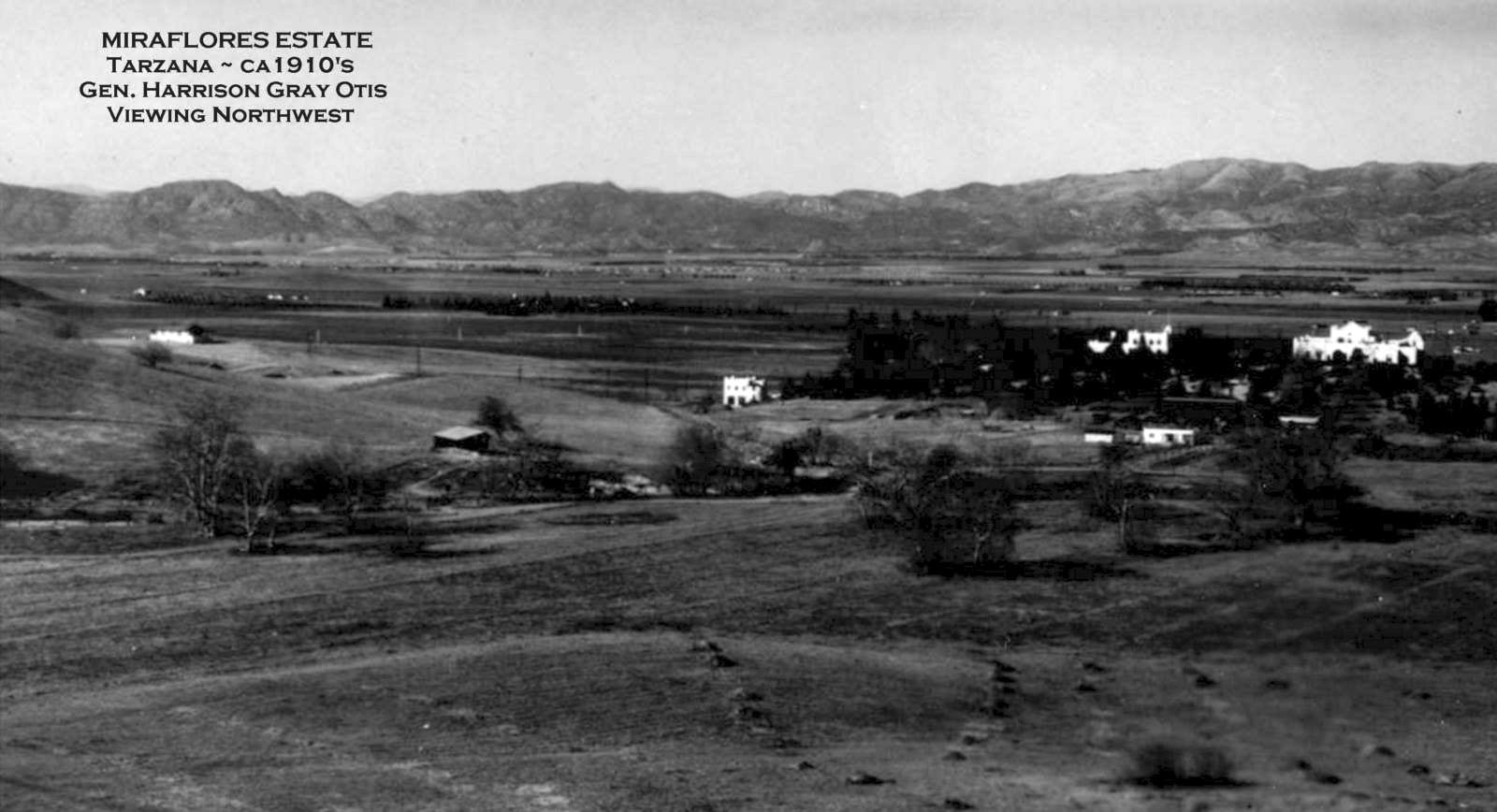 |
|
| (1910s)^ – View looking northwest showing a wide open San Fernando Valley with very little development. The buildings seen on the right are part of the “Mil Flores Estate” belonging to Harrison Gray Otis. In the distance Oat Mountain is seen above the main house and Stony Point is visible in the center. |
Historical Notes The area was purchased in 1909 by the Los Angeles Suburban Homes Company. LA Times founder and publisher General Harrison Gray Otis invested in the company and also personally acquired 550 acres in the center of modern-day Tarzana.*^ |
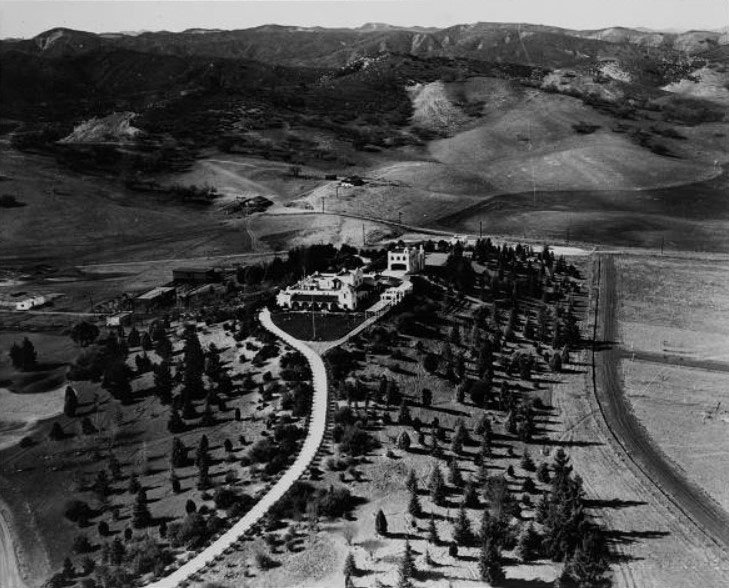 |
|
| (ca. 1920s)#* - Aerial view looking south of “Casa Mil Flores”, Harrison Gray Otis' Spanish-style home in southwest corner of the San Fernando Valley in what is now known as Tarzana. Main house and driveway, visible in center of photo, and other ranch buildings are along a hilltop, surrounded by trees. Valley and mountains in background. |
Historical Notes The Mil Flores Estate was described as ‘A magnificent dwelling of the most modern hollow tile and concrete construction built on a commanding knoll a half mile back from the highway (Ventura Blvd.), from which one of the finest and most comprehensive views of the entire valley is had.' The residence was built by General Otis, publisher of the Los Angeles Times, and was occupied by him as a home at the time of his death (1917). In 1919, Edgar Rice Burroughs (creator of the Tarzan character) purchased the ranch from the Estate of Harrison Gray Otis. General Otis called the ranch “Rancho del Cabrillo” and the home he constructed on the Southerly hill fronting along present day Tarzana Drive, he called “Casa Mil Flores.” The roughly 100 acre Burroughs or Tarzana Tract ran from present day Ventura Boulevard to Tarzana Drive and was bounded by Mecca Avenue and Avenida Oriente. The Tract was possibly recorded as early as 1921. Burroughs was busy in 1922 trying to promote the sale of lots of the tract. #^* Burroughs also sold 120 acres to found the El Caballero Country Club. |
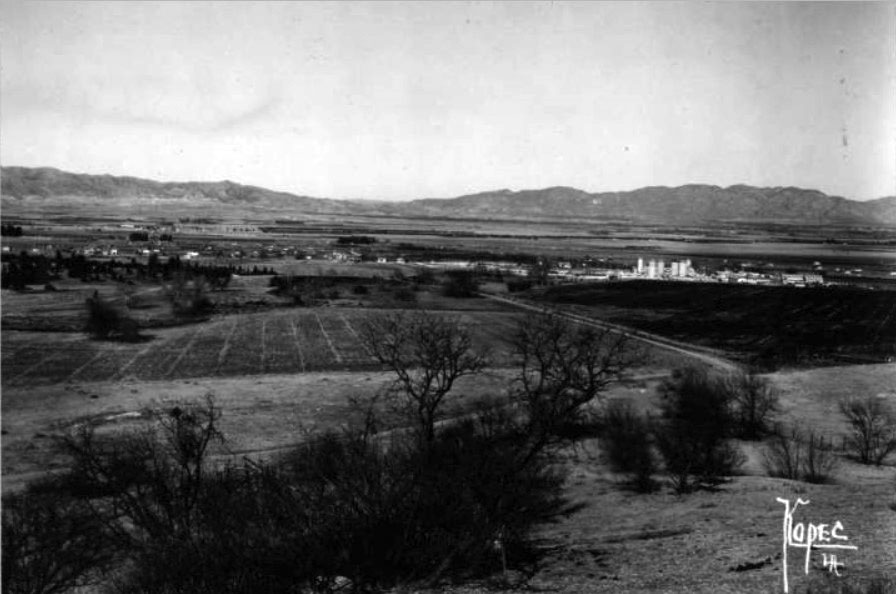 |
|
| (ca. 1920s)#* - View looking north towards the San Fernando Valley floor from near the “Casa Mil Flores”. The silos (center-right of photo) are milk storage tanks at the Adhor Milk Farm, located near Ventura Blvd. between Reseda and Lindley. |
Historical Notes The community was not officially named Tarzana until the Post Office was established in 1930. The Women’s Club, however, may have referred to the community by that name after taking a vote for a community name and then asking Burroughs permission to use it, which he gleefully granted in 1927.*^ |
Adohr Milk Farm
 |
|
| (1925)* – Aerial view looking southeast showing the intersection of Reseda and Ventura boulevards at center-right. Adohr Farms can be seen in the distance at Lindley Avenue and Ventura Boulevard (upper center-right). |
Historical Notes The corner of Ventura Boulevard and Lindley Avenue in Tarzana was once the Adohr Milk Farm. However, the land was part of a cattle ranch empire owned by a Southern California family who later established the city of Malibu. |
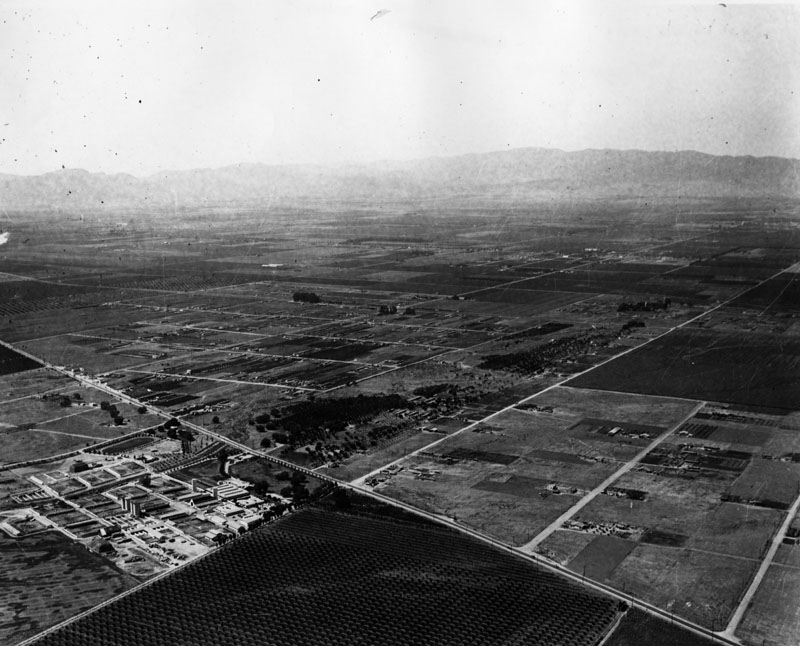 |
|
| (1925)* - Aerial view of Lindley Avenue at Ventura Boulevard showing orchards as well as Adohr Stock Farm at the lower left of the photo. The view is looking northwest. |
Historical Notes In 1892, Frederick Hastings Rindge bought the original Spanish land grants that made up Rancho Malibu Topanga Sequit. Rindge's land purchases spanned more than 17,000 acres along the coast toward Ventura County and several miles inland over the Santa Monica Mountains into the San Fernando Valley. Rindge’s daughter, Rhoda, married Merritt Adamson and together they started the successful Dairy Farm. |
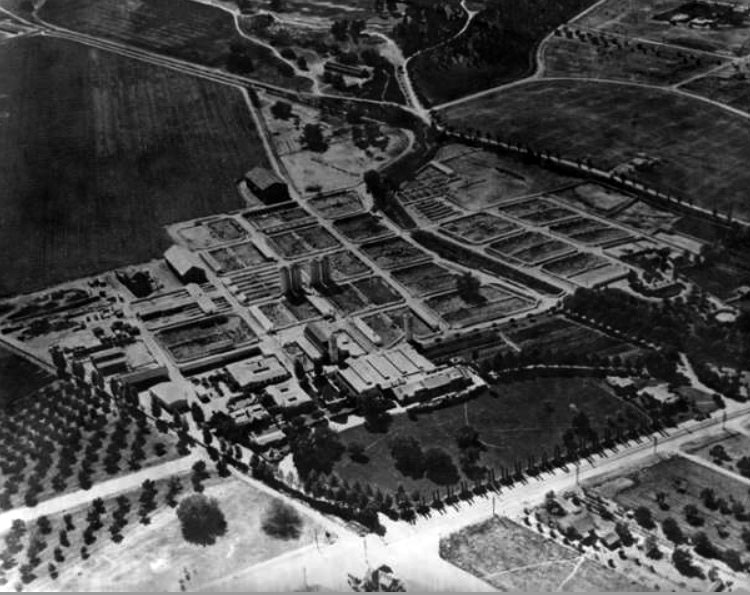 |
|
| (ca. 1930s)#^ - Aerial view of Adohr Farms looking southwest over the intersection of Ventura Blvd. and Lindley Ave. Ventura Blvd. runs diagonally from bottom-center to lower-right of photo. |
Historical Notes In 1916, Merritt and Rhoda Adamson established a dairy farm on the north slopes of the Santa Monica Mountains. To honor Rhoda, Adamson named the farm "Adohr"--his wife's name spelled backward. Adohr Farms became famous for having one of the largest herds of Guernsey cattle in the world.^^^ |
 |
|
| (ca. 1930s)^ - View looking north of Adohr Farms. The main street running left to right is Ventura Blvd. Lindley Ave can be seen in the center-left of photo. |
Historical Notes During the Depression, the Adamsons were forced to sell most of their land to pay creditors. However, the milk farm kept the family solvent. |
 |
|
| (ca. 1930s)* - A spotted calf stands staring straight into the camera while shyer siblings lie in the shade of the empty looking trough at the Adohr Milk Farm. Beyond the corral lie the milking barns and four storage tanks of milk. |
 |
|
| (ca. 1930s)^ - Feeding the Guernsey dairy cattle at Adhor Milk Farms. |
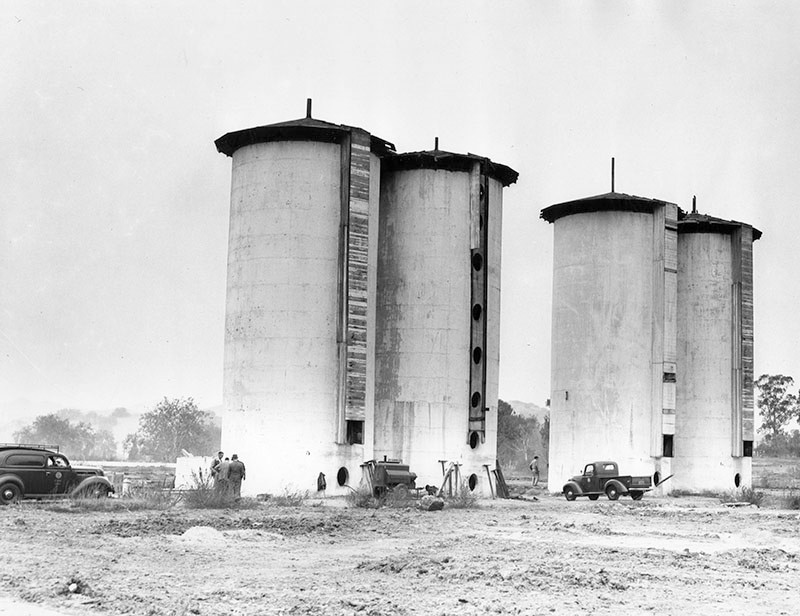 |
|
| (1948)* - View showing four 60-foot, concrete silos on the Adohr Milk Farms located at 18000 Ventura Boulevard. Photo date: October 14, 1948. |
Historical Notes In 1948, the land was sold by Merrit H. Adamson, head of the Adohr Milk Farms, to builders who planned to demolish the 31-year-old landmarks and divide the land into parcels for construction of low-cost housing for veterans.* |
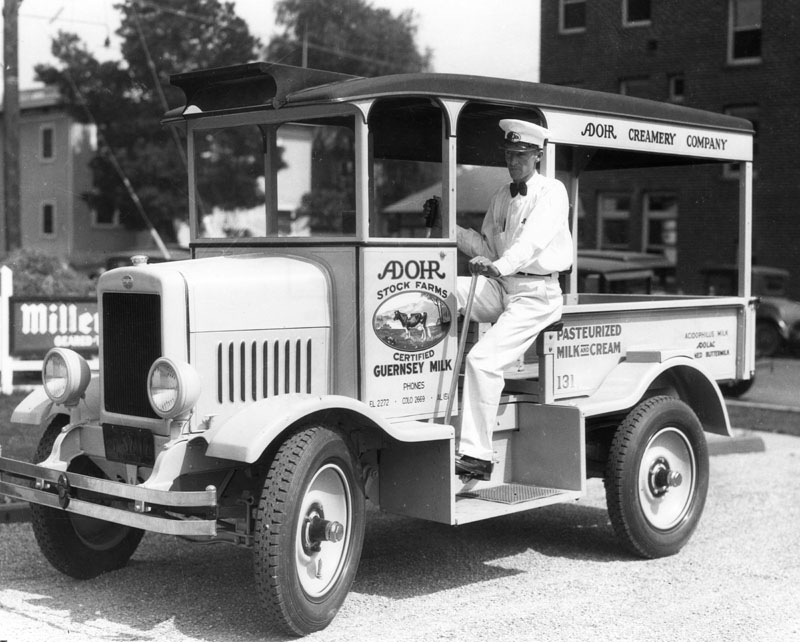 |
|
| (1931)* - A driver/milkman for Adohr Creamery Company, sits at the wheel of his delivery truck. |
Historical Notes The Adohr dairy moved to Camarillo in 1947. Adamson's son, Merritt Jr., eventually sold the dairy operation to the Southland Corp. in 1966. |
 |
|
| (1936)* - Adohr Milk Farms located at 18000 Ventura Boulevard. |
* * * * * |
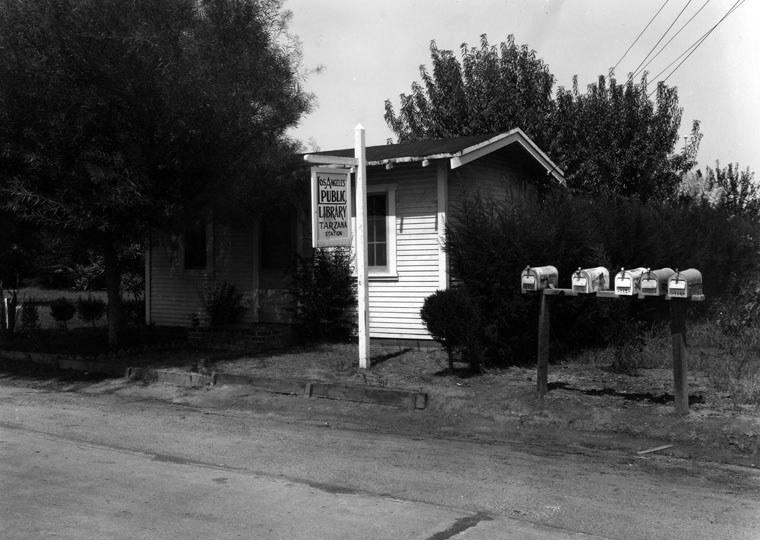 |
|
| (n.d).*#^# - View of the original Tarzana branch of the L. A. Public LIbrary (Exact location and date unknown?) |
Click HERE to see more Early Views of Tarzana |
Hollywood Country Club
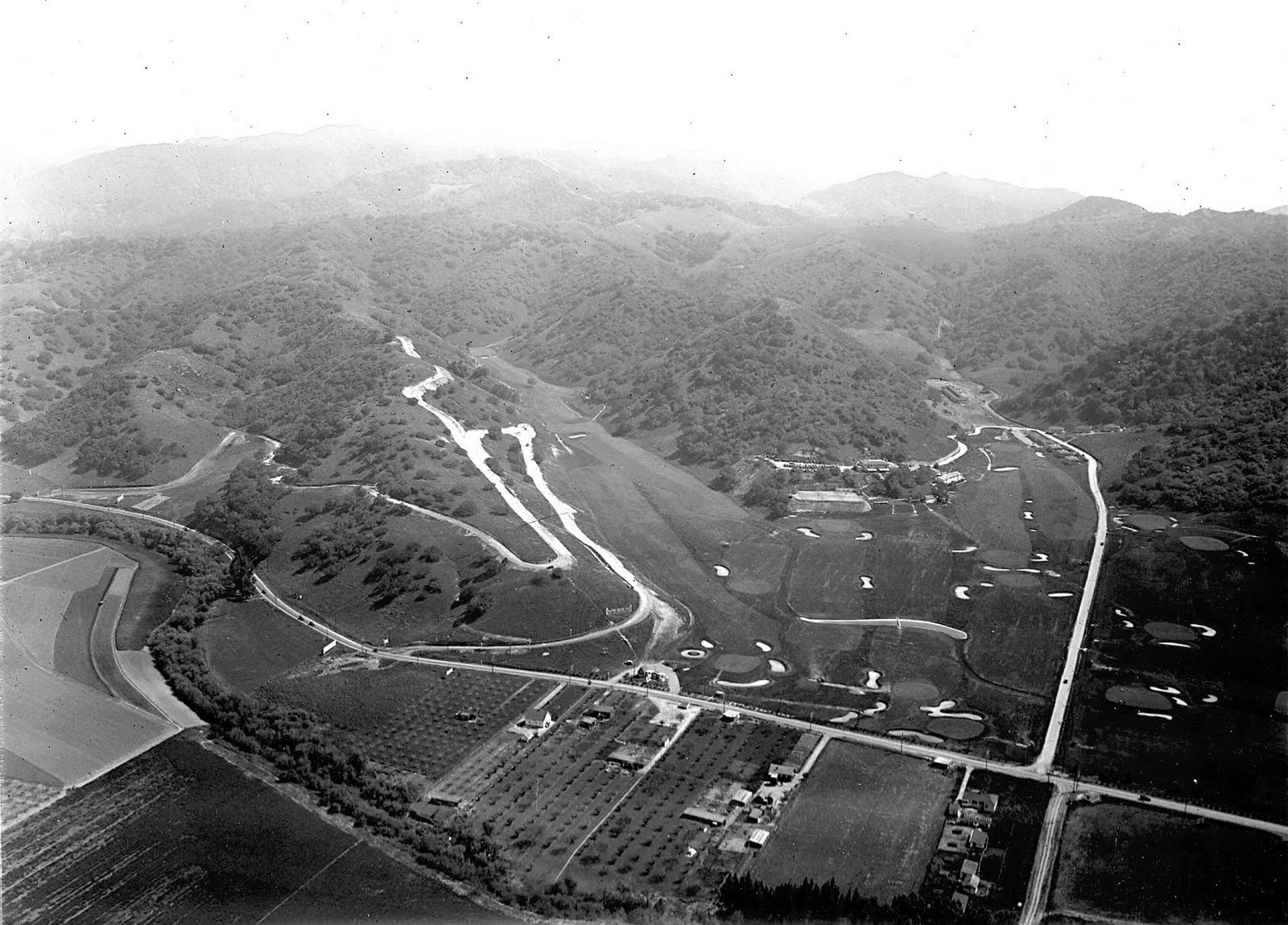 |
|
| (1925)^^# - View looking south over the intersection of Ventura Boulevard and Coldwater Canyon showing the Hollywood Country Club and adjoining areas in Studio City. |
Historical Notes In the mid-1920s, the Hollywood Country Club opened for golf and other forms of recreation. Several film stars of the era were investors.^^# |
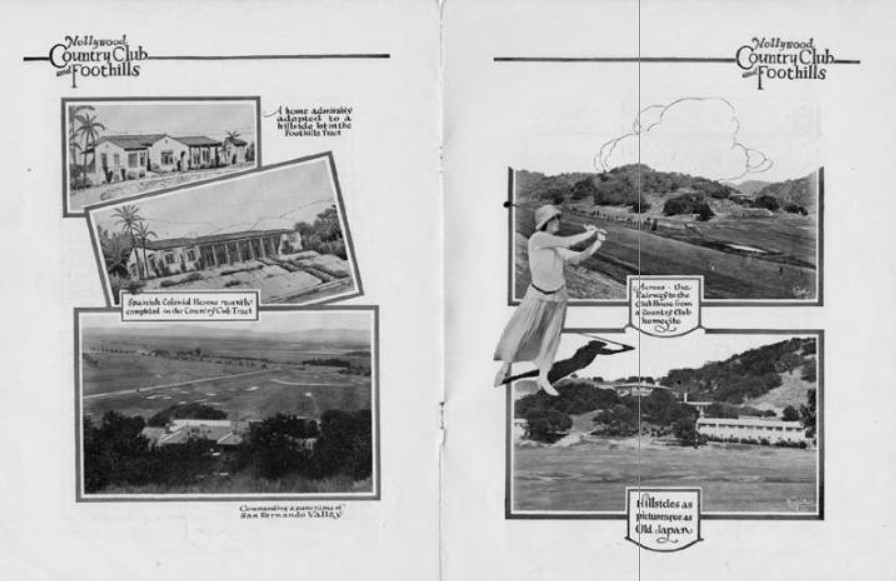 |
|
| (ca. 1925)^ - Brochure for the Hollywood Country Club and Foothills subdivisions in what is now Studio City. It is from the Merrick & Ruddick, Inc. Real Estate Company. |
Historical Notes In 1937, the Harvard School for Boys took over the closed country club.^ |
* * * * * |
Twin Lakes Park, Chatsworth
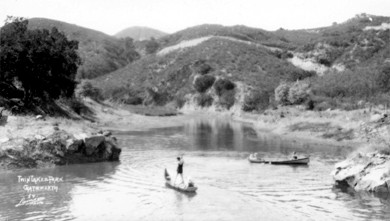 |
(ca. 1926)^ - One of the lakes in Twin Lakes Park, Chatsworth.
|
Historical Notes Twin Lakes was built as a resort around two man-made lakes circa 1920, in a canyon just above Chatsworth.^^^* |
 |
|
| (ca. 1920s)^^^* - View of several people in a boat in the middle of a lake at Twin Lakes Park. |
Historical Notes Twin Lakes Park was a privately owned planned community where one could buy a home, a mountain retreat, or a membership in the park (to use the facilities). In the 1920s and 1930s the community consisted of approximately 500 acre park, two fully stocked lakes, a country club, and picnic areas. There was room for 5,000 homes. Prices ranged from a one hundred dollar camp site to a twenty-five thousand dollar estate. Robert B. Stacy-Judd was the architect who designed and built the destinctive Mayan observation building on one of the lakes.^ |
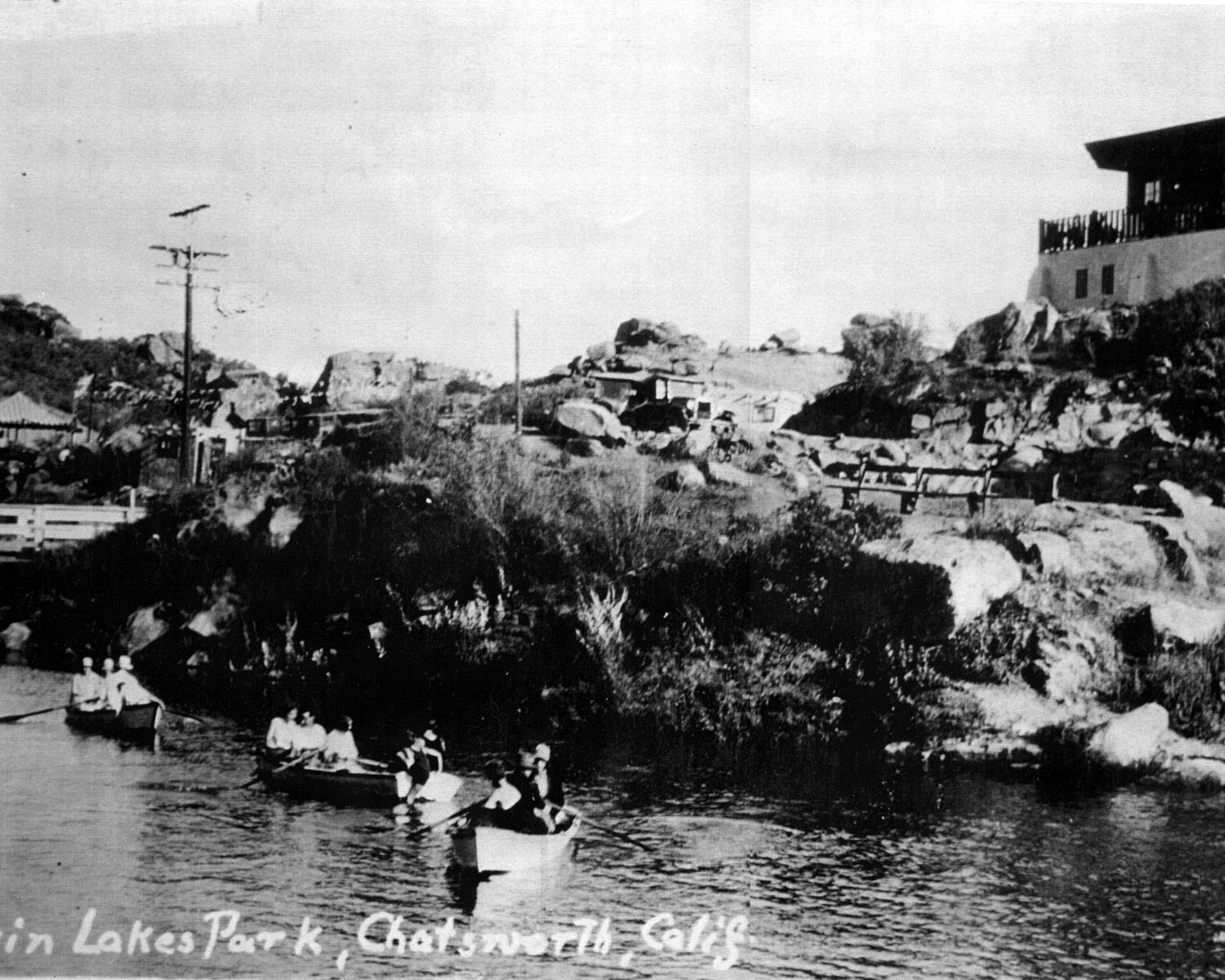 |
|
| (1920s)^# - View showing three boats filled with people in upper Twin Lakes. The Mayan Observation Building is at upper right and the dam with guardrail is at left. |
Historical Notes Promoted as a retreat for the weekend, season, or holiday, 750 lots were subdivided from the George W. Haight ranch, and somewhere between 400 to 500 parcels were sold in the 1920s.^# |
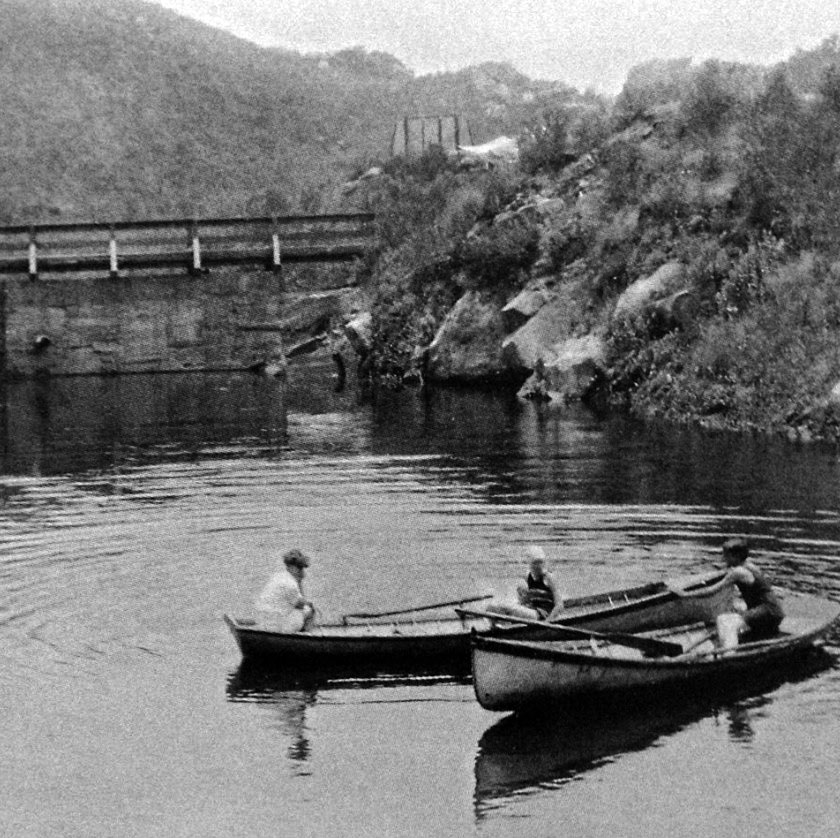 |
|
| (1930s)#^*^ - View showing three women in two row boats enjoying the day on one of the Twin Lakes located in Chatsworth. A dam is seen in the background. |
Historical Notes The upper lake dammed up Devil Canyon creek, and was named Raymond Lake in the sales brochure. George W. Haight’s son was named Raymond.^# |
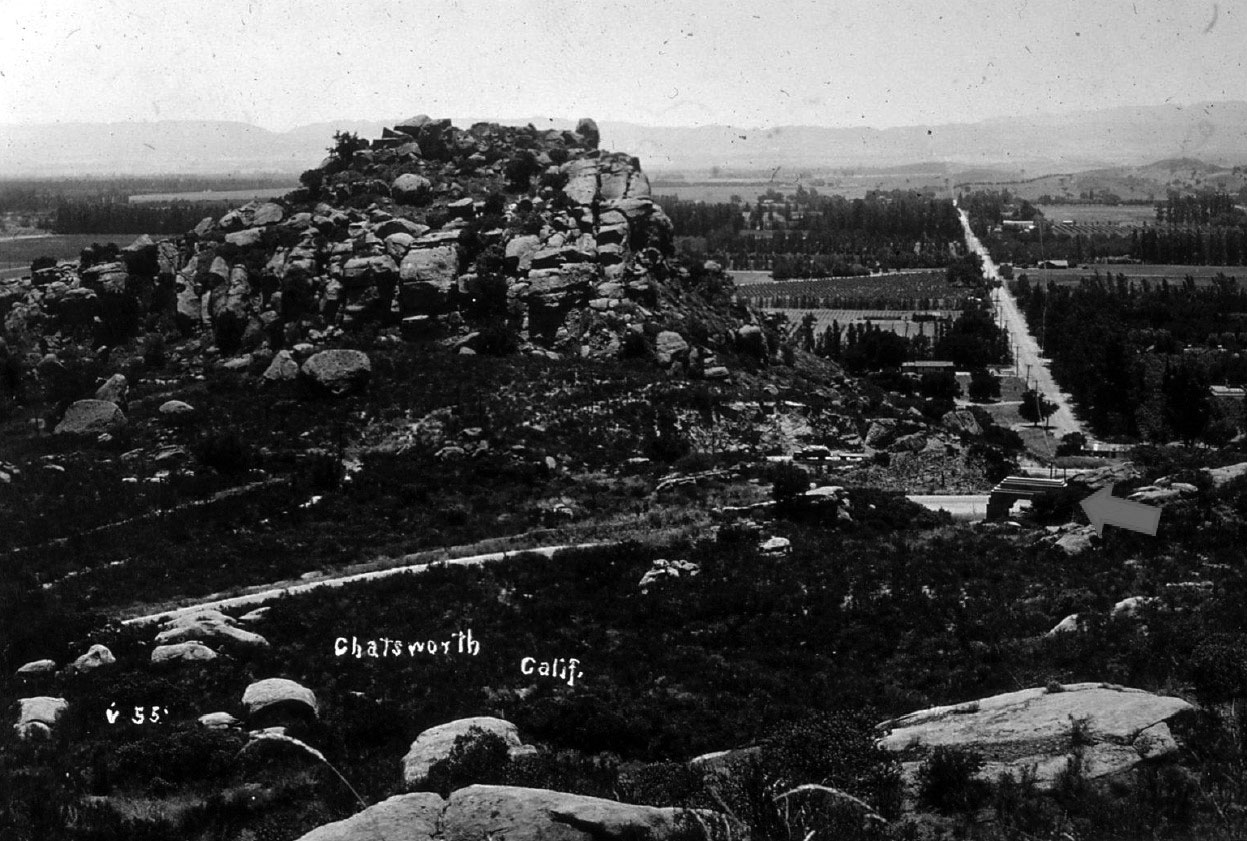 |
|
| (1933)^# - View of Stoney Point looking south. Twin Lakes Park Entrance Archway on Mayan Road is identified with an arrow at center-right. |
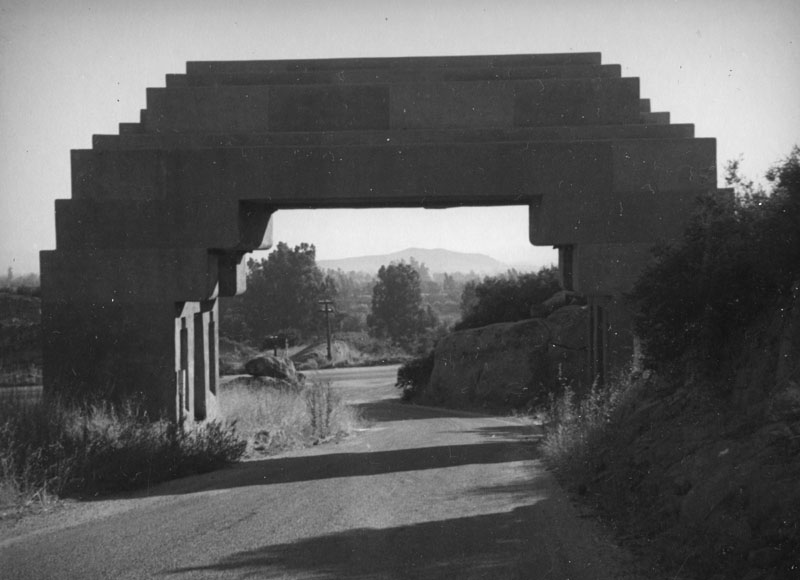 |
|
| (ca. 1937)* - Back view of the Twin Lakes Park Entrance Archway over Mayan Road, looking toward Santa Susana Pass Road. |
Historical Notes Mayan Road was accessible from Santa Susana Pass Road before the continuation of Topanga to the 118 freeway in the 1970’s.^# |
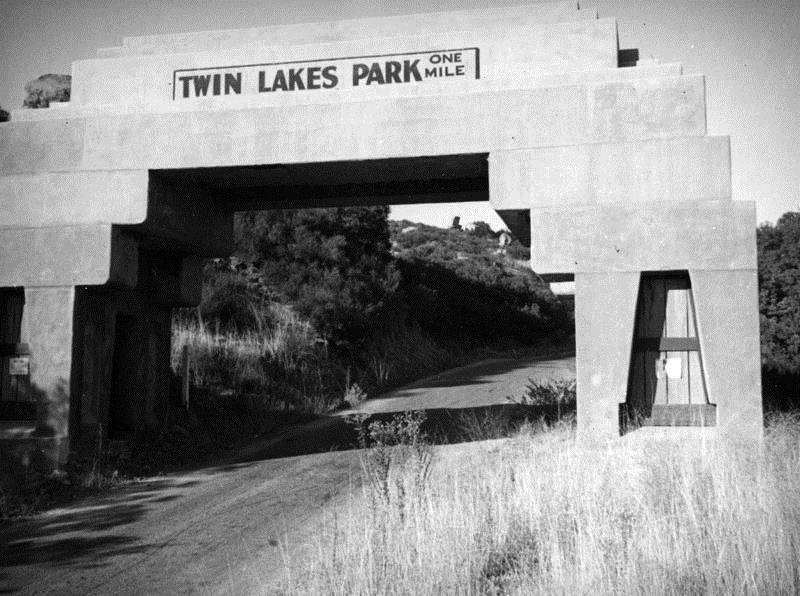 |
|
| (1937)^# - Front view of the Twin Lakes Park Entrance Archway, located 80 feet north of Santa Susana Pass Road. |
Historical Notes Remnants of the dams can still be found in the arroyos around the community of Twin Lakes, north of the Simi Valley Freeway between Topanga Canyon Boulevard and Canoga Avenue.* |
* * * * * |
Please Support Our CauseWater and Power Associates, Inc. is a non-profit, public service organization dedicated to preserving historical records and photos. Your generosity allows us to continue to disseminate knowledge of the rich and diverse multicultural history of the greater Los Angeles area; to serve as a resource of historical information; and to assist in the preservation of the city's historic records.
|
More Historical Early Views
Newest Additions
Early LA Buildings and City Views
History of Water and Electricity in Los Angeles
* * * * * |
References and Credits
* LA Public Library Image Archive
^ CSUN Oviatt Library Digital Archives
#^San Fernando Valley History Digital Library - CSUN Oviatt
** DWP - LA Public Library Image Archive
^* The Valley Observied: Street Name Origins; Timeline of Valley History
^# Chatsworth Historical Society
*# Mojave Desert.net: Remi Nadeau
***Los Angeles Historic - Cultural Monuments Listing
*^^Nuestra Señora la Reina de los Ángeles - losangelespast.com
*^*California Historical Landmarks Listing (Los Angeles)
^^^LA Times: Adohr Spelled Succes for the Adamsons; LA Times: Building the LA Aqueduct; Charles Weeks Colony
^^*LA Times: Stanley Norris Petit
*##LA Times: Dig Into History You'll Find Snake Oil..Victor Girard Kleinberger
*#*Project Restore: Van Nuys City Hall
^*^Topanga Canyon History - LA Magazine
*#^LA World Airports - History of Van Nuys Airport
^^#The Museum of the San Fernando Valley
**#Tumblr.com: LA History - Leonis Adobe
^#*Photo of the Northeast San Fernando Valley ca.1950 - Laurie Burns
^*#North Hollywood-Toluca Lake Patch: History of the Laurel Canyon and Valley Plaza Mall
#**California State Library Image Archive
#*^Northridgevision.org: Zelzah
#^#San Fernando Valley Blog: Porter Hotel; San Fernando Valley View from Topanga Cyn Drive; Charles Weeks Colony
^^^*San Fernando Valley Relics: valleyrelics.com: Twin Lakes; Universal Studios Tour Opening Day
**^*Retronaut - Hollywoodland Sign
**^^KCET: LA Flood of 1938: Cement the River's Future; When L.A.'s Most Famous Streets Were Dirt Roads
*^*^Canoga Park High School Home Page
*^*#Facebook.com: Classic Hollywood-Los Angeles-SFV
^^*#Topanga: Neighborhood Profile
^*#^Studiotour.com
*#^*Los Angeles County Library: City of San Fernando; 1920 San Fernando Valley View from Topanga Road; Topanga Mule Team
*#^#Forum.skyscraperpage.com: Tarzana LIbrary; Aerial of Burbank and Hollywoodland Sign; Girard Tour Map; Universal City
#*#*LA Curbed: How a Visionary Scoundrel Created Woodland Hills in the 1920s
#^#*Canyon News: Mulholland HIghway
^#^#Northridge Historical Images Virtual Tour - Bruce Russell
##^*Facebook.com: Canoga Park 100th Anniversary
*^^^San Fernando Valley Historic Society/Facebook.com: Girard; Sun Valley; Westinghouse Electric Range; Farmer in Early SFV; Garden of the Moon Park and Campground; Moon Festival
*^^# Flickr.com - Floyd B. Bariscale Photostream: Faith Bible Church
***# BoomCalifornia.com: Witness to a Hanging
+++# Facebook: San Fernando Valley Historical Society
^*^# Official 1913 LA Aqueduct Program: Shirley Gonzales, Morris D. Olney
#*** Pinterest - California and DailyBreeze.com
#^*^ Facebook.com: West San Fernando Valley Then And Now
#^^^ City of Calabasas: cityofcalabasas.com
#*^^ A History of the San Fernnando Valley: lahistoryarchive.org
##*^ Calisphere: University of California Image Archive
****#Entertainment Designer: The History of Universal Studios
***^#Daily News: Universal City Turns 100 Years Old
^^*^^Facebook.com: Garden of Allah Novels
^*^*^Facebook.com - Bizarre Los Angeles
*^ Wikipedia: Sherman Oaks; Isaac Van Nuys; Encino; Tarzana; Campo_de_Cahuenga; Cahuenga Pass; Chatsworth; Panorama City; Santa Susana Field Laboratory; North Hollywood; Canoga Park; Woodland Hills; Reseda; Orcutt Ranch; Granada Hills; Andrés Pico; Moses Sherman; Van Nuys; Henry Kaiser; Charles Maclay; San Fernando Valley; Mission Point; Hughes Aircraft; Domonique Amestoy; Winnetka, Los Angeles; City of San Fernando; Canoga Park High School; Ventura Freeway; Hollywood; Hollywood Freeway; Los Angeles Valley College; Bolton Hall; Sunland-Tujunga; City of San Fernando; Zelzah - Northridge; Rómulo Pico Adobe; Faith Bible Church; Universal City;; Tarzana; Calabasas; Hollywoodland Sign; Mulholland Drive/Highway; Lankershim Boulevard
< Back
Menu
- Home
- Mission
- Museum
- Major Efforts
- Recent Newsletters
- Historical Op Ed Pieces
- Board Officers and Directors
- Mulholland/McCarthy Service Awards
- Positions on Owens Valley and the City of Los Angeles Issues
- Legislative Positions on
Water Issues
- Legislative Positions on
Energy Issues
- Membership
- Contact Us
- Search Index